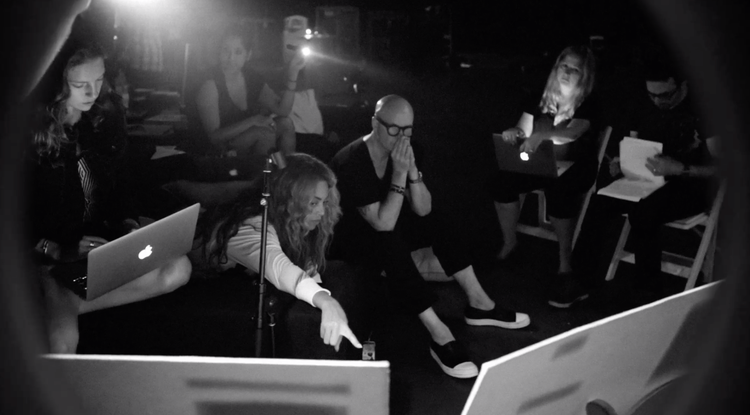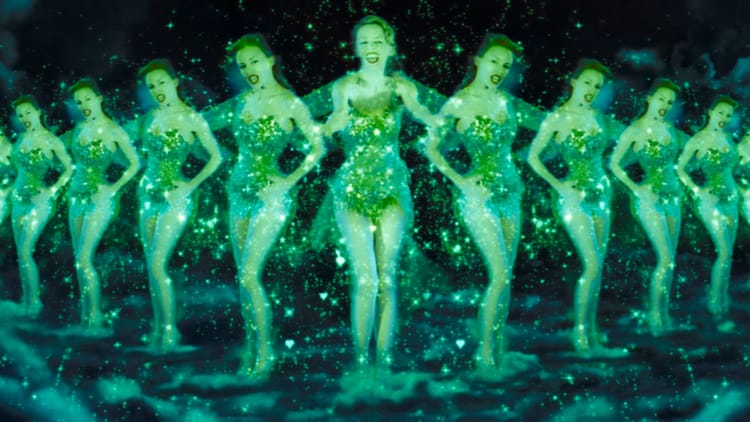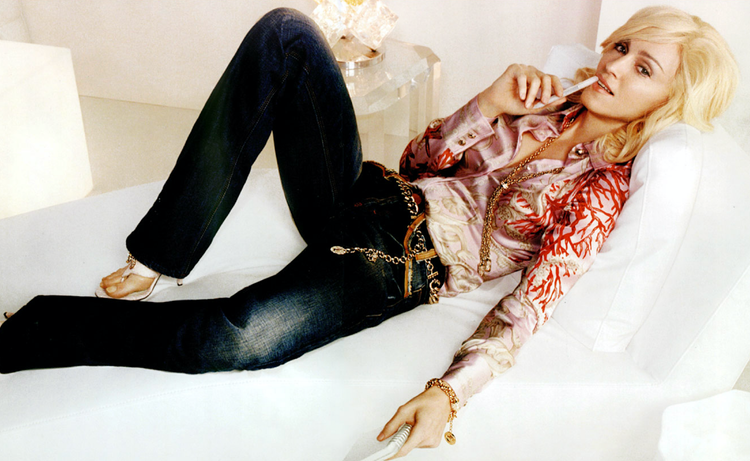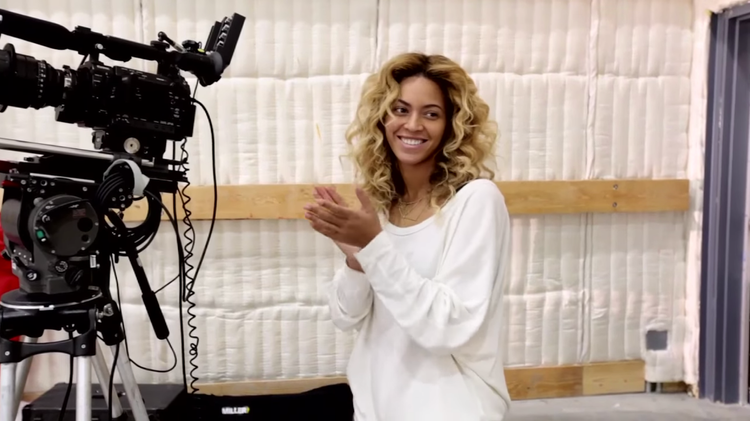A Moving-Image History of Parkwood Entertainment, Vol. III — The First Half
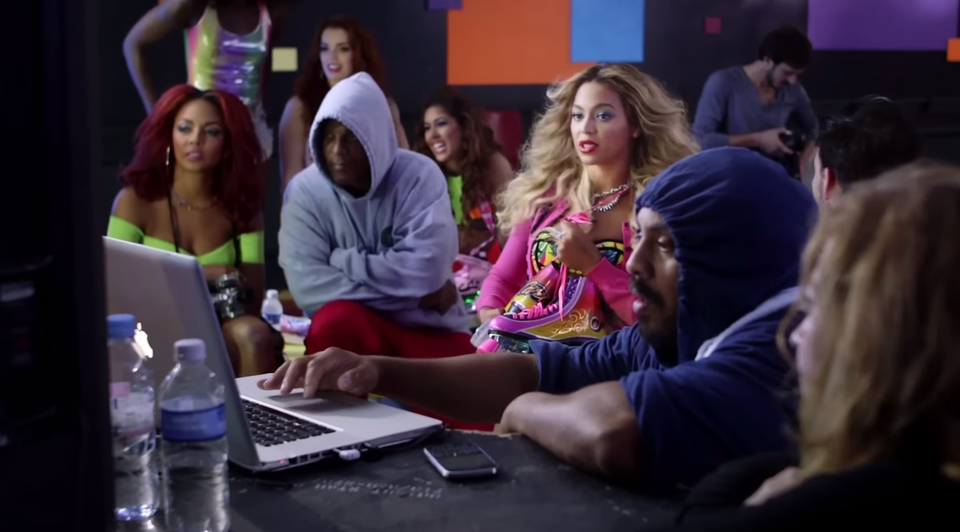
This is the third of a four-chapter series on Beyoncé’s Parkwood Entertainment and its extensive film output.
In this chapter, which has been split into two halves for a nicer reading experience (you have the first half open; here’s the second), we dive into the BEYONCÉ and Lemonade eras and their respective innovations. You’ll likely get the most out of it if you’ve read the previous pieces—my introduction, where I explained how this series came to be; the first chapter, where I traced the years leading up to Parkwood’s founding; and the second chapter, where I summarized the company’s early filmmaking adventures.
This project is being published for free, but please subscribe if you’d like to know about new chapters as soon as they drop. You can read more about this newsletter here.
As Blue Ivy Carter turned one, her mom seemed to come roaring back from “mat leave”—not that the term feels all that suited to Beyoncé, who’d spent those months performing a short residency, completing work on multiple films, and rounding up a who’s-who of writers and producers to make music in the Hamptons.
2013 began with what felt like a Beyoncé offensive, presumably because she was about to share some of that work with the world. In late January, she’d be performing “The Star-Spangled Banner” at Barack Obama’s second inauguration, and in February, she’d be headlining the Super Bowl halftime show—sponsored by Pepsi, her new partner in both business and “creative development.”
There was a decidedly patriotic bent to this comeback, and it was bolstered by the perfect pair of media placements. For American Vogue, the star was the picture of ’60s-inspired sophistication in a Streisand-esque beehive. And for GQ, she was a scantily-clad bombshell goofing around with football gear and a postpartum six-pack.
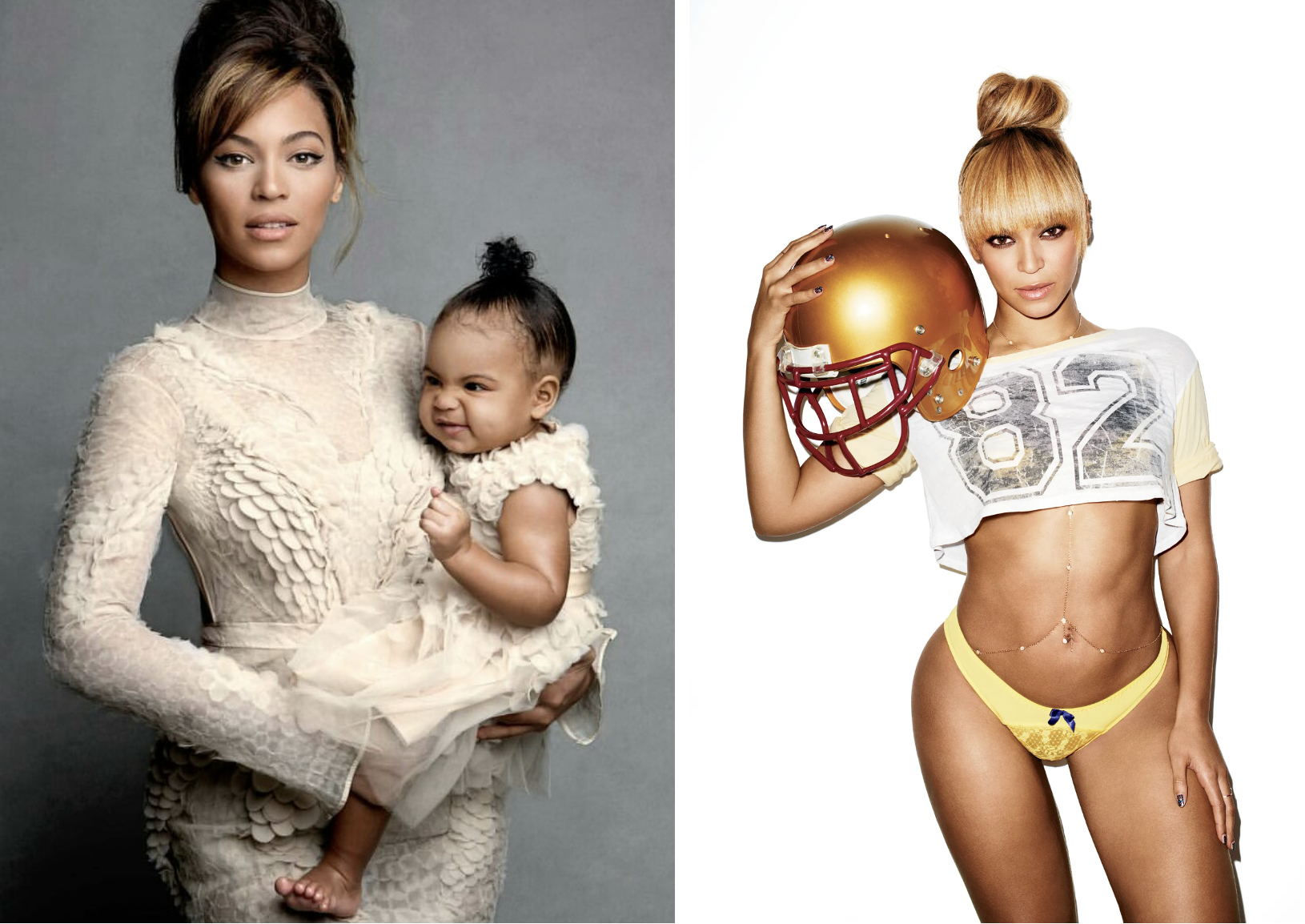
Here was an icon who could play muse to both Patrick Demarchelier and Terry Richardson just weeks apart—and in a world where neither photographer’s legacy had yet been sunk by sexual misconduct allegations, all that really meant was that she’d seemingly nailed every ideal of American womanhood at once. She was a beloved entertainer stately enough for Washington D.C., a CEO at the dawn of the Lean In (2013) era, and the hottest mom on the playground. If anyone had it all, to use a phrase extremely popular around then, it was probably Beyoncé Knowles-Carter.
“I worked so hard during my childhood to meet this goal: By the time I was 30 years old, I could do what I want,” she told GQ. “But I’ve sacrified a lot of things, and I’ve worked harder than probably anyone I know, at least in the music industry. So I just have to remind myself that I deserve it.”
As always, there was that word: sacrifice. “Beyoncé refers to the sacrifices she made when she was young,” wrote Vogue’s Jason Gay, “the thousands upon thousands of hours spent practicing and performing and accruing success and goodwill.” She was quoted as saying, “I can do what I want. I can say what I want … That’s why I’ve worked hard.”
Here she was gloriously reaping at 31, but she’d never let anyone forget about the sowing.
Though retrospectives have somewhat rewritten this fact, Beyoncé was forthcoming at the top of 2013 about being hard at work on a new album.
She spoke all about the writing camp she’d set up the previous summer; she not only named her collaborators (Pharrell, Timbaland, Justin Timberlake, etc.) but also their musical references (Prince, D’Angelo, ’60s doo-wop, etc.); she characterized her project-in-progress as “a lot more sensual … empowering,” explaining that motherhood had given her a new understanding of her body’s power. But as she told Vogue, “I still have things to figure out.”
There’d be plenty to talk about while she did that. For starters, every Beyoncé profile from the first half of the year contained an analogous line. As Jason Gay wrote, “An unmanned video camera has been set up on a table—there, as always, to record Beyoncé in the act of being Beyoncé.” As Jo Ellison would later put it in Vogue’s UK counterpart, “A video camera has been set up to film this interview as part of an exhaustive record she keeps of her every movement.”
These sentences had surely been included at all because of Amy Wallace’s GQ profile, which would age as a key Beyoncé cover story. Wallace notes early on that the star—sitting in a conference room at Parkwood Entertainment—doesn’t get up to greet her because “a video camera has already been aimed at [Beyoncé’s] face and turned on.” Though it’s unclear whether the journalist inquired about this or found it explained for her anyway, her subject indicated that their conversation was headed for her “crazy archive.”
As Wallace summarized this entity, which was her piece’s big scoop—unless you were one of the library science students who’d been sent Parkwood’s digital archivist posting in 2011—it was:
a temperature-controlled digital-storage facility that contains virtually every existing photograph of her … every interview she’s ever done; every video of every show she’s ever performed; every diary entry she’s ever recorded while looking into the unblinking eye of her laptop … Beyoncé’s inner sanctum also contains thousands of hours of private footage, compiled by a “visual director” [she] employs who has shot practically her every waking moment, up to sixteen hours a day, since 2005.
This “visual director” was Ed Burke, whom we met in Vol. I as Beyoncé’s new videographer and watched become her preferred directing partner over the course of Vol. II. There were a couple of shorts last time (Behind the Camera [2011] and The Making of a Concert [2012]) that suggested his role on the Parkwood team had expanded beyond videography, and this more fluid job title helped explain that.
A still-alive popular musician maintaining an archive isn’t necessarily unusual; just in the months that I spent tying this chapter up, I watched Céline Dion tour a documentary crew through a hangar of costumes and personal effects, and I read about the Victoria and Albert Museum curating an exhibition using pieces from Taylor Swift’s own collection.
The idea that there was a robust digital component to Beyoncé’s also made sense if you were someone who paid attention to her: she’d long been known to watch back old performances in the interest of outdoing them, her TV interviews were often scattered with photos and home videos going back to her childhood, and she’d demonstrated a particular affinity for the documentary format during her solo career—first as a subject/producer, then as a subject/producer/director.
In fact, if you’ve been following along with this story, only so much of the above GQ passage may strike you as new info. That Beyoncé had a videographer was something she’d previously made public, otherwise Steve Kroft wouldn’t have been able to discuss it in his 60 Minutes segment on her in 2010. That she vlogged on her MacBook was something she’d actively played up with her first two self-directed features (I Am… World Tour [2010] and Live at Roseland [2011]), but had implicitly admitted to as far back as the circa-2007 Beyoncé Experience documentary, when we first got the “Why did God give me this life?” monologue. And that same short had contained a montage of press interviews she’d made video copies of—which is to say, Beyoncé’s 2013 profilers weren’t by any means the first to encounter a camera during their sit-downs with her.
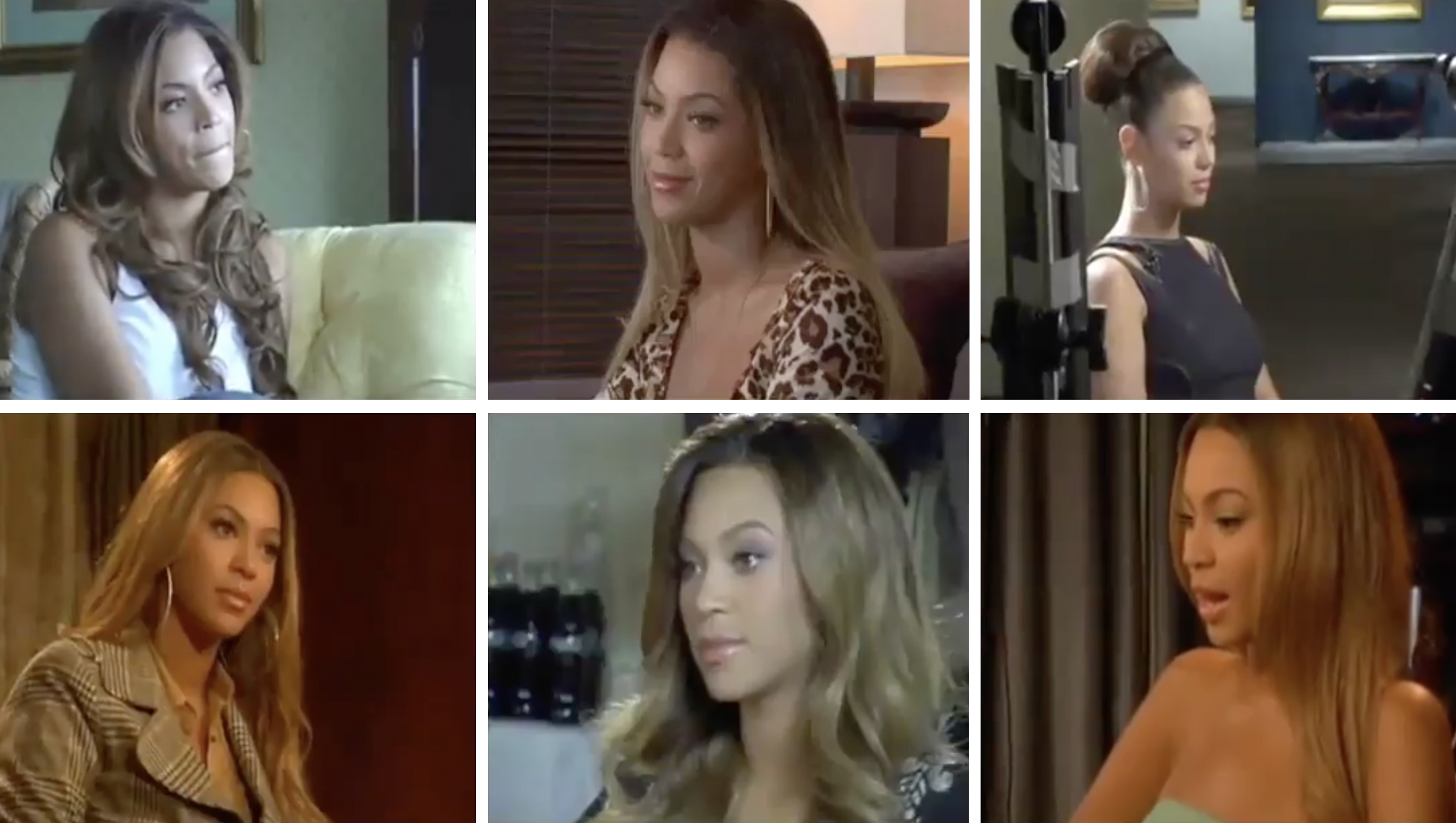
In short, she had an obvious and very logical reason to capture and care for so much visual material: she often used it, namely in her growing filmography. Aside from the words “crazy archive,” it’s easy to miss that the cover story contains just one direct quote about it from the star herself: “I can always say, ‘I want that interview I did for GQ,’ and we can find it.”
Despite that comment pointing to her archive’s practicality, however—and despite the longtime media practice and output summarized above—we spend a lot of the piece imagining other reasons why a superstar might compulsively document her life, ranging from the sentimental (“Anytime she wants to remind herself of all that work…”) to the commercial (“…the product that is Beyoncé is safe and sound and ready to be summoned—and monetized—at the push of a button”).
There was likely some validity to each of these theories, to be clear, and we’ll come back to them in time. But while Beyoncé the Budding Filmmaker is certainly gestured at in the profile, she’d overwhelmingly taken a backseat here to Beyoncé the Unparalleled Control Freak. And a main idea that I hope any reader of this series takes away is that these two roles aren’t just different hats sometimes worn by the same person; they’re intrinsically and necessarily connected.
It makes at least some sense, given all of this, how the internet reacted to the cover story, which conjures up the image of a woman squirreling away footage for slightly nebulous reasons despite her having specified a reason. “We’ve been busy trying to figure out why exactly the singer has a room dedicated to herself,” wrote the Huffington Post. “GQ Interview Confirms That Beyoncé Is Fucking Crazy and Exactly as You Imagine Her,” read Gawker’s headline.
Though the inauguration and the Super Bowl would both be professional triumphs for Beyoncé, each came with its own asterisk that didn’t exactly dispel the whole Unparalleled Control Freak thing.
Following her rendition of the national anthem, she was accused of lip-syncing by the U.S. Marine Band, her fellow performers. The star admitted that she’d sung along with a pre-recorded track, writing in a statement, “I am a perfectionist and one thing about me: I practice until my feet bleed. I did not have time to rehearse with the orchestra … I did not feel comfortable taking a risk.” Though she stressed that pre-recorded tracks are “common in the industry,” she opted for a final bit of damage control during her pre-Super Bowl press conference, performing “The Star-Spangled Banner” again for the room before cheekily asking, “Any questions?”
The halftime show itself—which had been teased with a combined four minutes of documentary footage, and introduced with a countdown spot produced by Parkwood—went off basically hitch-free. (It would later be nominated for three Primetime Creative Arts Emmys, with Beyoncé herself on the ballot for Outstanding Short-Format Live-Action Entertainment Program.) During the 13-minute showcase of her discography, she not only brought down the Mercedes-Benz Superdome with the surprise help of Destiny’s Child, she also forever changed one Canadian high-schooler’s life.
I debated making myself part of this story beyond including the odd aside about my research, and in the end decided to do so just with this chapter. Its timeframe matches the years that I started (2013) and graduated from (2017) an undergrad program in film, and my memories might be useful for examining how Beyoncé’s reputation among cinephiles—particularly academic ones—changed during those years.
Though her work had always been part of my life—we kept the Austin Powers in Goldmember (2002) soundtrack in the car when I was a kid, and I’ve spent a decade and a half unpacking the impression that “Telephone” (2010) left on me—it was really her halftime show that initiated me into my fandom proper. Here’s the most honest way of putting it: as a 17-year-old who’d had it with being a teenager and spent a lot of time dreaming about my impending womanhood, I was totally done in by the self-actualization fantasy that Beyoncé seemed to represent.
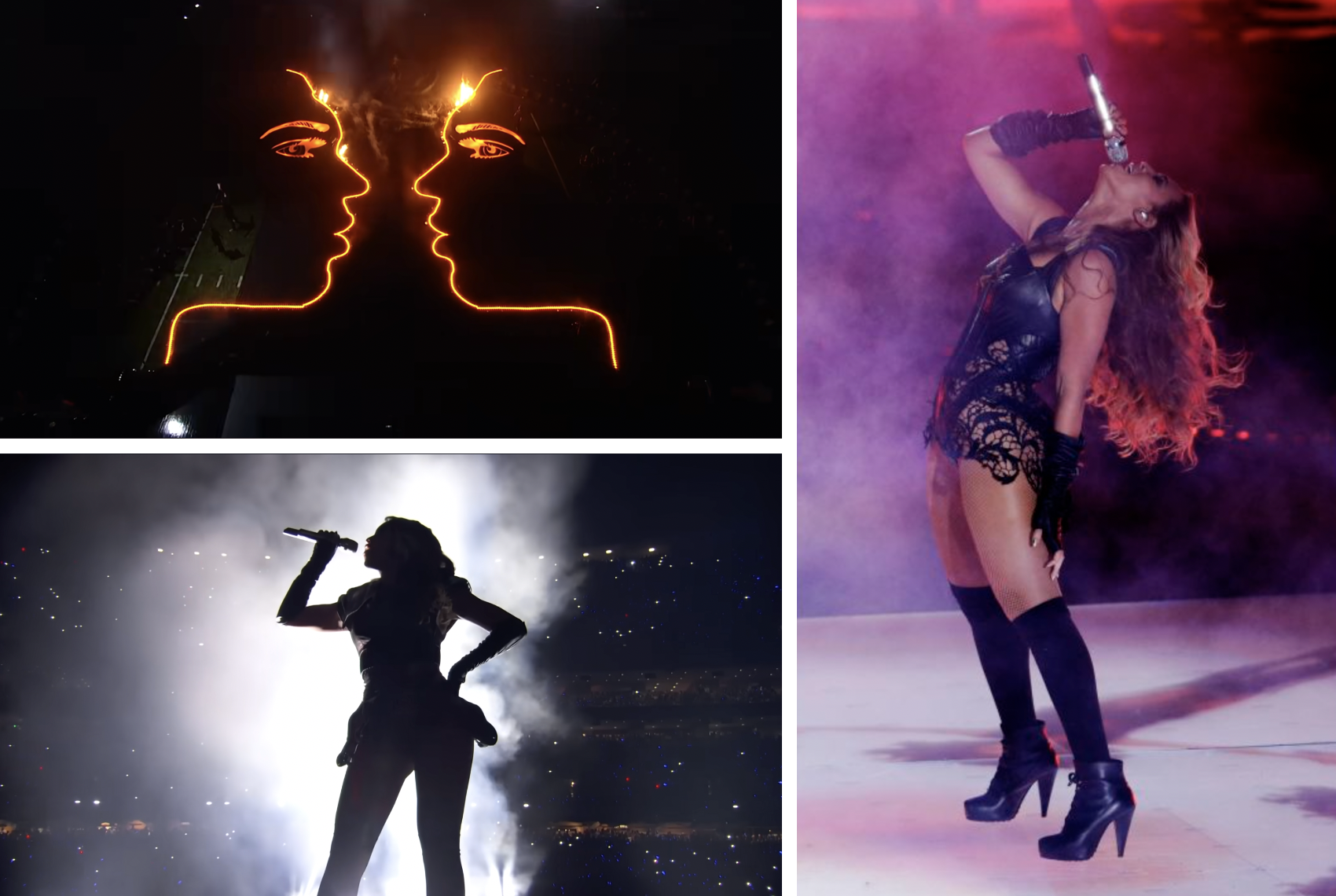
There was also something about the aesthetics of her halftime show that struck me as vaguely goth, in a way that I’ve historically had no defense against; I loved The Phantom of the Opera (2004), and My Chemical Romance’s “Helena” (2005) video, and Lady Gaga’s The Fame Monster (2009), and anything summarizable as “Victorian by way of Tim Burton.” There was the stage and lighting of Beyoncé’s set, all smoke and pyro and dark silhouetting—the performance’s sole Emmy win would be for Outstanding Lighting Design / Lighting Direction for a Variety Special—and then there was the black leather and lace of her costume(s), which had been inspired by screen legend Marlene Dietrich (making her second appearance in this story) as well as photographer Helmut Newton (making his first of multiple). And in hindsight, there was an inkling of the creative direction that her next two albums would take.
That evening, the star announced—in the form of a spot by “Telephone” director Jonas Åkerlund, another prophetic creative choice—that she’d soon embark on her Mrs. Carter Show World Tour. I quickly acquired two tickets to my first Beyoncé concert, spending the months around it doing my best to catch up on the decade of solo work I’d missed. 17-year-old me will largely step away now and return in December, but you can picture her ripping MP3 files off of YouTube in the meantime.
So now for the second asterisk: after the halftime show, Beyoncé’s forever-publicist, Yvette Noel-Schure, embroiled her in the ultimate Streisand effect scenario when she asked BuzzFeed to remove “some unflattering photos” they’d posted of the performance. The publication had a mean-spirited field day with the request, adding another controversy to the star’s recent case file, all related to what people saw as perfectionism at best and vanity at worst.
And regardless of how one stood, you could feel that her relationship with the press—and perhaps the public more generally, which proceeded to turn said “unflattering photos” into a memorable meme of the early 2010s—had become pretty frayed.
This made mid-February an especially charged moment to premiere Life Is But a Dream (2013), a documentary Beyoncé had co-directed with Ed Burke and fellow Parkwood colleague Ilan Benatar. (Benatar had edited and co-written Year of 4 [2011], and his directorial credit is separated out from B&B’s—that’s Beyoncé and Burke’s—in Life Is But a Dream, as if we might be meant to read it as secondary.)
“Those who aren’t yet suffering from Beyoncé fatigue may hit their limit,” wrote Vulture, “when HBO airs … a documentary about Beyoncé’s life, directed and executive-produced by noted Beyoncé expert Beyoncé.” Though this wasn’t her first self-directed feature, the weeks leading up to its release put far more strain on that detail than had been the case with either I Am… World Tour or Live at Roseland.
Heightening this sense of an impending disaster, Life Is But a Dream seemed immeasurably important to the star. She told journalists that she’d first begun work on it “maybe three and a half years ago”—so around when she first started talking about it in Vol. II—and there are signs in the film that she’d been editing it in her head for years, like all the audio and video she’d already squeezed somewhere into the previous half-decade of projects. The most galling example is probably the bit of speech that she’d first started using during the I Am… Sasha Fierce (2008) era, where she says she’s a human being who cries and gets scared just like everyone else.
But as if to prove that 2008/2013 sentiment, Beyoncé often got emotional while promoting the film. “This movie has healed me in so many ways,” she told Vogue before apologetically tearing up. “I’m very passionate about it, and it just feels good.”
Though it jumps freely around the star’s three decades, Life Is But a Dream is mostly about exorcizing 2011, the year that had begun with her firing her father as her manager and ended with her days away from giving birth. “I look back, and it was a difficult time,” she said around the release. “And it was the best lesson I’ve probably learned in ten years, in that one year. In the end I became a mother, which is the biggest accomplishment of my life.”
The narrative of the film, which trickled into its promotion, was that this Beyoncé—this wise, maternal figure who’d never been happier or more sure of her purpose—had been forged by everything the former Beyoncé survived.
In keeping with the style that B&B had been developing for years, Life Is But a Dream uses a central talking head—the star looking bare-faced and relaxed on a couch the previous summer, as interviewed by a faceless Ilan Benatar—to structure a bevy of material. We get the usual behind-the-scenes videography (some of it audibly filmed by Burke), years of vlogs and home videos that Beyoncé had been holding onto, and the odd performance number from her Back to Business shows at Revel the year prior. While we hear lots of her own music, the doc is officially soundtracked by a beautiful original score from Ben Salisbury (Ex Machina [2014], Annihilation [2018], Civil War [2024]), selections of which were among the many MP3 files that 17-year-old me illegally downloaded that year.
In Vol. II, we saw Beyoncé step up not only as a director of features but also an editor, learning how to use Final Cut Pro and publicly comparing the editing process to both doing a puzzle and birthing a baby. When Life Is But a Dream was coming out, Burke explained that she “was in the edit room fourteen to sixteen hours a day looking at all the footage”:
She goes through every piece of footage, which is nuts to me, but she spends the time and does it … she keeps a personal [video] diary on her computer. I think that’s kind of therapy for her and not for the public eye—but she gave us 44 minutes from these diaries. That’s what spurred the whole project, and we structured it from these diaries that were very raw, revealing, and honest.
Said vlogs are easily the most vulnerable that Beyoncé had ever shared with the public—and might still be these days—but they’re interesting to read at least partly through the lens that she knew she was making a documentary as she filmed them. “I have a passion for directing and editing,” she said at the premiere. “I’ve been doing it for years with my music videos and some of my specials, but it’s really a new art that I love.” As with all of her visual projects, Life Is But a Dream may contain fly-on-the-wall moments that you only really get from having a full-coverage videographer, but she also loudly draws attention to her authorial presence. At no point does the film really pretend to be cinéma vérité.
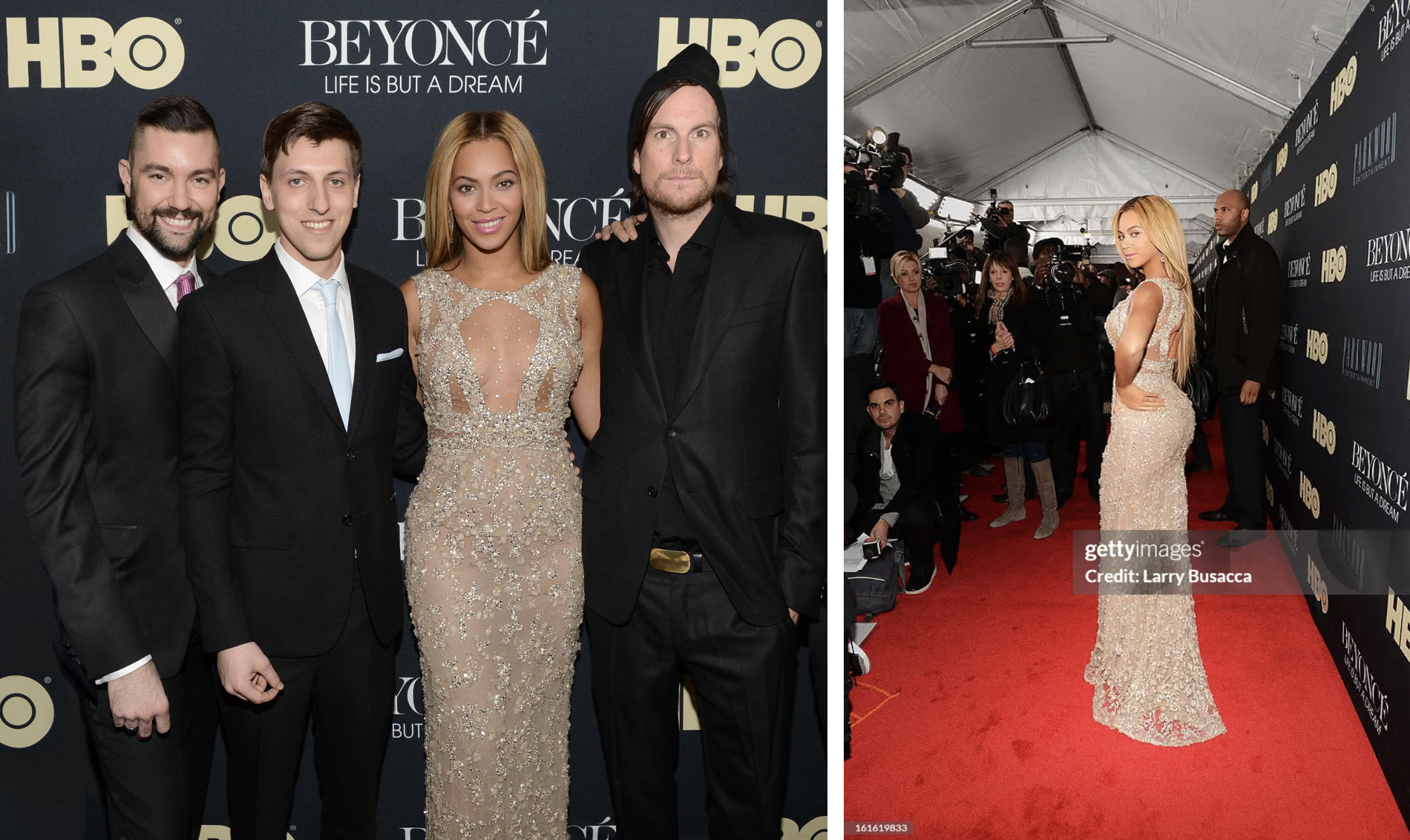
According to Lee Anne Callahan-Longo, who was then Parkwood’s general manager, the team initially thought of it as a theatrical release. “I had to go sell the film, so I had to go to Hollywood,” she’s explained. “When it all came down to it, HBO felt like the right home because they would embrace it for what it was.”
I mentioned in Vol. II that HBO’s Michael Lombardo had been skeptical at the prospect of programming a self-directed Beyoncé doc, but found himself “entranced” by it. “You feel the struggle of someone who has been handled for so long searching to find the part of her that she can disclose to the public,” he said:
That vulnerability of someone searching for the comfort place where they’re willing to be more than the image that has been fed to us. I was incredibly moved by that. Yeah, it’s a brand play, it’s an image play. It might be the most astute sort of self-packaging that we’ve ever seen. But I dare anybody to tune in and turn it off.
Backed by birdsong and children’s laughter, Life Is But a Dream—marked “A Beyoncé Knowles Film” in the opening credits—begins with long tracking shots of her childhood home at 3346 Parkwood Drive, the one her family was forced to sell amid financial struggles in the ’90s. Her narration comes in almost immediately as she reminisces about Houston—the moss on the trees, the summers spent running through sprinklers and having popsicles.
“And my dad knew that I needed his approval,” she says, adding some texture to this picturesque scene:
I think my father wouldn’t give it to me because he kept pushing me, and kept pushing me, and kept pushing me. Every time my dad pushed me, I got better and stronger. And that house just is my foundation … I’m still trying to learn that I don’t have to *kill* myself, and be so *hard* on myself, and be so *critical* … I can smell the roses. I don’t want to never be satisfied; I don’t think that’s a healthy way to live.
The picture then jumps to the same home in the ’80s, as filmed by Mathew Knowles on a video camera. “This is our dream house, we really love this one,” he explains for some future viewer, archiving the moment just as his eldest daughter will become notorious for doing. In the meantime, a tiny version of her—clad in a ruffled blue dress and white cowboy boots—hangs out on the front steps with her baby sister and their cousin, Ebony Rittenhouse.
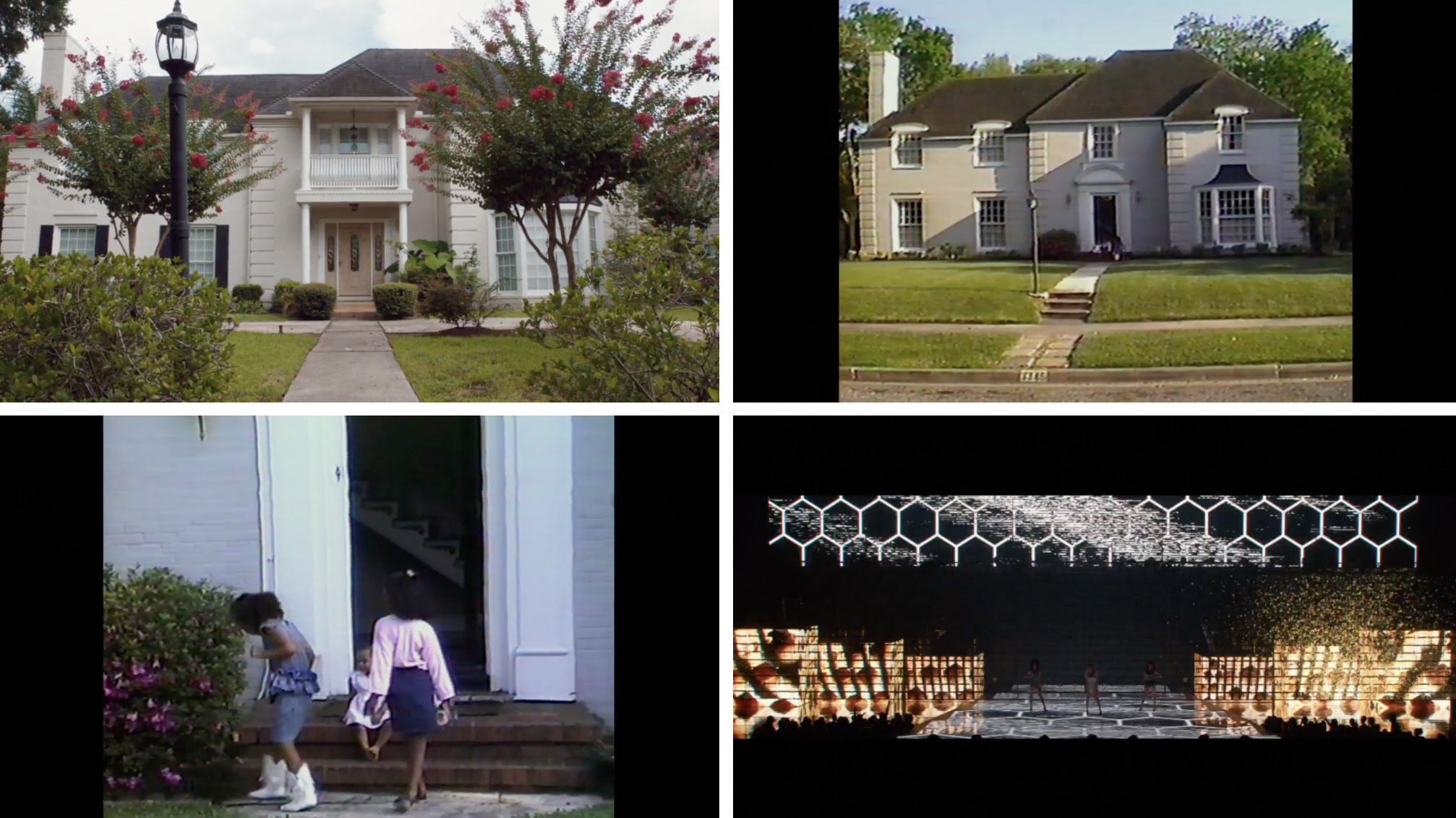
“Leave those bees alone, Beyoncé,” Mathew instructs as she inches too close to a flower bush. “I’m not messing with ‘em!” she fires back. And we cut from there to her adult self on the Revel stage in 2012, computer-generated bees appearing on her LED screens as an unnerving buzzing takes over the soundtrack.
Before the three-minute mark, Life Is But a Dream has been designated a film about someone breaking free from her father, spiritually as much as professionally. Already, we’ve been told that he was crucial in shaping her drive growing up, and—not but—that she sometimes struggles with his daddy lessons.
In Year of 4, Beyoncé had suggested that she fired her father so she could more freely make music about certain things, and because she’d long dreamed of overseeing her own empire. Life Is But a Dream doesn’t cancel that version of events out, but it adds a new and much sadder layer to the story: that Mathew “needed boundaries,” and so she erected them herself in order to salvage their relationship, only to find that the opposite happened.
“I had to sacrifice my relationship with my dad,” she explains. “It was a stressful, sad, difficult time.” And in yet another pointed edit, the next thing we see is Beyoncé rehearsing “Listen”—the Dreamgirls (2006) song through which Deena Jones finally stands up to her overbearing manager/husband, Curtis—ahead of a performance on The Oprah Winfrey Show.
“I was really, really careful about the editing and making sure it was told in an elegant way,” Beyoncé said of the documentary. “At the end of the day, it’s a story about a woman, overcoming the struggles and keeping on trucking—accepting the things you can’t control.” However honest one finds its writing, there are many such moments where Life Is But a Dream opts to show something rather than tell it—an idea that’ll follow us throughout the releases in this chapter.

In a vlog recorded in Paris in the spring of 2011, the star explains that she brought her nephew, Julez, there for some quality time with his dad, who was by that point no longer with Solange. “This is a time where your memories really, really stick with you for the rest of your life,” a sad Beyoncé tells her laptop.
The home video chosen to illustrate this comment, however enigmatically, comes from the same day that Mathew told her to leave the bees alone. As she races Ebony in what seems to be Parkwood Park, a green space just steps from the Knowles family home, her father can’t help but imply just for the camera’s benefit how much faster his own child can run.
Pop documentaries, especially those of the 2010s and 2020s so far, often take some bumpier chapter of a star’s life and smooth those bumps out as best as possible so that they can move forward with their next chapter. And as discussed in Vol. II, the 4 era had been atypically messy for Beyoncé, plagued by things like leaks and inconvenient/upsetting headlines.
Few films, however, go about this sort of brand control with the unblinking eye towards the future that Life Is But a Dream has. Virtually every anecdote shared in the film comes with an attendant mission statement, and every mission statement would foreshadow something about the next decade or so of Beyoncé’s career.
Take, for instance, how it looks back at the creation and rollout of her fourth album. We’d gotten an abridged rendition of that story in Year of 4, and some of the same material is reused here, but Life Is But a Dream gets to be significantly more honest about what was happening behind the scenes—in a way that might elicit increased sympathy towards 4 if you’ve gone in as a detractor. If the narrative of Year of 4 was that Beyoncé was newly managing herself and thus releasing her freest music yet, the narrative of Life Is But a Dream isn’t quite so romantic.
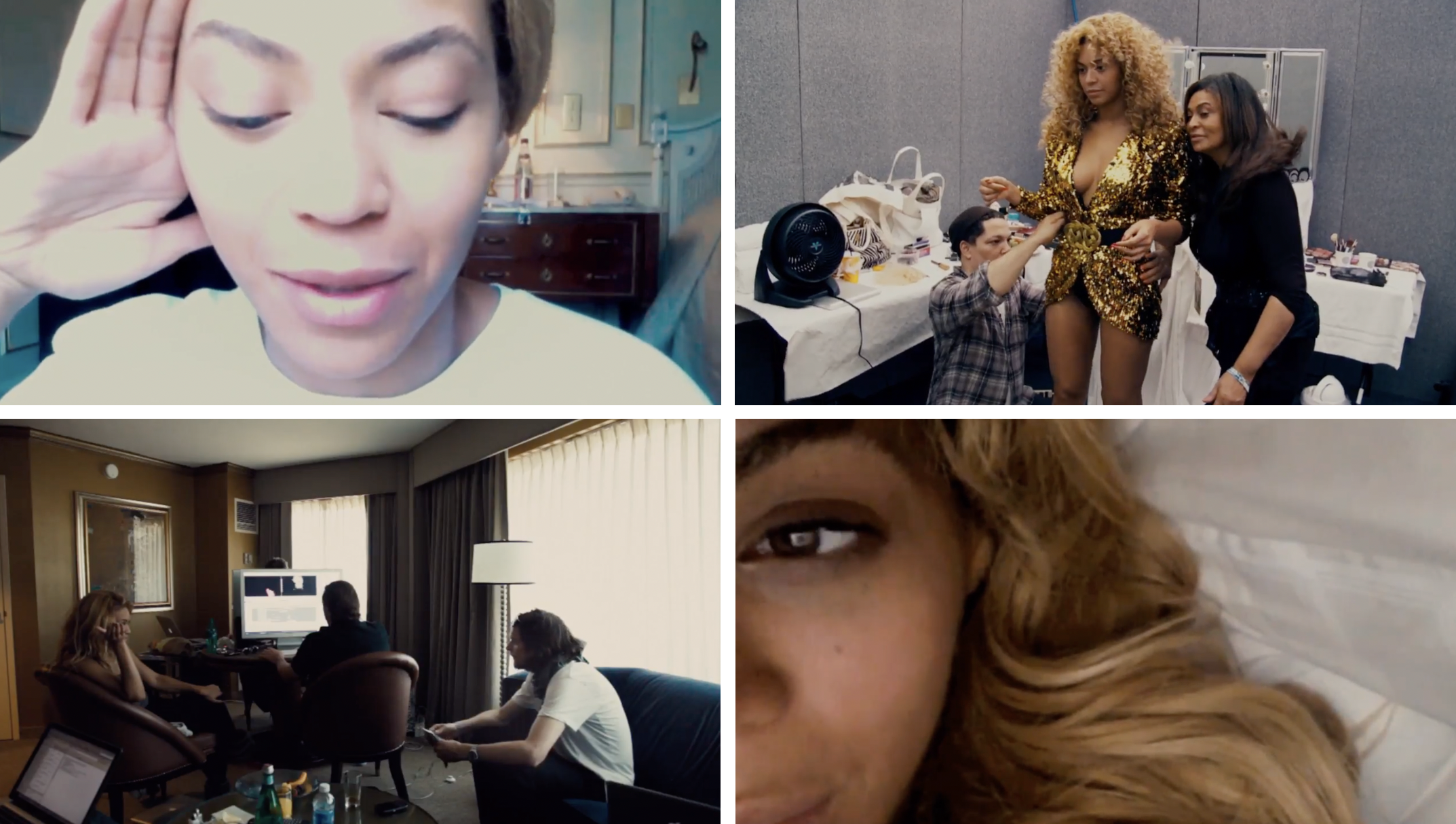
Now, Beyoncé is newly managing herself amid familial tumult, releasing an R&B album in an EDM-saturated market favouring singles, and navigating both things while trying not to puke from pregnancy hormones. Revisiting these months provides opportunities for her to sermonize—about the gossip industry, about women’s empowerment, about her musicianship, and so forth. Since 2013, the clip that’s circulated online like no other is the one where she tells Ilan Benatar:
It’s tough for the music industry … I’m an artist that tours, I’m an artist that makes albums. People don’t make albums anymore … They just try to sell a bunch of little quick singles, and they burn out, and they put out a new one, and they burn out, and they put out a new one. People don’t even listen to a body of work anymore.
Beyoncé is officially talking about 4, but again, she’s delivering this criticism in the summer of 2012, when she’s in fact hard at work on her unreleased fifth album. Life Is But a Dream is chock-full of moments like this one—People don’t even listen to a body of work anymore—that read in hindsight like warning shots, as if she was publicly mapping out her future as much as she was trying to make sense of her past.
In the same vein, the film seemingly captures a decisive period as far as her relationship with the public went.
Early on, Beyoncé tells us through a vlog that a pregnancy test has just deemed her “with child.” Then, in her 2012 talking head, there’s a tinge of fear that comes through as she remembers the weeks after this discovery. She says that she wanted to scream her good news at the top of her lungs but had to wait until things were “safe,” and she indicates that she visited her doctor for reassurance that it was okay to move ahead with her album rollout.
We later learn that this is because she’d been given reason to temper her excitement. Through another vlog delivered in late 2011—she’s now very pregnant with Blue—she explains that she was first expecting a baby “about two years ago,” telling her family and picking out names before the heartbeat was suddenly undetectable at a routine checkup. We then get a snippet of a never-released song that the star says was the first she recorded for what became 4, which plays over footage of her alone in the studio. “You took the life right out of me,” she sings. “I’m so unlucky, I can’t breathe.”
This backstory makes it all the more jubilant when Beyoncé gets to reveal her healthy pregnancy at the 2011 VMAs. It also makes it all the more heartbreaking when, a month and a half later, a rumour spreads that she’s not truly pregnant—secretly wearing a prosthetic bump and hiring a surrogate to “maintain her body,” as we hear Wendy Williams say in a stretch of audio. “To think that I would be that vain,” the star reacts in her vlog. “And especially after losing a child, the pain and trauma from that, it just makes it mean so much more to get an opportunity to bring life into the world.”
The rumour had come even after Beyoncé was photographed with her bump out in Croatia; it was always ridiculous. Even so, one wonders whether it factored into her decision to include so much additional “proof” of her pregnancy in Life Is But a Dream, silly as this sentence feels to type: we’re treated to Blue’s sonogram (emotionally soundtracked by this second baby’s heartbeat), and there’s even home-video footage of the Carters in the delivery room.
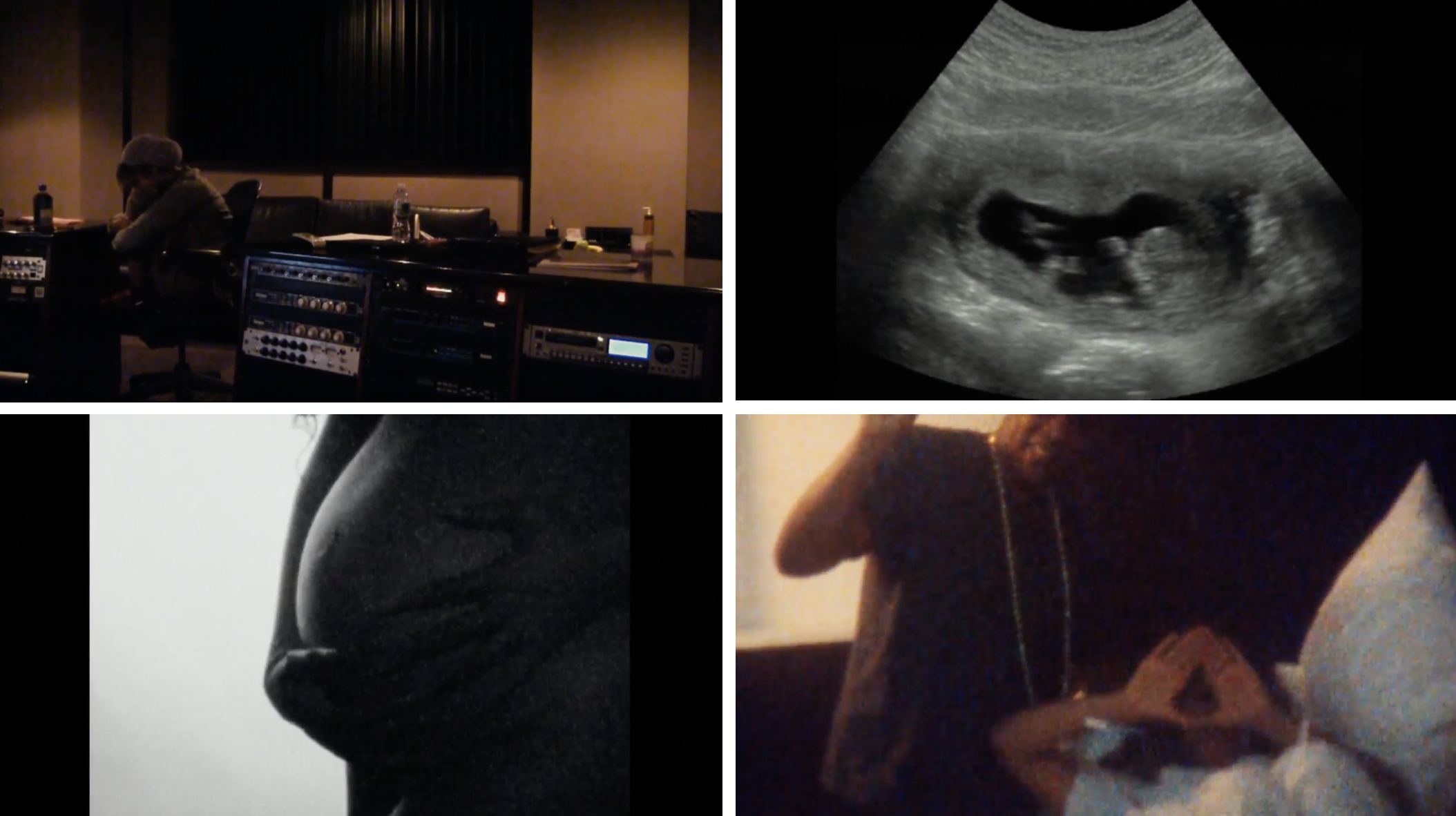
Maybe the star had always hoped to include material so intimate in her film. But maybe it also padded her case for what she planned on doing in the years after its release, which was become elusive to an unforeseen degree. “It just seems like people should have boundaries,” she says. “There’s certain things that you just shouldn’t play around with, and a child… you don’t play around with that.” This scene went viral on X as I chipped away at this chapter, where many comments cited it as probable last straw for Beyoncé the game public figure; everyone had blown it, and she’d once again have to create her own boundaries.
There’s another conspicuous bit of editing during this sequence. We cut from Beyoncé’s vlog about the hurtful rumour to her Revel performance of “Resentment,” a song from B’Day (2006) about struggling to bounce back from a partner’s breach of fidelity. “Just can’t seem to get over / The way you hurt me,” she sings, the lyrics now seemingly directed at us alongside her man. “As much as I wanna trust you / I know it ain’t the same.”
(An instrumental version of the same song had actually soundtracked the montage of press interviews included in the Beyoncé Experience documentary; when I say that there are signs in Life Is But a Dream that she’d been directing it in her head for years, this is the sort of thing I mean.)
As is typical for a Beyoncé doc, the most unfettered access we’re given is to her work ethic. The film spotlights the lead-up to two performances she had to carry out while pregnant: “Run the World (Girls)” at the Billboard Awards in May of 2011, and the ITV special A Night with Beyoncé, which was filmed that July but not aired until December.
We check a lot of the usual boxes in these sequences: rest is hard to come by, the star isn’t happy with how things are looking, crew members are taking their stress out on each other, and the clock is ticking. While Beyoncé gets her hair done for ITV, she explains to Ed Burke that although she’s the “calmest, most confident person,” she still has to manage all the “panicking and hyper and over-stressed” stakeholders around her. “Maybe you’ve realized that all you need is you,” he offers from behind the camera, but she immediately shakes her head: “All I need is not me because I can’t do it by myself.”
After the Billboard Awards, we also get a private moment between the Carters on a yacht, where Beyoncé tells her husband—doubling here as her videographer—“Everything that we work for is right here,” before jumping into the ocean. The moment doesn’t seem to have necessarily taken place in May of 2011; what matters is that we’re given some sort of payoff, narratively, after all the hard work we’ve just witnessed.
Despite this, Life Is But a Dream does something new for the star’s docs, though Year of 4 had certainly helped pave the way for it: Beyoncé’s professional reaping—not just her art, but her actual career success—is grounded as more of a collective win for women than we’d really seen before.
Though the star had long made what you might call empowerment anthems—her music had ruffled feathers for that reason since Destiny’s Child—her brand was becoming increasingly feminist, though she wasn’t yet comfortably using that word. In the early 2010s, there was a journalistic trend of asking celebrities whether they identified with the movement, and Beyoncé had expressed some trepidation while promoting 4. “I need to find a catchy new word for ‘feminism,’ right? Like ‘bootylicious,’” she joked.
Still, she’d recognized by her 2013 film that women were simply up against different things, including at work. Though Sheryl Sandberg’s Lean In wouldn’t be published for a month, the ethos that Beyoncé lays out in Life Is But a Dream is very much aligned with the author/executive’s (and Sandberg will return later in this chapter as if to help prove as much). Both texts are more about encouraging women to stand up for themselves in the face of structural inequality than, say, doing away with the structure—selling “female empowerment through personal perseverance,” as Emily J. Lordi has written of the two’s synergy.
“Nobody knew I was pregnant during that performance,” Beyoncé says of the Billboard Awards:
And I’m cool with that; I’m not interested in a free ride. But it absolutely proved to me that women have to work much harder to make it in this world. It really pisses me off that women don’t get the same opportunities as men do—or money, for that matter, because let’s face it: money gives men the power to run the show. It gives men the power to define our values, and to define what’s sexy and what’s feminine. And that’s bullshit. At the end of the day, it’s not about equal rights, it’s about how we think. We have to reshape our own perception of how we view ourselves. We have to step up as women and take the lead, and reach as high as humanly possible.
This was, again, an extension of the philosophy she’d started laying out during the 4 era. The star seemed to see her role in the women’s movement as being one of its foremost girlbosses, bearing the children and getting back to business so that others might be inspired to do the same. But her actual public politics—beyond, of course, being a longtime and especially visible Democrat—seemed to be a work-in-progress, and the rest of 2013 would provide a real-time look at their evolution.

That Beyoncé voices her Women in the Workplace thoughts in Life Is But a Dream makes for a slight shift in feel during the film’s rehearsal segments. We suddenly notice that men tend to outnumber women in basically every professional setting except the stage itself. The star suggests in one talking head that she quickly realized upon launching her company that she was overly polite in business contexts. And whereas previous films had shown us her colleagues disappointing her because they were having a hard time understanding her wishes, we now see that they’re actually disregarding them.
During one meeting with the ITV crew ahead of her special, a dejected Beyoncé gives them her production notes. The concept for the set is white monochrome, from the costumes to the instruments to the stage, and she tells them that they’re nullifying all that creative direction in flashing red and purple lights on it.
After a dreadful silence, several crewmembers pipe up at once. “All-white, so we’ll go all-white,” one says.
“Okay,” the star responds, not bothering to hide her confusion. “I mean, I said that yesterday.”
A Night with Beyoncé had been produced “in association with” Parkwood rather than by Parkwood, and moments like this one seem to advocate for the company’s existence. The more Beyoncé could curate her professional environment, the easier she could do her job—and the less energy she’d have to waste, it seems, begging for basic respect.
In Life Is But a Dream, present-day footage of Beyoncé’s childhood home isn’t included as mere bonus material. The house is made into a sort of symbol, as if the star had mentally spent a lot of time there during her challenging year.
When she finally gives birth, we’re returned to that home and its surrounding neighbourhood. We begin this time at the front door, and back away from it as we travel to Parkwood Park, still looking just as it did in that ’80s footage where Beyoncé was racing her cousin. “My baby was born out of a conflict in my life, and that struggle had to be settled,” the new mom narrates, suggesting that she was meant to go “through the pain” and “down the path.”
The camera pulls in on, then pans up, the trunk of a massive tree. When we pan back down, the park has been taken over by electric-blue morning glory, which is to say blue ivy. The soundtrack again gives us the buzzing of bees, since there are now a bunch that seem to be thriving in the flowers’ presence—daughter propping up mother.
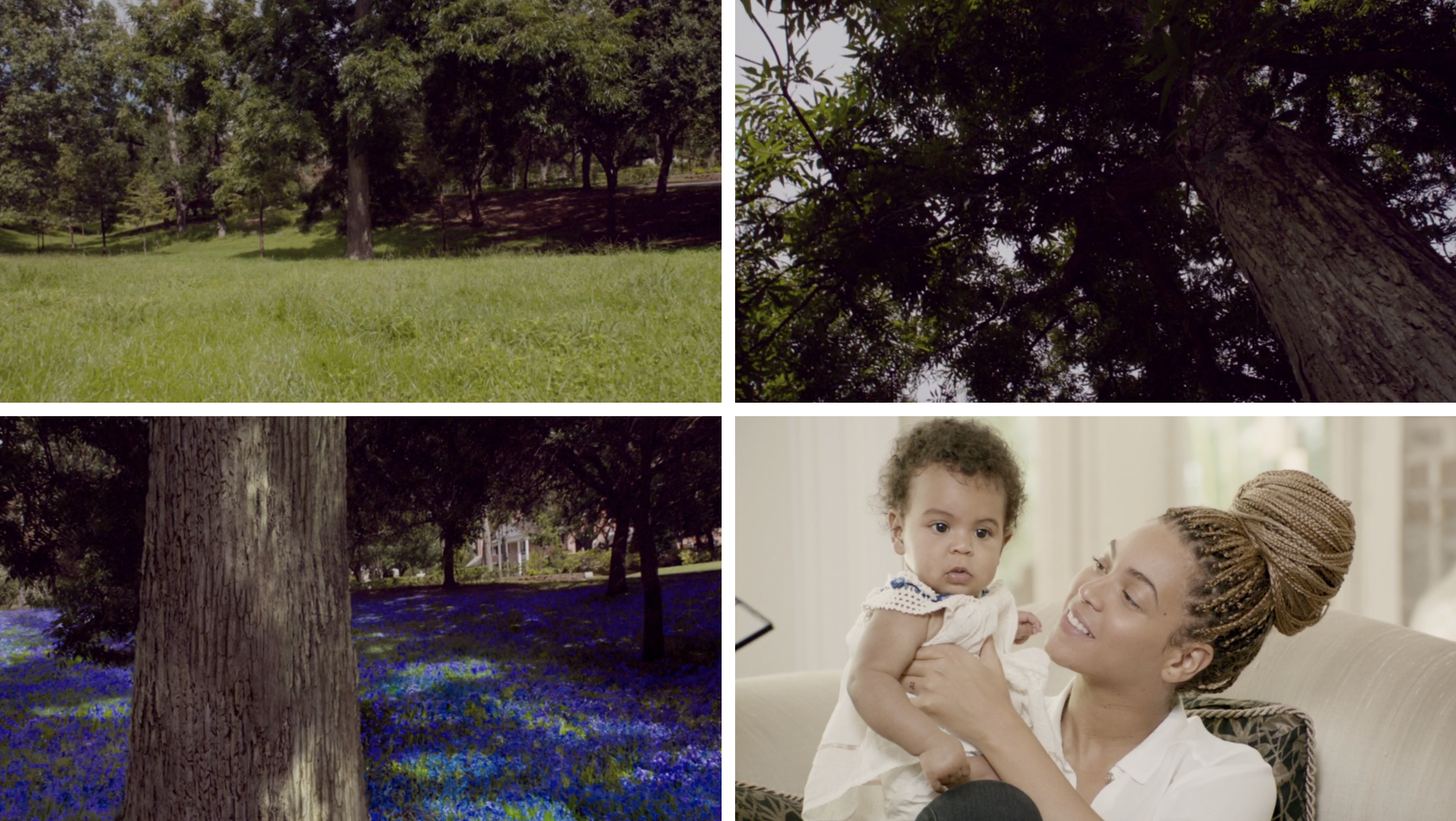
The film puts Blue forward as the tangible, cuddlable reward for all of this pain and uncertainty, and its editing makes her out to be a family unifier. Mathew is briefly shown cradling his newest grandchild, and—in a separate location, though it’s easy to miss that detail—Ms. Tina and her siblings gather around a big table to look through old photographs.
Crucially, this whole healing journey of Beyoncé’s had been refracted through the same house that she’d chosen to name her production company after in 2008. So if we hadn’t figured as much already, the word Parkwood clearly meant more to her than its mere trademark availability.
The critical response to Life Is But a Dream was mixed to negative. If you take in a bunch of writing about it back to back, you’ll get a slew of creative attempts at categorizing it—“film-length selfie,” “high-level propaganda piece,” “awkwardly assembled home video.” The words “vanity project” abound, as do mentions of the inauguration and the Super Bowl, which had seemingly helped create a general feeling of overexposure on Beyoncé’s part.
Ironically, though, the chief critical complaint was that this overexposed superstar hadn’t actually exposed much in her film. “There are views into Beyoncé’s life that feel personal mostly in the sense that a Tumblr photo blog is personal,” wrote Vulture. “You look at images, objects, and settings and triangulate a person who might be among them.” One of the more scathing reviews came from the New York Times, which deemed it a “gauzy, stylish and utterly opaque film that comes off less as an autobiography than a song-and-dance defense brief.” Many reviews criticized the elision of Mathew’s extramarital antics, to say nothing of his embezzlement allegation.
Even when this contemporaneous writing has aged well—and a lot of it has; my aim here isn’t to throw fellow critics under the bus—it often betrays a lack of fluency in its subject and her screen journey up until that point. Salon referred to “the camera crew [Beyoncé] has hired to interview her for this film,” though said crew were actually longtime colleagues at her production company. The Washington Post suggested that she’d had to resort to collage—one of her defining filmmaking quirks, even by this point—in the absence of any real story. The Times’s critic was seemingly totally unfamiliar with “Listen” from Dreamgirls, and got away with calling it “a song about the breach between father and daughter.”
For some critics, interestingly, Beyoncé’s involvement as co-director was akin to the film having gone director-free. “Having someone—anyone—empowered to say ‘Cut!’ would have been helpful,” argued Variety, as if she herself had not been precisely that someone. It’s a funny thing that people have long done with the star’s work, and in various mediums: criticize her authorship while managing to erase it.
“Beyoncé was said to be hurt and perplexed by the reviews,” writes J. Randy Taraborrelli in Becoming Beyoncé (2015), “and to this day doesn’t know what to make of them.” It’s hard to cast doubt on that particular claim of the biographer’s, especially after learning how much the doc had meant to her. “I have been anticipating this moment, and I am extremely proud,” she’d said at the premiere, visibly nervous. “This is huge for me.”
I’ve probably seen Life Is But a Dream a dozen times, with other comb-throughs for the odd piece of writing or meme. But two things struck me on my most recent viewing.
One is that I found myself unexpectedly weepy, which isn’t necessarily standard for me when I watch films—and I’d certainly never cried watching this one. Some of it was probably content-related: I don’t think I was either an aunt or a wife at the time of my last watch, and I not too long ago had the pleasure of holding someone’s “rainbow baby” after watching them struggle repeatedly with pregnancy loss.
But more generally, everything about the doc—every plot detail, every line of narration, every edit where Beyoncé shows something she’d rather not say—simply hit different in a year where I’ve spent so much time in the weeds of this story, with my brain extra tuned into every filmmaking decision. For any supposed faults, Life Is But a Dream is incredibly earnest, and it’s hard to overstate how big of a deal it was to receive some of its content from one of our most guarded public figures.

The second thing that struck me, though, was how well the film has aged. There are several things it was criticized for upon its release—its micromanaged nature, its subtle record-revising, its being so mediated through handheld devices—that are now par for the course in pop star docs. Most of the industry’s biggest names (and even many smaller ones) have since participated in a project that may owe something to it, whether stylistically or because there was a similar attempt to recast a “flop era” or trickier life episode through moments of pathos.
Beyoncé’s film was released early in the wave, years before streamers would put so much stock into the sub-genre that it felt like it might burn out. But probably more important, she made no bones about having shaped it, opening her up to a strain of critique that hasn’t generally applied to her peers’ projects. One of the richest but most overlooked bits of Life Is But a Dream, to my eyes, comes when the star slides elevator CCTV footage into a sequence of her arriving at a recording studio. Though it would become bizarrely ironic in time, it was a flex of her uniquely airtight control over her image; try surveilling Beyoncé better than she was already surveilling herself.
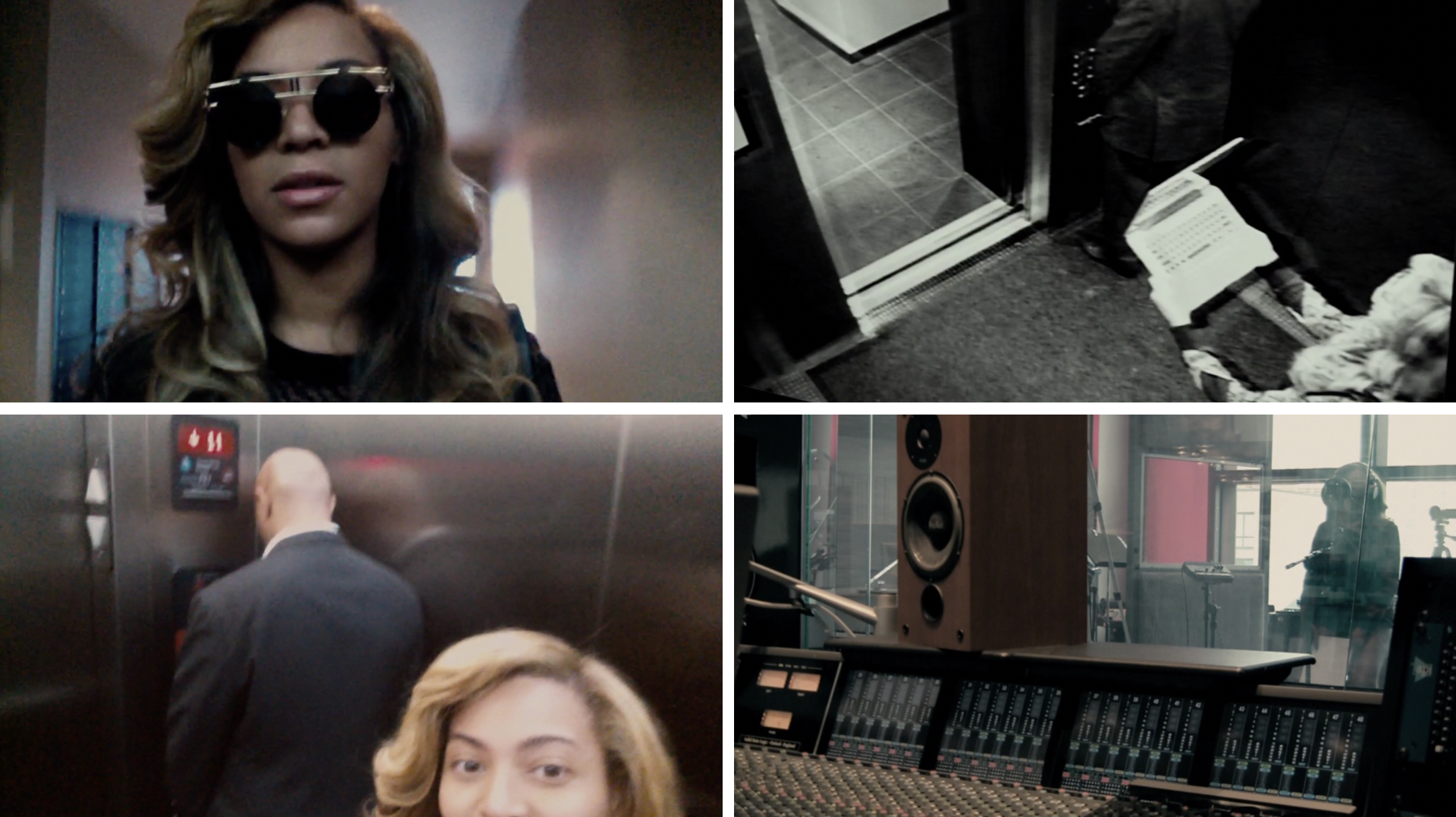
In her 2021 biography of the star, Tshepo Mokoena argues that the film was ahead of its time a second way, prefiguring various aspects of 2010s social media. “Though critics largely panned Life Is But a Dream, the film’s seeming obsession with fame and its subject’s relation to celebrity carries a salience to this day,” the author writes:
At the time, [the star’s] focus on herself seemed overblown, a sort of ridiculous exercise in puffery. But seen through the lens of a pervasive “selfie culture” that would follow, her hours of footage—some self-filmed on laptops … others collected by her staff—resemble the typical smartphone camera roll of anyone born after 1985. What might have appeared self-conscious or contrived in 2013 now looks like the average Instagram story, whether uploaded by a close friend or an influencer.
Lee Anne Callahan-Longo has remembered her boss telling the Parkwood team while working on her doc, “Don’t let me off. You are to question me, you are to challenge me. If you feel I’m not being honest, call me out on it.”
Beyoncé isn’t actively dishonest in the film so much as she’s elliptical and sometimes omissive: she Frankensteins audio and video in a way that casual viewers probably won’t notice, and she avoids certain topics altogether. The more tabloid-y Mathew stuff is only ever alluded to, we’re never told that her chaotic 2011 had culminated not just in a baby but also her parents’ divorce, and we don’t hear that the birth of said baby was itself mildly controversial.
J. Randy Taraborrelli finds the film’s level of journalistic integrity clear from its first frames, when the star speaks of her beloved Houston summers. “Of course, the most interesting aspect of the story behind this house isn’t the moss on the trees that surround it,” he writes, “it’s the fact that the family had to sell it rather than lose it at foreclosure since all of their money had been spent on furthering Beyoncé’s career.” In his book Ain’t I a Diva? (2019), Kevin Allred draws a more generous conclusion from Life Is But a Dream’s use of the Parkwood house, calling the film “a master class in sleight of hand”:
[Beyoncé] literally brings viewers up to the front door of her childhood home in the opening shots, but leaves that door closed, even as she offers vulnerable and intimate behind-the-scenes snippets. All the while, the door serves as a symbolic boundary; it never opens. Those private moments are carefully curated and the audience returns to and moves back from that still-closed door at the end of the film, reminding everyone to respect the barrier between Beyoncé’s private and public selves.
There may be a number of things that she isn’t willing to address in any meaningful-to-us way in Life Is But a Dream. But it’s equally true that she was far past the point of keeping them a secret; it probably says something that her specific narrative omissions come up in just about every review of the film.
Two months after the HBO premiere, Beyoncé kicked off her Mrs. Carter Show World Tour, its title a source of more controversy. Given that it wasn’t technically her name—she was legally “Beyoncé Knowles-Carter,” and still opting for “Beyoncé Knowles” for the odd film project when she wasn’t simply mononymous—it seemed as if she’d gone out of her way to brand herself as her husband’s wife.
“That word can be very extreme,” she replied when asked again about feminism for British Vogue. “I guess I am a modern-day feminist. I do believe in equality … But I’m happily married. I love my husband. I feel like Mrs. Carter is who I am, but more bold and more fearless than I’ve ever been.” Still, there was evidence that the title was meant to be read as something of a persona: in an H&M spot released that spring, again directed by Jonas Åkerlund, it was billed as a character she was playing.
The Mrs. Carter Show would serve as a bridge between 4 and whatever Beyoncé’s next album was set to be. About half of the initial setlist consisted of songs she’d released since her last world tour, so mostly from her fourth project, plus surprises like “Bitter Sweet Symphony” mixed into “If I Were a Boy” and “I Will Always Love You”—a tribute to the late Whitney Houston—mixed into “Halo.” (Eventually, she’d also get 4 muse Fela Kuti in there.)
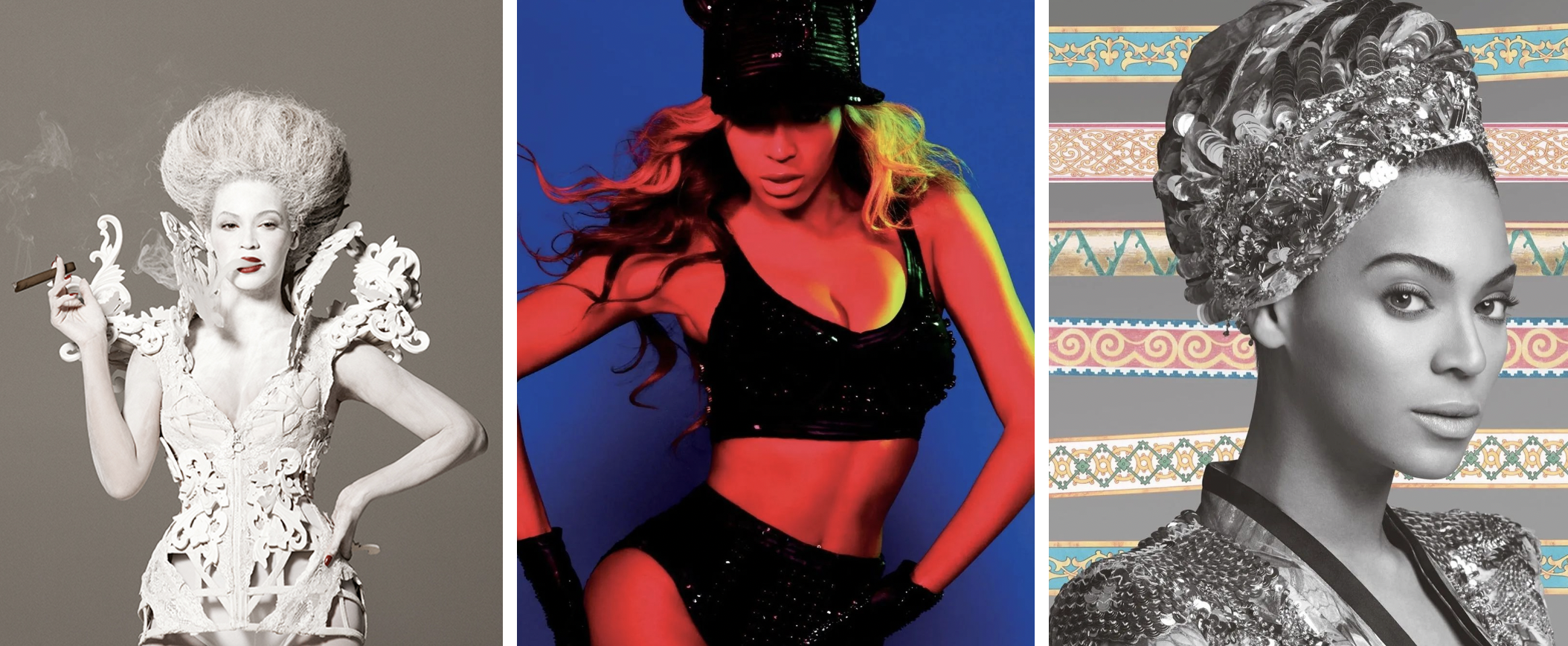
According to my tour book, the video content had been jointly creative directed by Ed Burke and Melina Matsoukas, who, in an extension of Åkerlund’s Mrs. Carter Show spot from February, largely ran with the idea of Beyoncé as the reigning Queen Bey. The book, not unlike what was shown onscreen, presented an eclectic mix of her in various Elizabethan-meets-Gothic looks, recreations of Helmut Newton photographs, and the occasional Africa-inspired image.
From the beginning of the tour, short doc segments were also uploaded regularly to YouTube, a new approach to behind-the-scenes material for a new decade of touring. Through these, you could experience a day in the life of one of Beyoncé’s crewmembers; you could hear her team pray for her following a tonsilitis diagnosis in Croatia; you could watch her fearlessly rappel down a building in New Zealand wearing wedge sneakers.
All of this may have been a sign that there wouldn’t be an eventual tour documentary in the sense that fans were accustomed to. But it also gave them a usefully skewed idea of what Beyoncé’s downtime on the Mrs. Carter Show looked like. She was clearly prioritizing her health, giving back through her new BeyGOOD foundation, and soaking up the local culture whenever possible—definitely not quietly working on any music videos.
That same spring brought Epic (2013), the animated film that Beyoncé—again credited as “Beyoncé Knowles”—had completed work on in 2012.
Directed by Chris Wedge, this star-studded project told the story of a strained relationship between a girl, M.K. (Amanda Seyfried), and her professor father, Bomba (Jason Sudeikis), from whom she’s estranged because of his tunnel-visioned focus on his work. He’s adamant that there’s a society of bug-size people living in the forest, and for years has resided all alone out there in the interest of learning more about them. Repping everyone he’s alienated, M.K. begs Bomba to “stop all this and be normal”—she wants her dad back—but he’s so close to his next scientific breakthrough that he can hardly hear her.
Of course, there is a society of bug-size people in the forest, and they’re ruled by Queen Tara (Beyoncé), a warm and playful matriarch with a Texas drawl. When Tara is fatally shot by an arrow half an hour into the film—sorry to spoil that, but it’s impossible to talk about the plot otherwise—she shrinks the conveniently-nearby M.K. down to bug size and, with her dying breaths, tells the angsty teen to take the magical lily pod in her possession to someone named Nim Galuu (Steven Tyler). Are you still with me?
Epic did well at the box office ($268 million on a $93 million budget) and so-so critically; it’s fun and often touching, even if there’s a bizarreness to the whole affair. (Think Beyoncé, Colin Farrell, Christoph Waltz, and Chris O’Dowd all speaking in their native accents, and Aziz Ansari and Pitbull playing other creatures of the forest.)
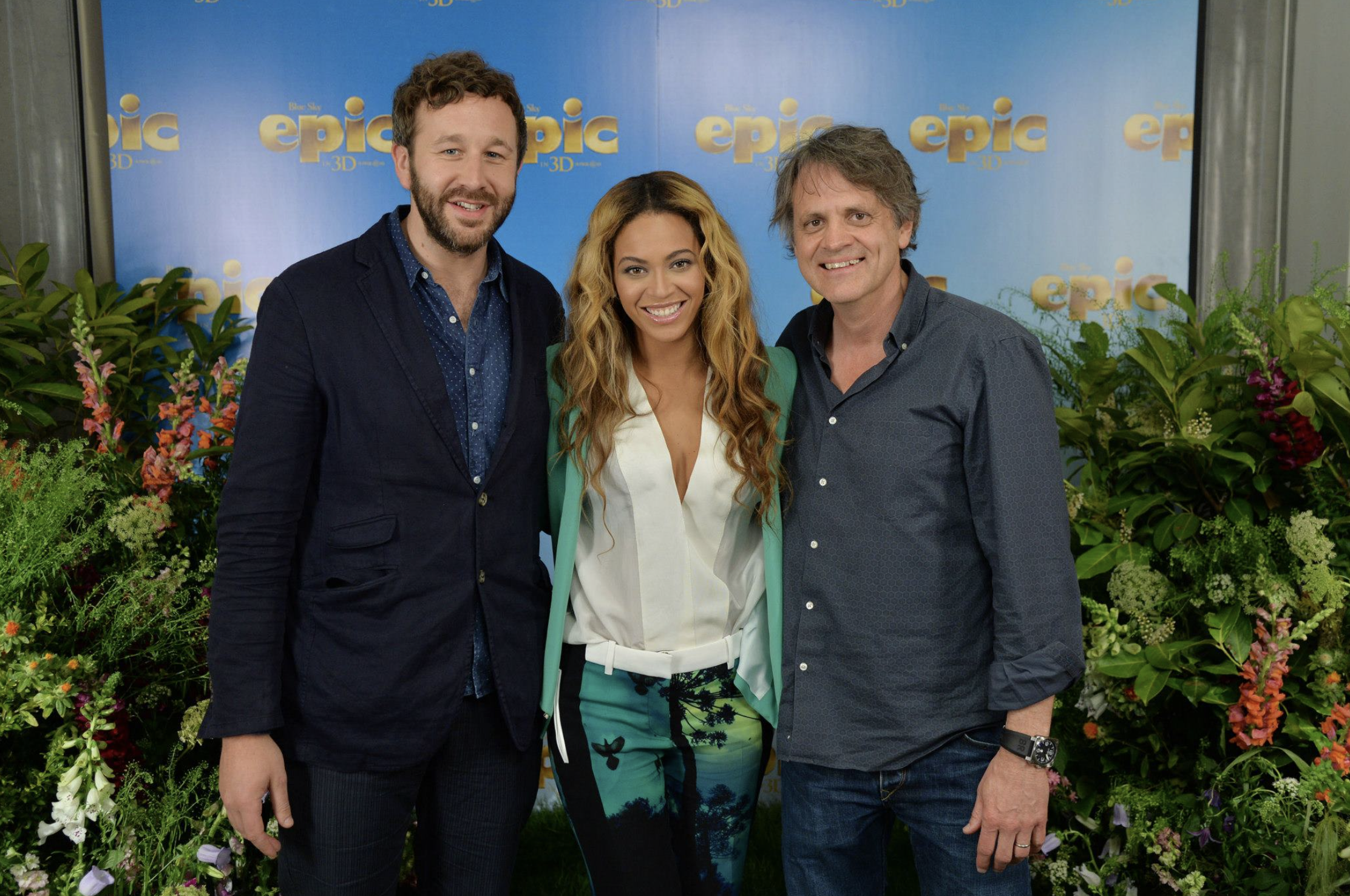
It’s easy to see why Beyoncé would’ve been interested in the role, aside from it dovetailing with her ongoing embrace of regality; it was especially fitting for a new parent, largely concerned with Tara choosing an heir. While promoting Epic, the star explained that she often fought tears while recording her lines. “I was actually pregnant when I visited and saw the sketches,” she said. “It was the first job I had after I gave birth … and I will never forget doing the scene where I pick the pod where the life of the forest is, and I bawled doing that scene.”
There was also the matter of M.K. and her father, who’re forced to understand each other better through the film’s dramatic journey; you can picture Beyoncé doing her first read of the script sometime in 2011 and being moved by that aspect. When M.K. learns that the forest people have been intentionally misleading Bomba this whole time, she’s uncomfortable hearing them make fun of him. “I think that’s kind of mean,” she says, not liking how her own thoughts about her dad sound coming from someone else. “It’s his life’s work.”
One of the artists Beyoncé had invited to the Hamptons the previous summer was Sia, and the Australian singer-songwriter turned out to be one of her more fruitful collaborators of 2013.
The first track of theirs that the public got to hear was “Standing on the Sun,” which had soundtracked Beyoncé’s H&M ad. The second was “Rise Up,” a credits song for Epic. In the latter, Beyoncé—playing herself as much as Tara, it seems—vows to protect all the young listeners who’ll one day have to step into their power. “Some people try to drag you down / Take it from me, stand and be proud,” she sings, her own daughter a likely inspiration. “You’re a warrior / You’re my warrior.”
“Considering how many animated children’s films supply the Best Original Song category year after year, it seemed like a safe bet,” Kyndall Cunningham wrote of “Rise Up” in 2022, and there was an interesting resigned tone that came through in coverage of it at the time. (This will happen again in the next chapter with Beyoncé’s soundtrack contributions to The Lion King [2019].)
But the star never mounted anything resembling an Oscar campaign for the song, and Cunningham points out that it isn’t even available to stream now. Who knows why that would be, but there’s little point in arguing that it was her best work: though it bears the dense vocal layering she’s long been known for—her isolated harmonies from it periodically go viral on social media—it manages to sound slightly unfinished, almost like a demo that had been cleaned up to the point of passability.
On the whole, May of 2013 had been notably cinematic for Beyoncé, since Jay-Z had also executive produced the soundtrack for that month’s The Great Gatsby (2013), directed by her onetime collaborator Baz Luhrmann. Two of her songs made the cut: Emeli Sandé’s jazzy cover of “Crazy in Love,” where she’s backed by the Bryan Ferry Orchestra, and Beyoncé’s own cover (featuring André 3000) of the late Amy Winehouse’s “Back to Black.”
There was a funny sense by mid-year that Beyoncé—Ms. “People Don’t Make Albums Anymore”—had been serving up constant dopamine hits while withholding her actual body of work, which was still shrouded in mystery. Aside from the soundtrack stuff, she kept appearing in ads featuring slices of her project, some of which she even started to perform on tour.
Her contractually-obligated Pepsi spot—directed by Jake Nava, it hammered home her status as a music-video icon by recapping more than a decade of work—was essentially a placeholder video for an as-yet-unreleased song called “Grown Woman.” That felt even truer of Jonas Åkerlund’s H&M spot and “Standing on the Sun.” L’Oréal would make do with an instrumental version of the second song, and Gucci would kick off its new gender equality campaign, Chime for Change, with an instrumental of “Pretty Hurts.”
The only thing resembling a bonafide Beyoncé release was a SoundCloud upload called “Bow Down / I Been On,” which sparked additional controversy for its supposed aggressiveness towards its women listeners. “I took some time to live my life / But don’t think I’m just his little wife,” she sings in the first part of the track over a trap beat; this half would later be integrated into “***Flawless.” The instrumental for the pitched-down second half of the song, “I Been On”—she wouldn’t officially release or perform this one for many more years—had originally appeared in her tour promo spot in February.
So where was the album? One Hollywood Reporter story claimed that Beyoncé had scrapped 50 songs and started over, and that Columbia Records was officially nervous about the whole thing, having hoped to release her project already. Not helping matters, prospective collaborators Diplo and Ne-Yo both suggested in separate interviews that they were mostly in the dark about what was going on.
“They’re still trying to figure out what they want that to be,” Ne-Yo offered.
Now that much wasn’t untrue. Lee Anne Callahan-Longo has recalled a pivotal conversation she seems to have had with her boss sometime in 2013; Beyoncé had been tinkering with her record for what felt like forever, and they needed to start talking about releasing it.
There were a couple of things that she apparently knew about her fifth album, BEYONCÉ (2013), from the beginning. The first was artistically exhilarating: she was done worrying about the theoretical six-year-old who might hear her music accidentally, and was ready to release something as grown as she felt. The second thing was more logistically tricky: she wanted each song to have its own video, taking the ethos of her B’Day Anthology Video Album (2007) several steps further by having a full-scale visual package ready from the jump.
This would mean hemorrhaging money—“We could spend hours and hours talking about the finances of how expensive that is,” Callahan-Longo has said—and there was the added complication of the star currently being on tour. But it sure would force people to listen to a body of work, and it’s not like Parkwood had to start from scratch: Beyoncé and Jake Nava had quietly filmed a video for “Grown Woman” before the Mrs. Carter Show started. What if that quiet extended to the project as a whole?

A surprise album—assuming they could pull one off—would kill even more birds for the team, especially if released digitally; not only were they still unnerved by the threat of leaks, which tend to happen somewhere down the manufacturing line, Beyoncé had also told her general manager, “I want to work on this ‘til it’s done … I don’t want the pressures of a delivery date.”
In time, a pipe dream emerged: a Beyoncé video album, released all at once, initially without physicals, as a surprise gift to fans. They could work the details out with Columbia later.
“We were on [tour] and she essentially told us ‘We’re gonna shoot all these videos on our off days,’” stylist Ty Hunter has remembered of Beyoncé’s first self-billed “visual album.” Production apparently really kicked in around August, just as the North American leg of the Mrs. Carter Show turned into the South American one, but we know that certain pieces (besides “Grown Woman”) had been in the works since much earlier.
In May, when the tour had come to Jonas Åkerlund’s home of Stockholm, Beyoncé played him some songs backstage, and the two spent the next several months going back and forth about the ones he’d responded to. In June, Parkwood had hired a new creative director, Todd Tourso—formerly artistic director of the Haus of Gaga—who’s explained that he would “listen to the songs with [Beyoncé] and then figure out what directors should work on what videos.” (In most cases, he’s said that she already had an idea that he’d “help her refine.”)
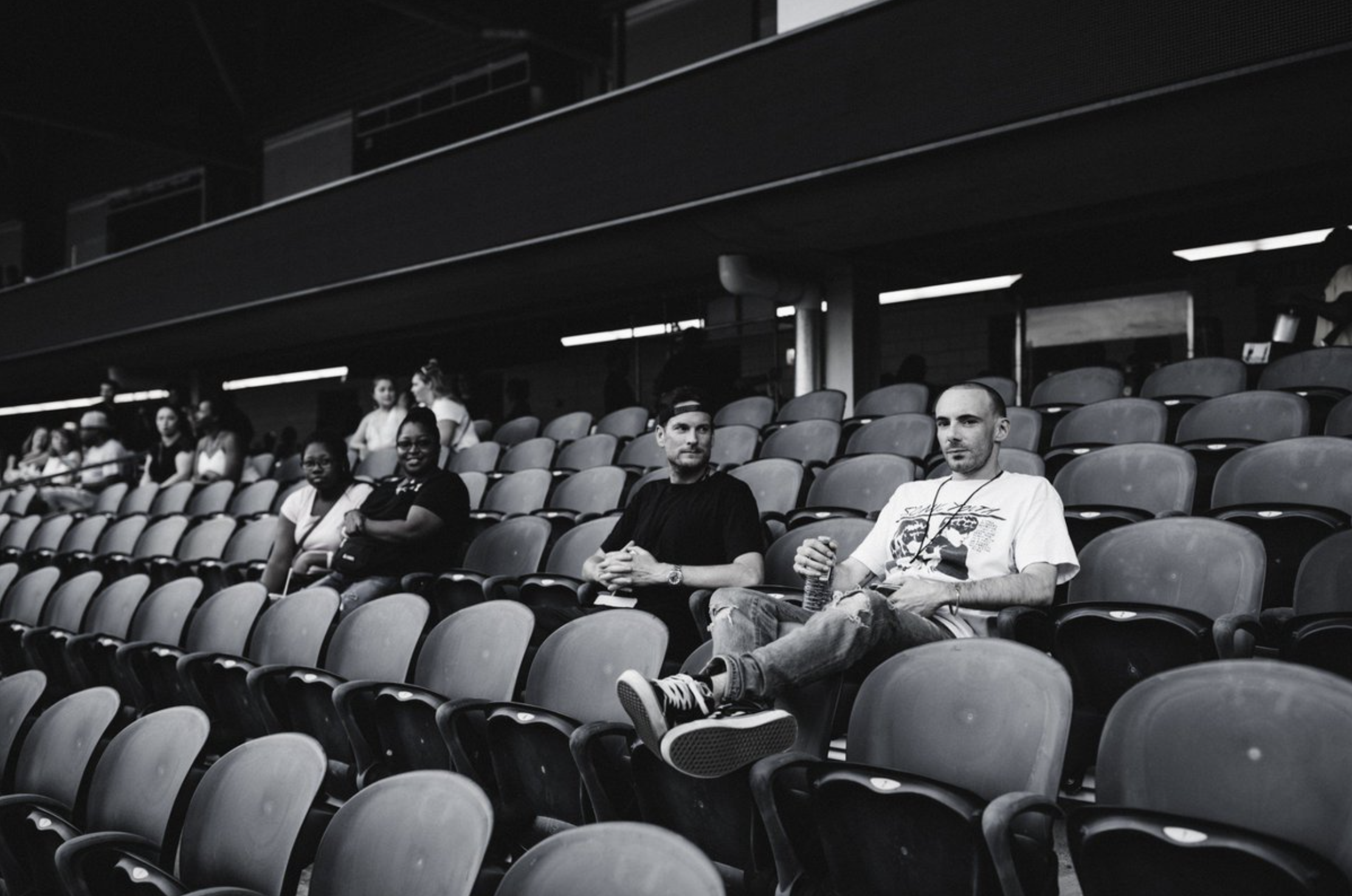
We’ve talked before about how visual ideation has never really seemed a hardship for the star. “When I sing a song,” she’d said while promoting 4, “I definitely have the image for the video in my mind. I kind of hear the choreography that will be in the video, and I can see how I’ll look, even before anyone—the record company, the director—has heard the song.” Throughout the summer and fall of 2013, the Parkwood team regularly woke up to emailed ideas that had come to their boss—a longtime insomniac, we’ve since learned—overnight.
This wasn’t necessarily a bother, though. Tourso has told a story about struggling with the “Heaven” concept when a note from Beyoncé appeared in his inbox: “We were flying out two days later, and I’m sitting there trying to pull a whole concept and at like 5:30 a.m. I get an email … with a full-on treatment: a story, reference images, shots. I was blown away … I think she’s just a visual person.”
If there were 13 directors on BEYONCÉ, all but three—Pierre Debusschere, @LILINTERNET, and Ricky Saiz—have already appeared in this story. One was Francesco Carrozzini, who photographed Beyoncé as Marlene Dietrich in Vol. II; another was Hype Williams, who’d helmed both “Check On It” (2005) and “Video Phone” (2009) before that. Several were Parkwood employees, like Tourso, Ed Burke, and Bill Kirstein (the producer who’d originally circulated the digital archivist posting). And the rest were people the star had been publicly working with as of late: Åkerlund, Jake Nava, Melina Matsoukas, and Terry Richardson.

The 13th director, naturally, was Beyoncé herself, who’d have credits on four videos in addition to being the whole project’s “supervising director.” So if it was a long list of names who’d need to keep their mouths shut, it was an almost entirely tried-and-true one. It probably didn’t hurt that they weren’t exchanging notes, either: Åkerlund has explained that he knew who the other directors were but nothing about their videos, which did pose a bit of a creative challenge.
By all accounts, putting 17 videos together over a handful of months—more or less in secret, while travelling the world—was no picnic. But “as crazy and manic and exhausting as it was,” Lee Anne Callahan-Longo has said, “we felt like we were part of something, and we had a mission.”
The team filmed videos in France, in Puerto Rico, in Australia, in Brazil. They had to be flexible—many entries ended up straddling multiple continents despite it not looking that way—but sometimes Beyoncé would instead have a very specific shooting location in mind, making their itinerary even more chaotic. “We flew from Mexico to Houston to shoot the beginning of the ‘Blow’ and ‘Cherry’ videos,” dancer Miss Ksyn would remember of the ’80s-themed shoot at Houston’s Funplex, where Beyonce spent time as a kid. (“Blow” and “Cherry” would become a single video, just as they’d become a single track.) “We then flew back to Mexico the next day to do a show. Then back to Houston the day after that to finish shooting the two videos. Then we flew to Puerto Rico to perform the last show of the South American leg.”
Todd Tourso would summarize the experience as “such a blur,” saying:
We would shoot during the day sometimes: 10, 12 hour days starting at five or six in the morning. Then [Beyoncé] would go do a show. Then she would go to the studio. Then she would pop up on set, six or seven the next morning, having not slept, and she’d tell us about some song she made the night before that was going to be amazing. That happened two or three times.
The album’s music, in other words, was being completed in tandem with its videos. For all the work that everyone had been doing for a year, Tourso has estimated that only “three or four songs … were done already” when he was hired. This checks out given that it wasn’t until sometime in the summer that Beyoncé met a key producer named Boots, who’d eventually be credited on most of the album.
“It started to come together where she was actually watching rough cuts for the videos in the studio and tweaking the music to fit the visual,” Tourso added. “She would rewrite some lines, or she would add certain audio, or she would add bridges. Sometimes, I think it would complete the picture of where the audio needed to go.”
Next chapter, we’ll talk about Beyoncé recording some of her more recent music while having certain films playing nearby on mute. She was already doing a version of that here, but with her own work.
Before the world would get to experience BEYONCÉ, its namesake first took Thanksgiving to release Life Is But a Dream on home video.
The DVD/Blu-ray was promoted by another Sia collaboration clearly inspired by Blue Ivy: “God Made You Beautiful,” a ballad that now played in the film’s end credits. The song matched the narrative of the doc in that it presented Beyoncé’s firstborn as a sort of cure-all—“You bring me back to life, back to life / You make everything right”—and felt overall like a more denominational “Halo.”
Also included with the release was a whole other feature: Live in Atlantic City (2013), the B&B-directed concert film of Beyoncé’s 2012 Revel residency. (You may remember that snippets had been included in Life Is But a Dream.)
Live in Atlantic City is a solid, if relatively forgettable, concert film of Beyoncé’s (again credited as “Beyoncé Knowles”), both packaged and remembered primarily as bonus content for fans who’d bought her doc. It’s also one of relatively few at this point that’s 100% show—no video diaries or behind-the-scenes segments, just a four-months-postpartum woman taking 75 minutes to prove a point. (When, during “Diva,” she sings that she told her give her a minute and she’ll be right back, she mimes having a baby bump.)

The set is presented entirely in a severe widescreen that’s both gorgeous and a little cold; you always have an excellent view of the stage and dance formations, but you sometimes wish you could take your thumb and index finger and enlarge the picture for more intimacy. In Vol. II, I wrote that “for concert films … Beyoncé doesn’t seem interested in recreating live shows so much as exploding them into whole new experiences,” and this is perhaps the only self-directed one where that isn’t true.
Revel was apparently where she’d worked out a lot of the arrangements, staging, choreo, and even interludes that fans would soon experience through either her halftime show or 2013 tour. The LED screen content extended to the actual floor of the stage, where she tried for cool bird’s-eye views in the spirit of Busby Berkeley. (This would later not work out swimmingly during the Super Bowl, in what’s become a Beyhive in-joke.)
It’s also where she’d first performed a stretch of “I Will Always Love You” before transitioning into “Halo.” (As a reminder, Whitney Houston had passed away a few months prior.) It’s where she’d first presented the video interlude where she recites the lyrics to “I Was Here” while personal footage plays, as well as the one where she waxes philosophical about femininity and sexuality to introduce “Naughty Girl.” (There was no graceful way to mention in Vol. II that Donna Summer had passed away—of lung cancer—just days before the residency, and Beyoncé shouts her out during the number; the late Queen of Disco’s voice had presumably already been mixed into the arrangement.)
But Revel turned out to have presaged something else, too—something that may not have attracted much attention at the time due to the fans-only nature of both the residency and concert film. During a dance interlude performed by a male soloist while Beyoncé changes costumes, her speaking voice narrates a complicated love story. “When I was a little girl, I could feel you out there around me,” she begins, describing how she used to wonder who the love of her life might be:
Then I found you. I found my heart, I found my truth. Love is supposed to protect. It’s supposed to be a safe place. So why am I so afraid? Afraid that my kiss wasn’t the sweetest kiss you knew? … Love isn’t supposed to deceive. So tell me: was it worth it? Will you replace me? Or will I replace you? Or will we remain? To know love is to know pain.
The interlude comes as a bit of a brow-raiser for how it directly follows “1+1,” and ultimately feels unresolved because we jump right into “Flaws and All,” presented here as a love letter to fans (as in Renaissance: A Film by Beyoncé [2023]). And that’s because several songs from the residency hadn’t made the cut of the film, almost all infidelity-adjacent—“Resentment,” “If I Were a Boy,” “Irreplaceable,” and so on. (To recap, the “Resentment” sequence had been included in Life Is But a Dream, though subtly repurposed as a fuck-you to tabloid media.)
So while the show’s in-person attendees had spent a lot of time with scorned-woman Beyoncé, film viewers get this somewhat puzzling interlude about romantic betrayal but are otherwise left hanging. Maybe these songs had simply been cut for time, but she’d effectively cleaned up the narrative of the May 2012 residency for November 2013 audiences. Here was something that perhaps paired a bit nicer with Life Is But a Dream, that now merely dipped a toe into an issue where she’d previously waded.
“The secret was everything,” Lee Anne Callahan-Longo has said of BEYONCÉ. “We were putting all our eggs in one basket, and our one basket was the surprise.”
That surprise first had to be approved by Rob Stringer, the chairman of Columbia who cameos in both Year of 4 and Life Is But a Dream when Beyoncé presents 4 to the label. According to Callahan-Longo, Stringer was freaked out when she pitched him their plans—“Are you fucking kidding me?”—but called back 48 hours later with his support.
In January, Columbia artist David Bowie—long presumed to be retired, having gone a decade since his last album—had surprise-released a lead single and video called “Where Are We Now?,” with his full-length The Next Day following in March. Beyoncé’s project would pose a more significant risk to all parties in arriving without notice as a complete audiovisual project, but it’s an important (and arguably under-acknowledged) bit of precedent; not only had her labelmate gotten to finish work on his album with minimal outside pressure, but the surprise aspect had also gone over exceedingly well with fans.
Just as Stringer had done with The Next Day, whose existence he only learned of in late 2012, he told as few people as humanly possible about BEYONCÉ throughout 2013, looping others in only when necessary. All the while, Parkwood chose to play things by ear as far as an actual release date, with Beyoncé continuing to film and record around her Mrs. Carter Show stops—often “hiding in plain sight,” as Callahan-Longo has put it.
The team eventually committed to a November 18 deadline, with iTunes (which had also handled Bowie’s surprise) secured as their digital release partner.
If the surprise itself was the basket into which everyone was putting their eggs, hindsight shows how close the bottom of that basket sometimes came to dropping out.
In August, Beyoncé had been spotted clearly filming stuff—on the set of “Drunk in Love” in Miami, then dancing with fans at Coney Island for “XO.” In October, Billboard asked Pharrell for an update on her project, and he seemed to suggest that it was “almost done.” Beyoncé was also clocked that month pulling up to Paris’s Crazy Horse cabaret with trucks full of production equipment, then again shooting bits of “No Angel” in Melbourne.
In November, she was caught either headed to or leaving the set of “Superpower” in Los Angeles, then filming “Jealous” on the streets of New York City. An actor also posted that he’d been on the set of a video called either “Haunted” or “Ghost Haunted,” then quickly deleted his posts.
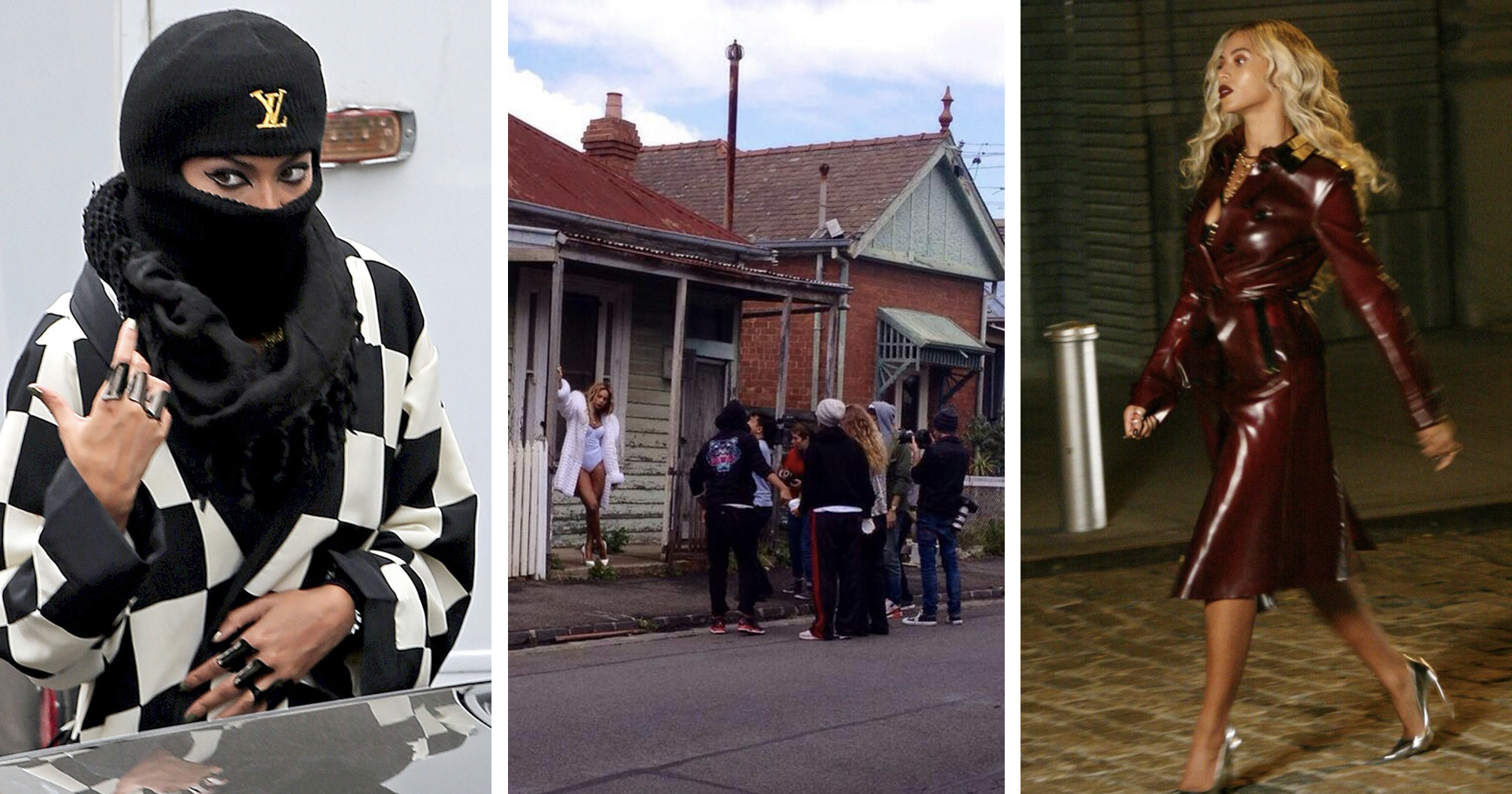
November 18 was eventually pushed to December 13—not that the album’s collaborators, whether musical or visual, had necessarily been made privy to either date.
In early December, Jonas Åkerlund found himself getting stressed emails from Parkwood about delivering his videos, “Haunted” and “Superpower,” but had zero idea that they were the only outstanding ones. “He just thought we were crazy,” Lee Anne Callahan-Longo has said. “And he kept saying, ‘But I need a few more days,’ and I’m like, ‘I can’t give it to you, Jonas.’”
Had I not, years later, gone on to write a graduate thesis about surveillance in Åkerlund’s work, I probably wouldn’t have noticed that the CCTV timestamps in “Superpower” suggest he may have been finishing it as late as December 11.
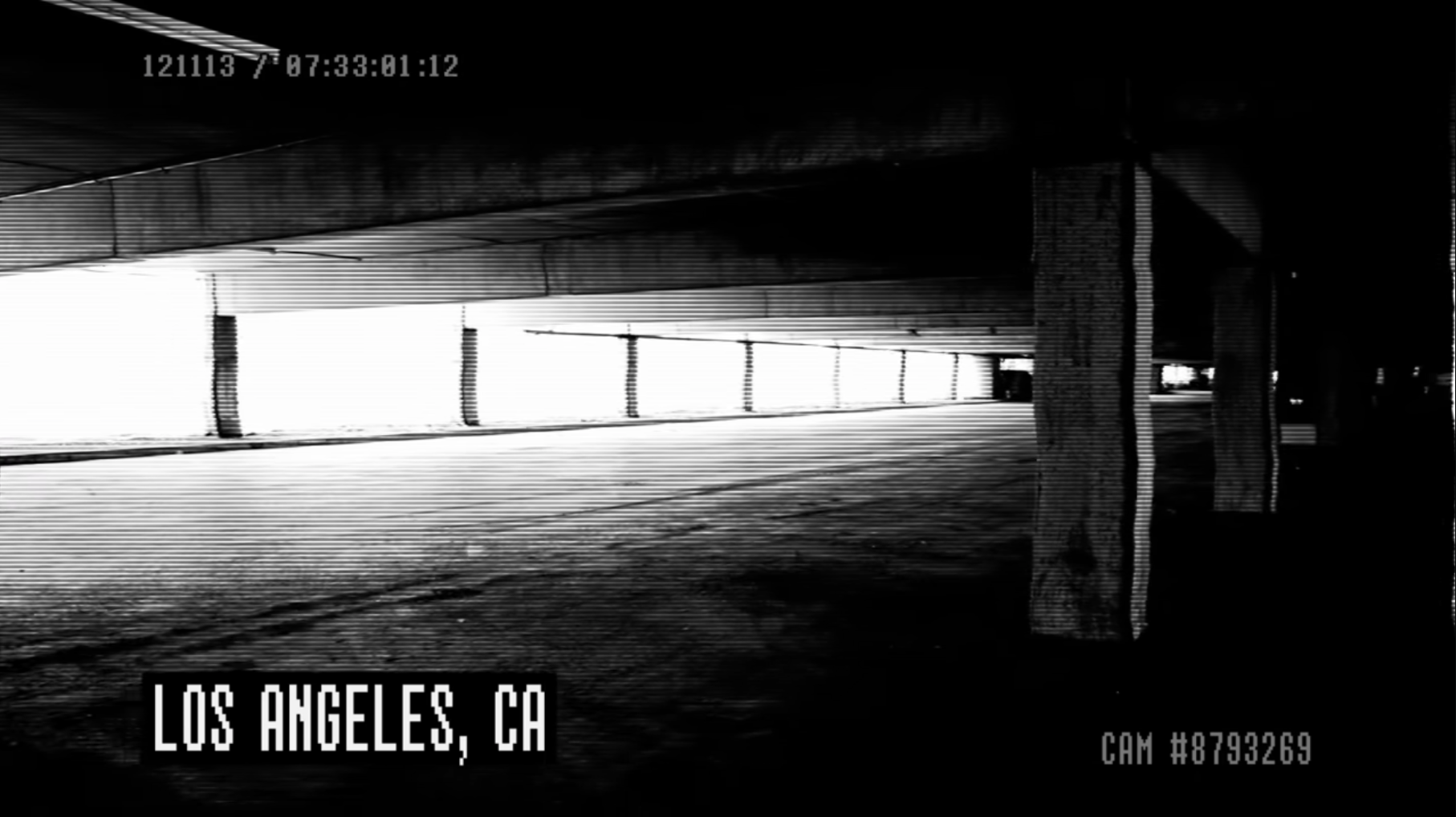
That same week, clips from Jake Nava’s “Grown Woman” video leaked online. So depending on who you were in this whole covert operation, December 13 was either too soon or couldn’t come soon enough.
On Thursday, December 12, Beyoncé walked offstage in Louisville, Kentucky and poured herself a nerves-settling glass of wine; she’d have to spend the night travelling to Chicago for her next show, and apparently did a lot of mumbling to herself. From Manhattan, the Parkwood team “waited in their war room, refreshing the iTunes Store continuously and biting their nails,” as Billboard would later write.
In the early hours of December 13—a Friday the 13th—the music-journalism world had long since filed its 2013-in-review content. The Beyhive had just been told by an especially sneaky Rob Stringer to expect Beyoncé’s album in 2014. And as had been the case since the ’80s, Tuesday was still the American music industry’s release day of choice. Parkwood, in other words, was planning a total sneak attack.
None of these words really meant anything to 17-year-old me. I was by this point a first-year undergrad student hoping to declare a major in film at the end of the school year, and my most immediate concern was passing my finals so that I could go home for Christmas. In the 11 months since I’d become a practicing Beyoncé fan, my fandom had not only been pretty measured—I didn’t listen to her any more than I listened to Lady Gaga or Lana Del Rey, or the Bollywood tracks that my one floormate had recently introduced me to—but it was also quite solitary.
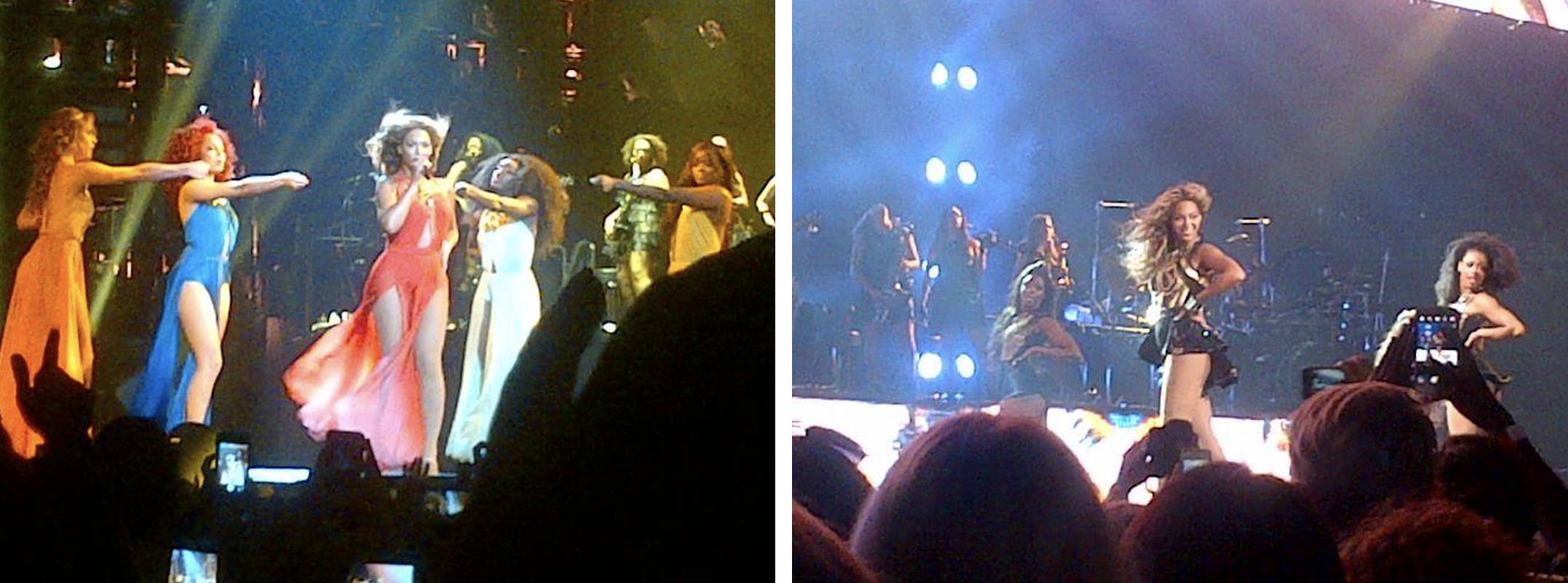
Aside from seeing the Mrs. Carter Show in July, I mostly just listened to Beyoncé in my headphones and let my mind wander while walking around campus, feeling thrilled by MP3 rips like “Run the World (Mrs. Carter Show Studio Version)” and the recent “Grown Woman” leak as I anticipated my 18th birthday in January. I didn’t hang out in Beyhive spaces online, I barely bonded with other fans IRL because I didn’t run into them often, and I didn’t keep any sort of tabs on the star’s activity beyond following her on Instagram. All of which to say: I’d missed 100% of the signs that her next project was somewhere on the horizon.
I don’t remember now whether it was English or French, but I was dreading one of those two exams sometime after midnight when a floormate sleepily asked our common room, “There’s apparently a new Beyoncé album?” When the same words came a second time, now without the question mark, I quietly but quickly retreated to my room—again, I was an anti-social kind of fan—to see what was up.
There was indeed a new Beyoncé album, with “BEYONCÉ” splashed across a black background in millennial pink—the first time she’d foregone appearing on one of her album covers. (According to Todd Tourso, Metallica’s self-titled album, aka their “Black Album,” had been a reference.) It also bore a parental advisory, something I don’t believe we’d ever seen before from the star.
On Instagram, she’d posted a quick trailer—Visual Album… 14 Songs… 17 Videos… Available Now—and captioned it merely, “Surprise!” It looked like I’d have to buy it as an all-or-nothing package on iTunes, so I did without hesitation, then promised myself to hold off until after my exam.
About a month before this, Parkwood—perhaps too swamped with the impending release to handle things in-house—had outsourced a making-of doc to a director named Zachary Heinzerling. “They were just looking for something different,” the fellow Houstonian would say of Self-Titled (2013-2014), a five-part series uploaded to Beyoncé’s YouTube channel throughout December and January.
While Year of 4 had been released just after its associated album in 2011, the short was merely one offering in a jam-packed rollout. With BEYONCÉ, the star hadn’t done any press besides teasing her album earlier in 2013, and it turned out that she didn’t plan on doing much going forward. That meant Heinzerling’s docuseries would almost singlehandedly serve as her official statement about the project, and for a long while. (There would be three additional featurettes staggered over the next year—on Jake Nava’s videos, on Jonas Åkerlund’s, and on “Pretty Hurts.”)
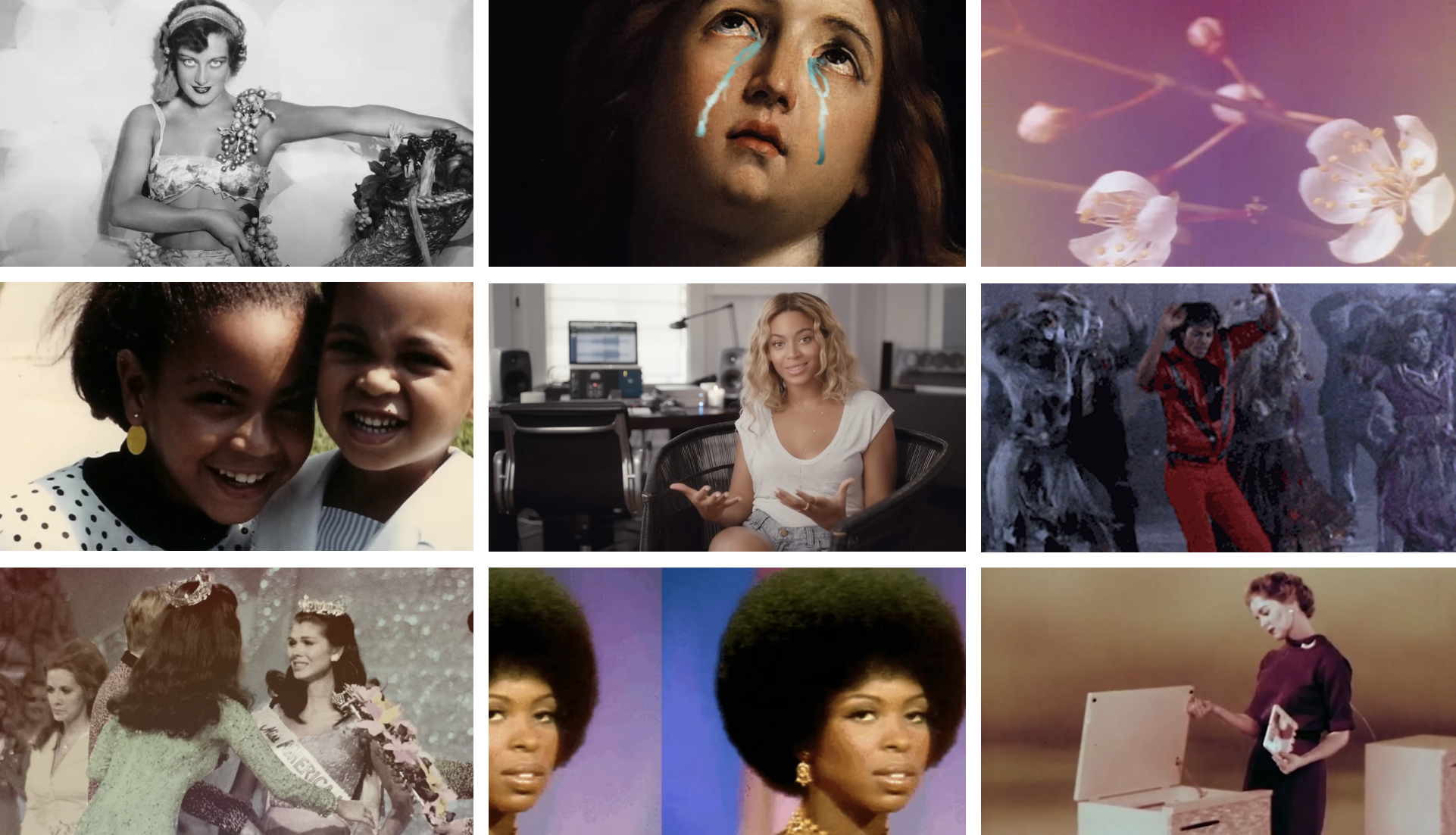
Though Self-Titled contains the pieces that usually make up a Beyoncé doc—old photos and home videos, behind-the-scenes footage from the previous year and a half, a central talking head—it features a notable amount of licensed archival material that had no direct connection to her. You’ll see a lot of this sort of thing in her visual projects now, but it was extremely rare at the time. (Off the top of my head, so far it’s really just been the March on Washington footage edited into I Am… World Tour, and a YouTube clip of dancers Tofo Tofo that’s edited into Year of 4.)
“I see music,” Beyoncé says in the first part of the docuseries, called “The Visual Album”:
It’s more than just what I hear. When I’m connected to something, I immediately see a visual or a series of images that are tied to a feeling or an emotion, a memory from my childhood. Thoughts about life, my dreams, or my fantasies. And they’re all connected to the music … I wanted people to hear the songs with the story that’s in my head, ‘cause it’s what makes it mine. That vision in my brain is what I wanted people to experience the first time.
While she speaks, we get flashes of the kinds of visuals she means—images of Joan Crawford and other film stars, shots of elated pageant winners and deflated pageant losers, a few seconds of Michael Jackson’s “Thriller” (1983). In an echo of Life Is But a Dream, she tells us that she wasn’t interested in preparing a series of advance singles for this album, that so much had gotten between the art and the fans, that she was asking her own to “invest” in a complete body of work.
“Running her own production company allowed Beyoncé to not only surprise-release her self-titled album, but follow its release with a package of YouTube videos delving into the making of said album,” writes Tshepo Mokoena. “These were DVD extra features rejigged for the digital age, created and shared by the artist herself.” Self-Titled is one of the last times we’ve been on the set of a Beyoncé video, and one of the last times we’ve been in the studio with her while she recorded an album.

From a research perspective, the 2012 studio footage is one of the project’s main highlights. In addition to posters for movies like The Godfather (1972)—shout-out to Beyoncé Corleone!—and Wall Street (1987), she’s surrounded at every turn by vision boards, which not only speak to her knack for seeing music but shed useful light on the project as a whole. (When these had come up during her American Vogue interview at the top of the year, she joked to Jason Gay, “It kind of feels right now like A Beautiful Mind.”) We’ll discuss their contents as we go.
In Beyoncé’s talking head for Self-Titled, she sits in a bright editing suite in denim cut-offs and a plain white tee. This set-up didn’t exactly scream “two weeks until Christmas,” but neither did BEYONCÉ, which Vice would call “an ’80s-indebted, chillwave-chewing womanist treatise about success and sexuality.”
In some ways, the album was a sort of sequel to 4, just as it would reveal itself to be a prequel to the one after it. The singer of “Run the World” felt that she’d finally worked hard enough to boast about her success (“***Flawless”), but she clearly had mixed feelings about her journey (“Pretty Hurts,” “Haunted”). She now had the baby she’d hoped for on “Countdown,” and while that baby was a source of boundless joy (“Blue”), it was the kind you could only understand because you’d experienced pain (“Heaven”). Her relationship seemed as troubled as always (“Mine,” “Jealous,” “No Angel”), but not troubled enough to shake her belief in love (“XO,” “Superpower”). As far as the album presented it, she and her husband were working things out by working each other out—on the kitchen floor (“Drunk in Love”), in the backs of limos (“Partition”), and in other horny situations best left to metaphor (“Blow,” “Rocket”).
As with 4, the narrator of BEYONCÉ was a complicated woman who carried competing truths in her head. But while we hadn’t fully abandoned the 2011 album’s world of synths and neon and Afrobeat, we’d absolutely entered moodier, even seedier territory. This new R&B soundscape felt more underground, almost ghostly; the star’s voice is often accompanied by those of inaudible strangers who seem to be just passing through the tracks. If there are slices of euphoria, there still tends to be some undercurrent of darkness—“XO” opening with audio from the Challenger disaster, say, or Beyoncé imploring her baby to ‘hold onto her’ in “Blue.”
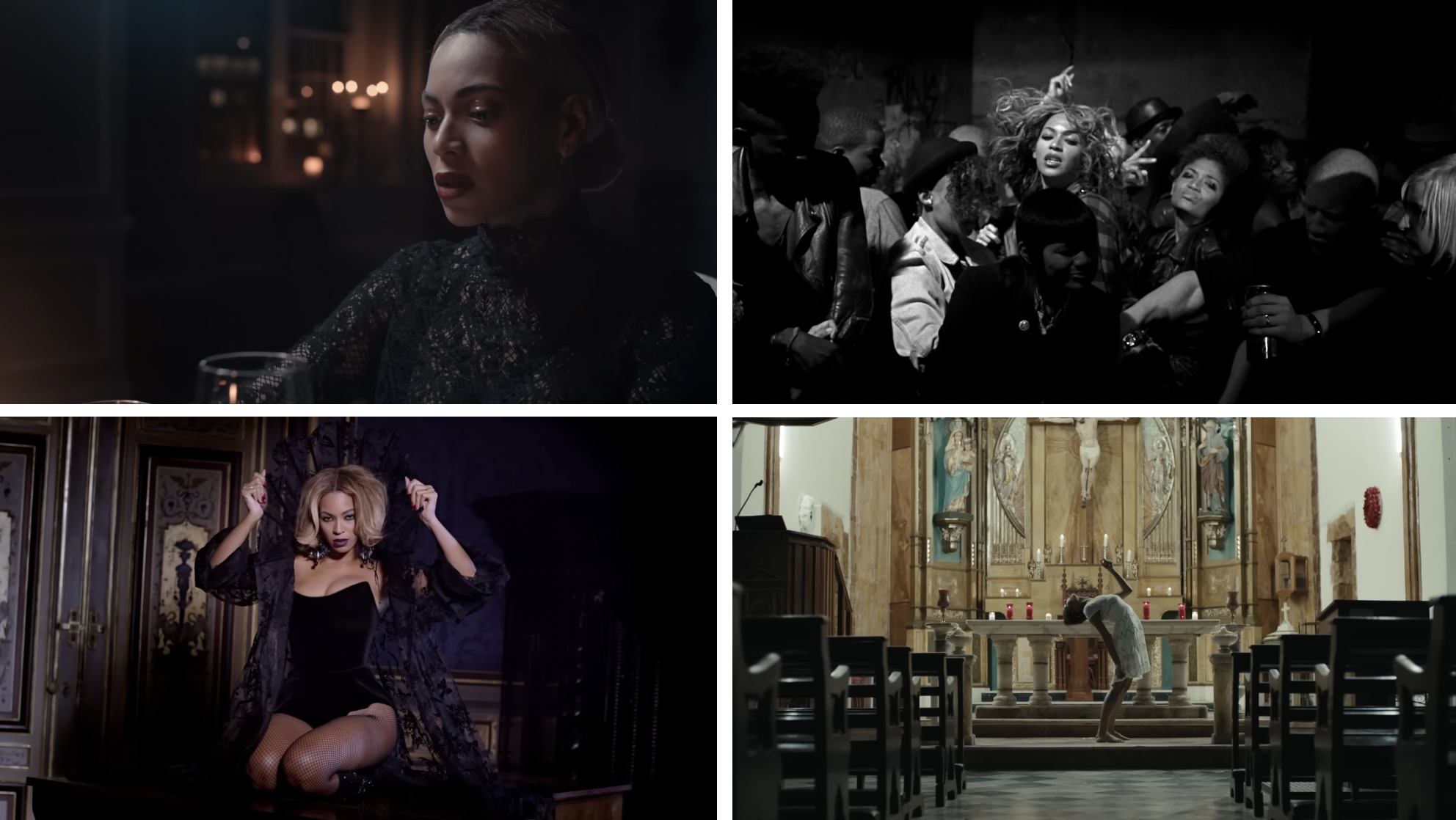
In many ways, this was the most goth-inflected we’d seen the star yet. A lot of the album’s videos take place under cover of night, or in spaces so airless that it matters little what time of day it is—stuffy dressing rooms, pleasure dens, houses that don’t feel like homes. There are moments of her sitting by candlelight in a cold penthouse wondering where her husband is, and moshing with skinheads in a dingy alleyway, and wandering the grounds of an old church clutching rosary beads. Even when BEYONCÉ’s videos came with bright pops of colour, they tended to be all smoke and fire and shadows and sweat.
The very first voice we hear on the album isn’t Beyoncé’s but Harvey Keitel’s, the star of multiple films mentioned in this story so far, from Quentin Tarantino’s Reservoir Dogs (1992) and Pulp Fiction (1994) to Ridley Scott’s Thelma & Louise (1991). That seems to have been more a happy accident than anything: for “Pretty Hurts,” a critical look at beauty culture, Melina Matsoukas needed a “greasy, Vegas-type pageant character” to serve as the M.C. of a competition, and Keitel was apparently a “big fan of Beyoncé’s.” (The actor wanted to be involved so much that he actually waited around for 20 hours when the shoot went significantly over time and much of the crew walked off the set.)
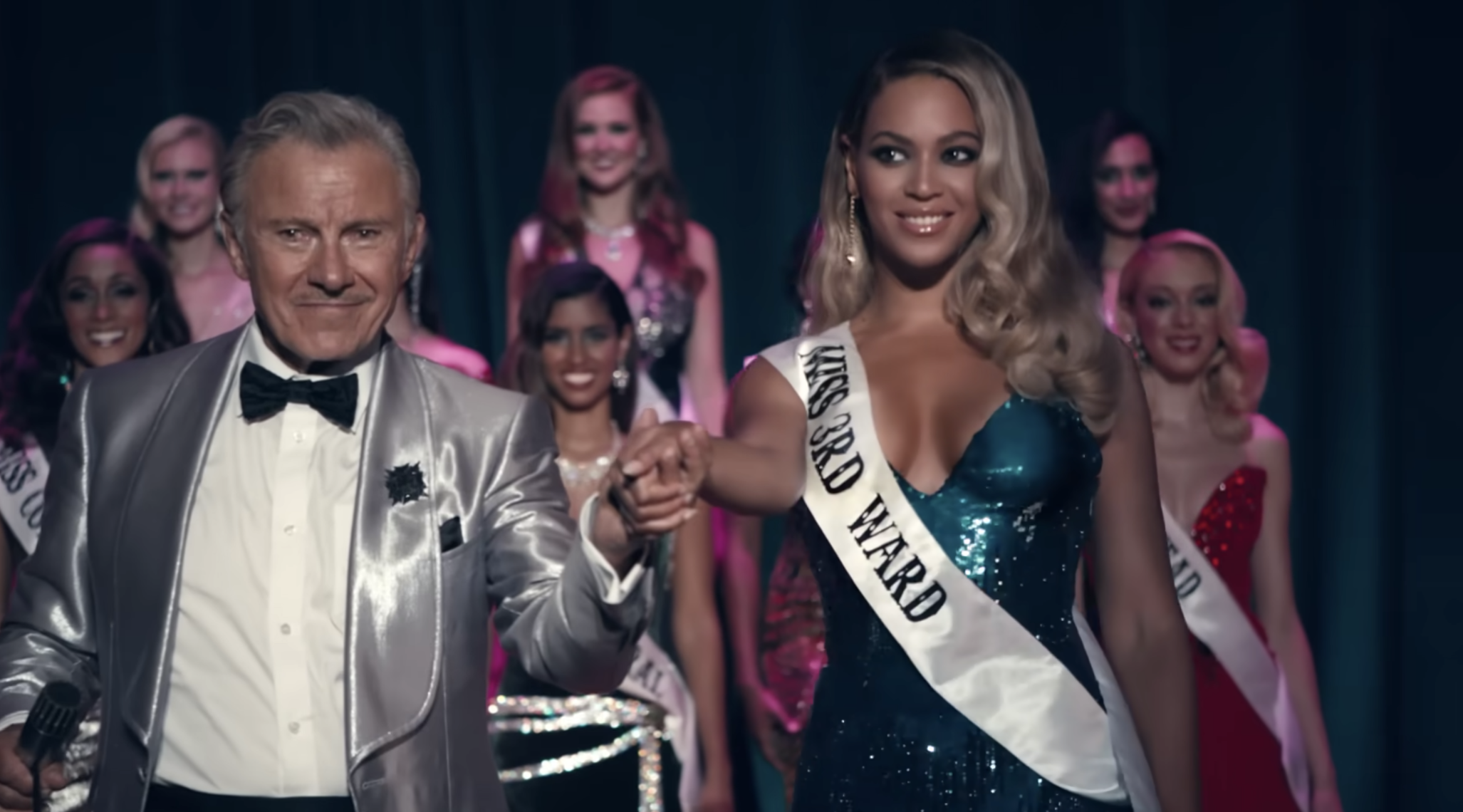
The world that Matsoukas created for “Pretty Hurts,” which would win a craft VMA for cinematography, was meant to read as “modern-day times but lost in a small town that’s probably stuck a bit in the eighties.” As the director explained, “I was going for kind of like how Blake Lively was in The Town.” Beyoncé plays a pageant queen called Miss Third Ward, a reference to her old neighbourhood in Houston, whom we watch self-tan and starve and inject her way through a competition just to come in second place. (At one point, she’s scolded by an instructor played by Shaun Ross, starring in his second Beyoncé video after “Party” [2011].)
Though “Pretty Hurts” is fictional—we arguably know this as early as “Mama said, ‘You’re a pretty girl / What’s in your head, it doesn’t matter’”—Matsoukas has recalled being inspired by a photo from a day that’s come up previously. Beyoncé had competed in a Texas Sweethearts pageant as a kid and posed with a bunch of trophies in front of her fireplace; the mantle is so crowded with them that several have to go on the floor. “Pretty Hurts” ends with her destroying a wall of such trophies, as if to reject the philosophy we’ve watched her live by for almost five minutes. (At seven total, it’s the longest video on the album.)

According to Matsoukas, Beyoncé had a blast smashing those trophies, heavy bits of shrapnel flying everywhere. In the second part of Heinzerling’s docuseries, “Imperfection,” the star elaborates on them as a motif in her project; she’ll later hold one on the beach in “Drunk in Love,” and eventually end up in a reconstruction of that Parkwood fireplace in “Grown Woman.”
“I had this image of this trophy, and me accepting these awards, and kind of training myself to be this champion,” she explains as we see footage of her rehearsing and performing as a teen:
At the end of the day, when you go through all of these things… is it worth it? You get this trophy, and you’re like, ‘I basically starved. I have neglected all of the people that I love. I conformed to what everybody else thinks I should be, and I have this trophy. What does that mean?’ The trophy represents all of the sacrifices I made as a kid, all of the time that I lost being on the road, in the studios, as a child. And I just want to blow that shit up.
After her cathartic trophy-destruction moment, “Pretty Hurts” ends with the first of several home videos included in the visual album. We watch a little Beyoncé accept an award at the same Texas Sweethearts pageant: “I would like to thank the judges for picking me, my parents who I love. I love you, Houston.”
The speech trickles into the next video, Pierre Debusschere’s “Ghost,” where 32-year-old Beyoncé expresses how—unfortunately for that kid who trained so hard to be a champion—she’s reached a standstill with this business. “I’m climbin’ up the walls ‘cause all the shit I hear is boring / All the shit I do is boring,” she drones. “All these record labels boring / I don’t trust these record labels, I’m torn.”
Is it worth it? In 2013, Beyoncé was publicly asking that question in a way earlier Beyoncés wouldn’t have dared.
One way of reading her fifth album, then, is that it hereafter attempts to make things right with her childhood self. (In a similar vein, Emily J. Lordi has called “Pretty Hurts” the album’s “antithesis—a dramatization of the kind of performance that the rest of BEYONCÉ will go on to reject.”) In unleashing her boldest artistic statement, not only in terms of format but also subject matter, perhaps she could free herself from everything she’d come to resent about her industry. She owed it to that tiny pageant queen to at least try.
Beyoncé has been clear that “Liberation,” as the fourth part of the docuseries is titled, entailed making some of the horniest music of her life. After “Ghost,” we enter a six-video run of mostly sexual fantasies, one of the album’s more headline-making aspects upon its release.
In Jonas Åkerlund’s “Haunted,” the star roams around a seaside mansion in Josephine Baker-esque finger waves, watching and being watched by a cast of deviants in a “voyeuristic tour”—as Priscilla Peña Ovalle once put it—before joining in on the fun. In Hype Williams’s “Drunk in Love,” Beyoncé and Jay-Z love up on each other in the sand to illustrate their song about loving up on each other in the club, in the car, in the foyer, in the tub, and in the kitchen. (In his verse, Jay-Z name-checks his wife’s almost-collaborator, Clint Eastwood, and may reference the screen legend’s recent role in Trouble with the Curve [2012].)
In “Blow,” again directed by Williams, Beyoncé salutes oral sex while dressed like a member of Prince protégée group Vanity 6—that is, when she isn’t roller-skating around in a Wonder Woman shirt, the second in her videography after Diane Martel’s “Listen” (2006).

In Vol. II, we talked about how Beyoncé campaigned for the role of Wonder Woman in the late aughts, and ironically, it was more or less as she released this video—in early December, 2013—that Gal Gadot was cast as the DC superhero. (Funny enough, Gadot would later credit Beyoncé’s music with helping her land the role.)
In “No Angel,” another song that owes a debt to Prince—the vision boards in Self-Titled give us at least one still from Purple Rain (1984)—sex is offered up as a sort of marital saving grace; Jay-Z may be a liar who’s late all the time, and Beyoncé comes with a side of trouble herself, but here’s something they’ve always been good at. @LILINTERNET had previously made a New Orleans-centric video for Diplo called “Express Yourself” (2012), and Beyoncé asked for the director’s contact hoping to get a Houston equivalent. In the end, vignettes collected around her hometown—of local celebrities and passersby, but especially their clothing and cars—were interspersed with shots of her in Melbourne, Australia.
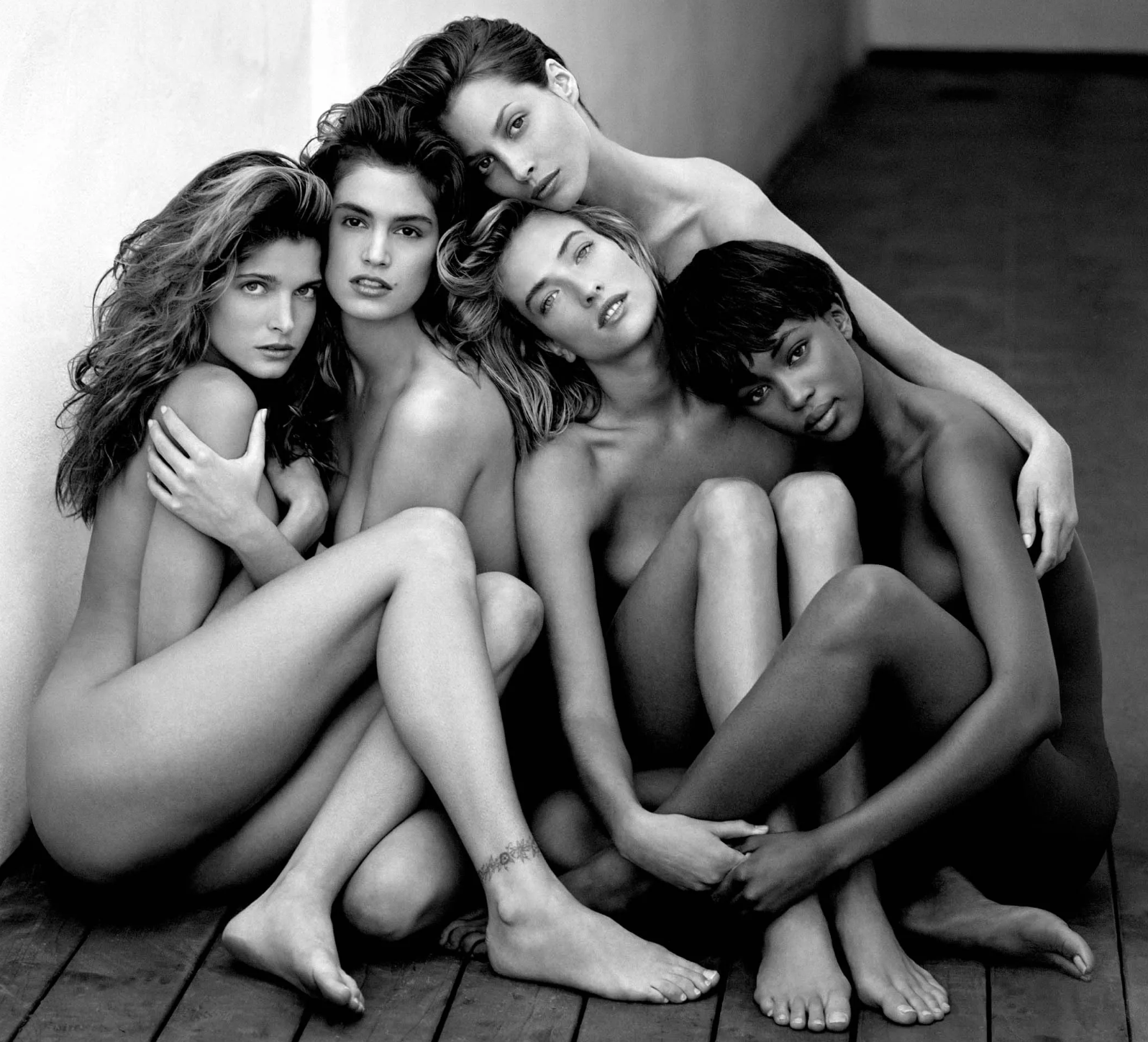
One of the images visible on Beyoncé’s vision boards is an Herb Ritts photo called Stephanie, Cindy, Christy, Tatjana, Naomi, Hollywood (1989), a nude class portrait of some of the day’s top models. Nearly all would appear in David Fincher’s video for George Michael’s “Freedom! ’90” (1990), which Beyoncé wanted to do a “contemporary, street version” of for her visual album, as per director Ricky Saiz. For “Yoncé,” she enlisted Jourdan Dunn, Chanel Iman, and Joan Smalls for a quick and dirty video shot outside in Brooklyn, all handheld and naturally lit.
But while Yoncé raps that she’s “all on his mouth like liquor,” there’s an awareness in the song’s lyrics of being gazed at equally by women, a general blurring between envy and something more like lust. As a result, the video feels decidedly more homoerotic than Michael’s; Smalls actually licks Beyoncé’s décolletage at one point, something the star told her she could “absolutely” do when she felt so inspired.
The most infamous video of this bunch might be Jake Nava’s “Partition,” where Beyoncé and Jay-Z try not to have sex in the back of a Rolls-Royce before she performs a private show for him at Paris’s Crazy Horse.
In Self-Titled, she explains that the cabaret is where the couple celebrated their engagement in late 2007—a previously little-known anecdote, speaking to how successfully she’d separated her public persona from her private life. “I don’t at all have any shame about being sexual,” she elaborates, “and I’m not embarrassed about it, and I don’t feel like I have to protect that side of me.” But of course, the unspoken word here is anymore.
Somewhat cosmically, I ended up catching a performance at Crazy Horse while finishing up this chapter, and I agree with Beyoncé’s summation that it’s “the ultimate sexy show” (not to mention wildly impressive on a production level). But it also took me seeing it for myself to realize that the cabaret stretches of “Partition” are more or less recreations of some of the club’s staple numbers. The star may not be topless in her video, but that’s really the sole difference; the set and lighting design, the choreography, and even the costumes are all the same. (I also hadn’t realized that Crazy Horse trickled into more of her 2013-2014 output than just “Partition,” but more on that in time. Remind me to do more field work!)
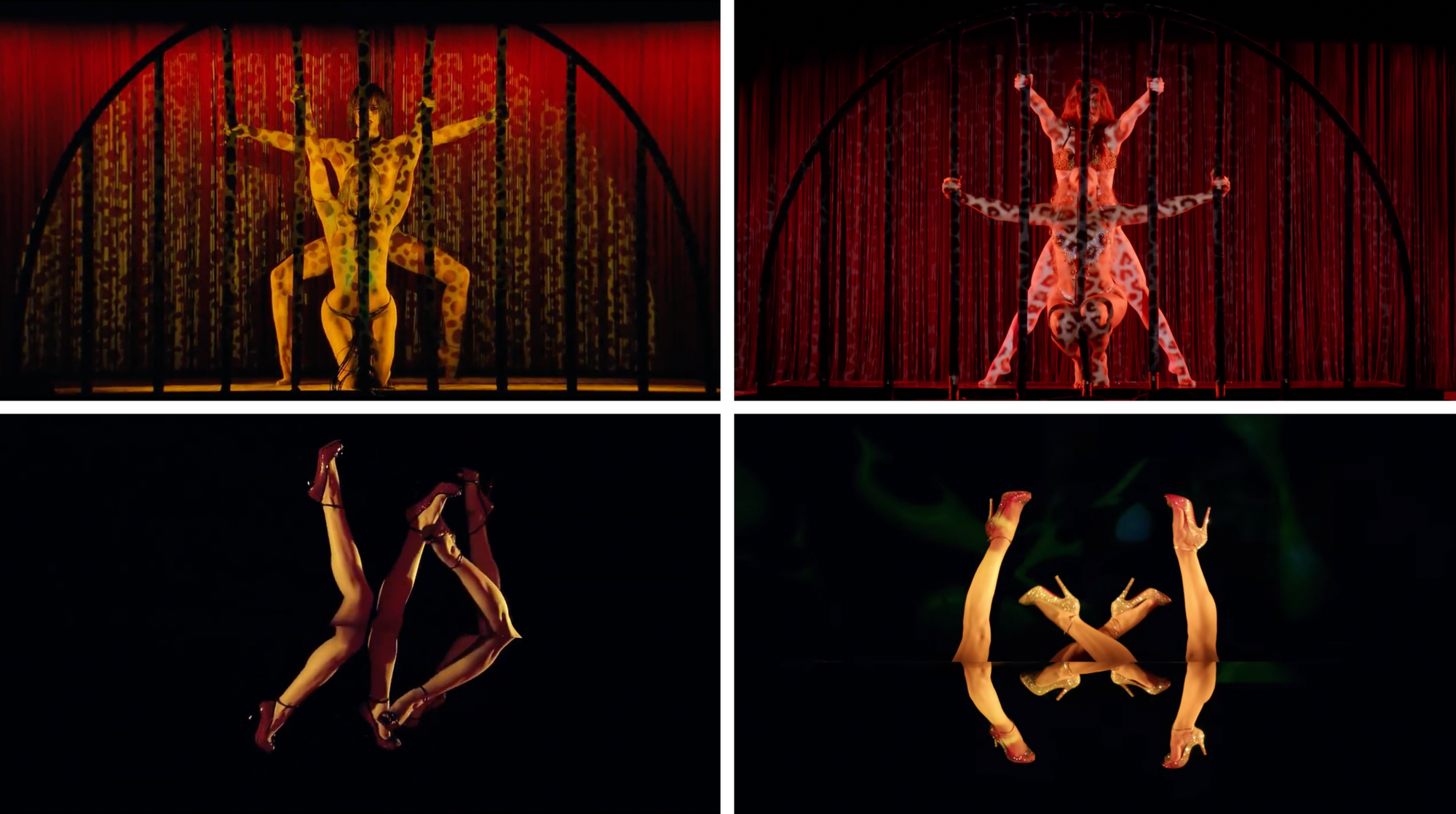
I don’t say the above, though, to undermine Beyoncé’s video, since there’s actually something pretty subversive about her inserting herself into an unchanged Crazy Horse performance.
Though the site suggests that they’ve eased up a bit in recent years, the cabaret had previously asked that dancers meet certain “stringent physical requirements … in order to maintain visual harmony on stage.” Aside from a height specification—it’s still true that you have to be between 5’6” and 5’8” to audition—there were previously asks related to the “ratio between the length of their legs and their bust,” “the distance between the two tips of the breasts,” and “the distance between the navel and the pubis.” They also required that dancers have classical ballet training, though that’s since been broadened to additionally allow “jazz, contemporary or hip-hop dance.”
Reading between the lines, there’s a type of body that the cabaret has historically courted in its three quarters of a century, and it isn’t necessarily Beyoncé’s. The ballet detail alone arguably says a lot, not just about a dancer’s desired build but also her probable race, since that world has a well-documented hostility towards Black performers. Crazy Horse may employ at least a few dancers of colour these days—I learned this from the site, since I don’t believe there were any in my September show—but “Crazy Girls” are still overwhelmingly white, with several numbers conceptually relying on them being interchangeable enough to be confusable. Or rather, visually harmonious.
For the bridge of “Partition,” Mrs. Carter Show dancer Hajiba Fahmy delivered a French translation of Julianne Moore’s “Do you like sex, Mr. Lebowski?” speech from The Big Lebowski (1998), one pretty similar to the version that appears in the French dub of the film. Fahmy’s monologue translates as:
Do you like sex? Sex. I mean, the physical activity. Coitus. Do you like it? You’re not interested in sex? Men think that feminists hate sex, but it’s a very stimulating and natural activity that women love.
In The Big Lebowski, Moore plays Maude, an artist—“My art has been commended as being strongly vaginal, which bothers some men”—with a bob as severe as her character. The monologue is the first of two times on BEYONCÉ where its maker embraces feminism by borrowing someone else’s words about it. In this case, she makes sex positivity non-negotiable to her feminist politics, anticipating some of the discourse that would follow the album’s release.
Two years later, the Carters would purchase the mansion where the Coen brothers’ film was shot, but the Coens will return more officially in Vol. IV when we talk about Cowboy Carter (2024).
In Self-Titled, we’re taken to Beyoncé’s Hamptons writing camp in 2012, and she explains the inherent comedy of concocting these erotic fantasies in the studio while she was actually sleep-deprived and breastfeeding.
Her vision boards give us a look at how she was trying to reconcile these two competing worlds. Alongside Helmut Newton’s Winnie on Deck (1975) and various photos from his Big Nude Series (1980), there’s a pregnant (and nude) Claudia Schiffer on the cover of German Vogue, a pregnant Iman in a photo captioned “Iman…Businesswoman,” and Kate Moss and Diana Ross posing separately with their daughters. There are also several images from a Russian Vogue spread featuring Maryna Linchuk, where the model takes on the big city in stilettos with a couple of small kids. Evidently, Beyoncé wasn’t just going for hot mom but supermodel-hot cultural powerhouse with a child in tow.
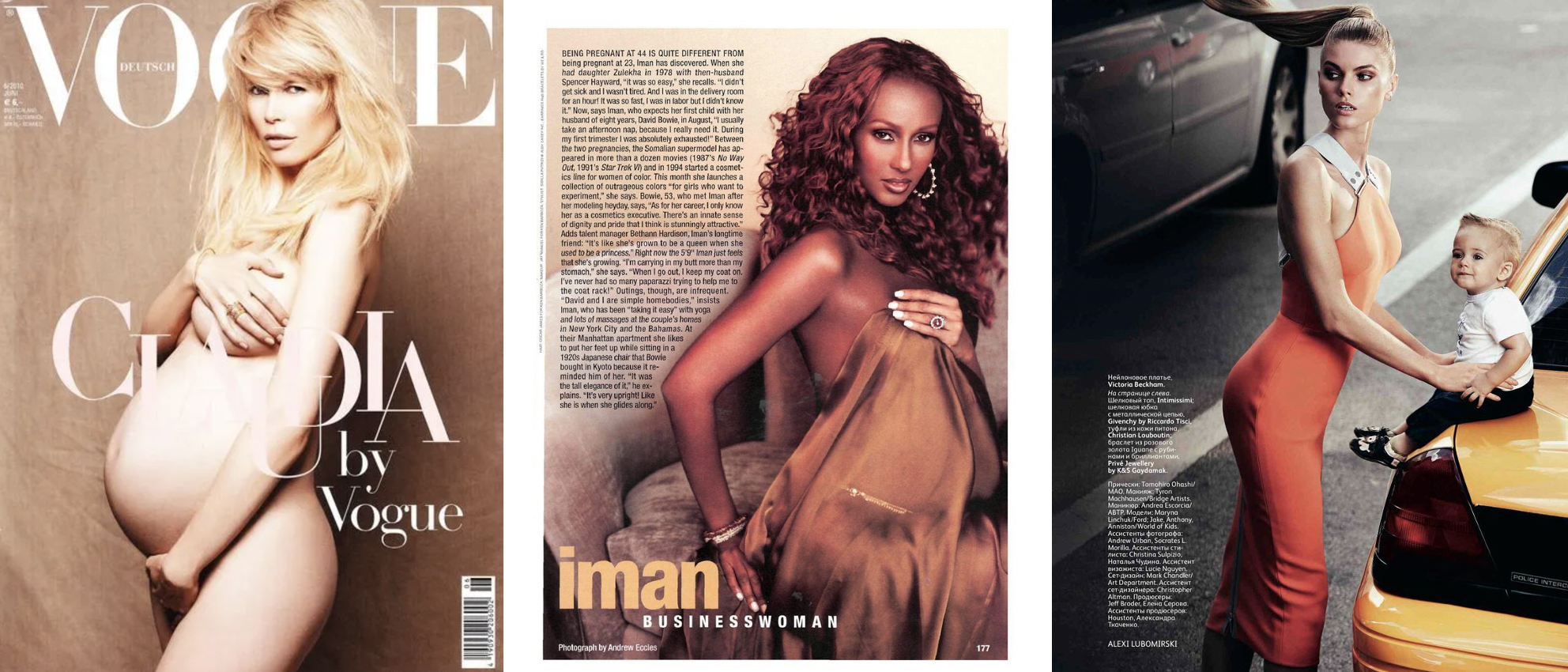
With the exception of choreographer Frank Gatson explaining to the camera that she’s shooting “Partition” on just one hour of sleep, Self-Titled is light on the sort of work ethic stuff we’ve talked about with previous docs—and in Vol. II, I argued that it’s more likely to appear when Beyoncé has a directorial credit. But as in Life Is But a Dream, the fruits of her labour are presented as enjoyable by women across the board. After hearing “Rocket,” for example, Pharrell says that her record will “set women free,” comparing her to the keyholder of a jail.
Some of the most explicit philosophizing Beyoncé does, however, is on the topic of ‘getting her body back’ after giving birth, which she spins into an empowering act. Telling us that she’s fully aware how much skin she’s displaying in her project, and going into some detail about her weight loss, she continues:
I wanted to show my body! I wanted to show that you can have a child, and you can work hard, and you can get your body back. I know finding my sensuality … being proud of growing up—it was important to me that I expressed that in this music because I know that there’s so many women that feel the same thing after they give birth. You can have your child, and you can still have fun, and still be sexy, and still have dreams, and still live for yourself.
The messaging was that Beyoncé had made a splashy return not just to her former physical state but to her craft, where getting back to business after bearing the children is presented as both fun and sexy, as a welcome and even professionally game-changing exercise in creativity. And it’s important to spell that out ahead of our discussion in Vol. IV of Homecoming: A Film by Beyoncé (2019), where she struggles to replicate this postpartum vibe the next time she gives birth.
The idea that these hornier videos are meant to read more as works of imagination than reality is indicated in a curious way in the project itself. The bookending shots of “Partition” present all the intervening ones as taking place entirely in Beyoncé’s mind; this sexual fantasy is one she’s enjoying over breakfast while her man ignores her from behind his newspaper.
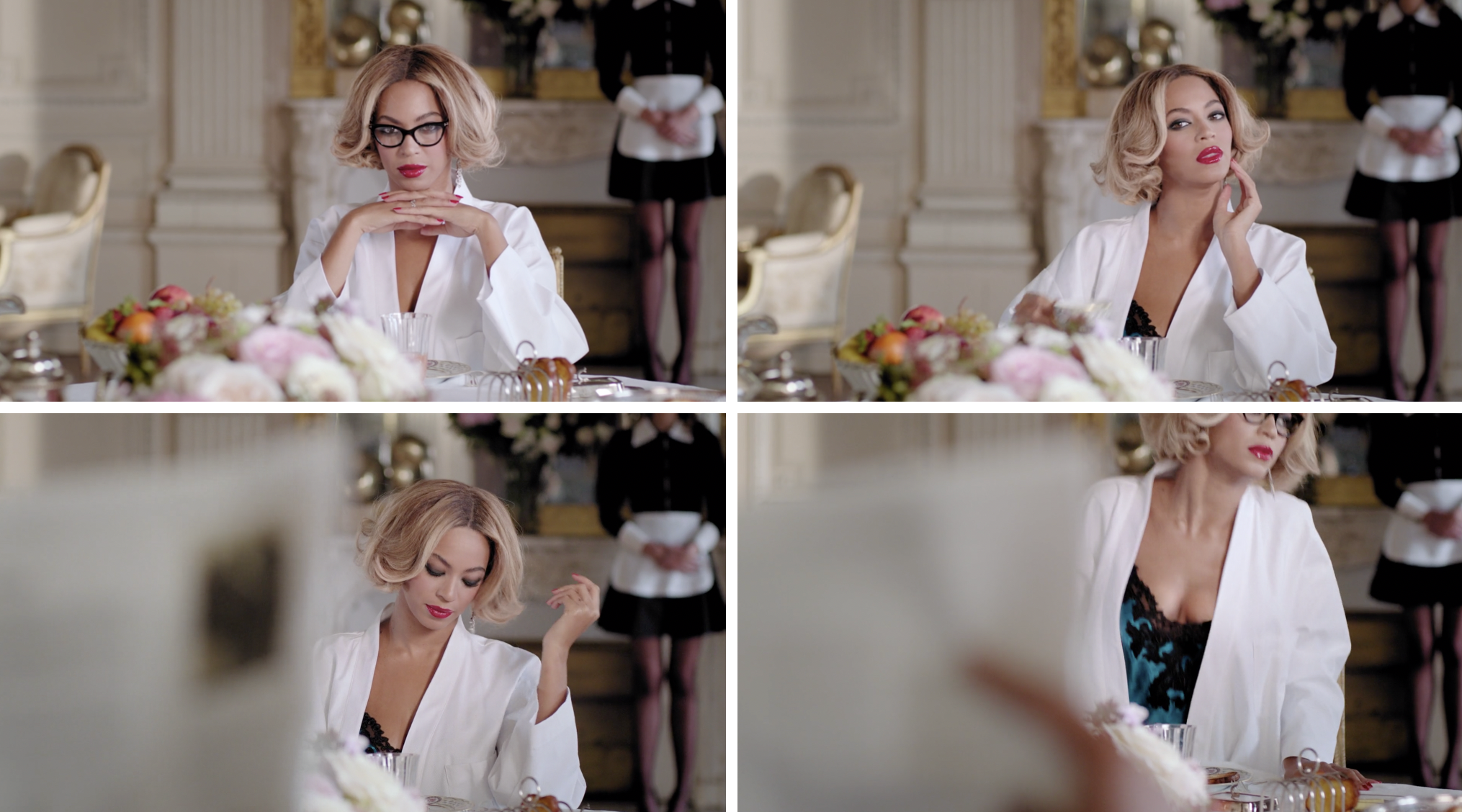
If you watch the videos sequentially, the final shot of “Partition” seamlessly becomes the first shot of “Jealous,” where the same character—as played by the star in a white silk robe and glasses—has realized that she can’t divert his attention, and gets up from the table in her rejection.
Directed by Francesco Carrozzini, Todd Tourso, and Beyoncé herself, “Jealous” has her all dressed up and waiting for her husband to come home to the candlelit dinner she’s cooked for him. “I wish that you were me / So you could feel this feeling,” she sings as it hits her that he won’t be joining her, his priorities—and maybe affections—elsewhere. “I never broke one promise / And I know when you’re not honest.”
We then watch Beyoncé hit the town, drinking and playing pool while she flirts in a bar; the song describes her reminiscing with her ex about the time they shared together in Texas, a ballsy real-life touch. The star had sent her team a link to the video for Hanni El Khatib’s “Roach Cock” (2012)—helmed by Ricky Saiz, the director of “Yoncé”—with a note that she was “inspired by how this feels.”
You can see how Saiz’s 2012 video influenced the bar moments in “Jealous,” from the rough colour scheme and lighting to the overall graininess. But the lyrics suggest that this is all a totally theoretical act of retaliation, since Beyoncé actually has some respect for this relationship: “Sometimes, I wanna walk in your shoes / Do the type of things that I’ll never, ever do.” And indeed, we’re returned to her still all alone in her home, faithful as ever.
“Jealous” proceeds not with her living out her retaliatory fantasy but throwing a trench over her lingerie set and roaming the streets of New York to try and find her partner. It’s during this vulnerable moment that she bumps into, and is recognized by, pedestrians who gawk and take photos; as Kevin Allred writes in Ain’t I a Diva?, “In ‘Partition,’ she wanted attention that she wasn’t receiving, and couldn’t receive on her own terms. In ‘Jealous,’ she’s receiving attention, but not the attention she craves.”
For someone who’d previously done a lot of relying on fictional characters to make infidelity bangers, Beyoncé seemed here to be playing none other than Beyoncé. The ordering of the tracks also complicates the “I just wanna be the girl you like” that we hear over and over on “Partition”; it suddenly sounds less like a sexy roleplay promise and more like a knowingness that she wasn’t said girl by default.
Beyoncé ends the fifth and final part of Self-Titled, “Honesty,” on a similarly and surprisingly somber note. “Sometimes you have to take the good with the bad,” she explains, a little after telling us that she’s tapped into many past experiences for this project. “Sometimes you have to take the insecurities to get to the secure place.”
There’s a recurring idea in BEYONCÉ that highs are necessarily wrought from lows, be they romantic, professional, or maternal; as I put it in the last chapter, where I argued that this principle became a bedrock of the star’s art beginning in her 30s, “you get to reap because you sowed.” But she largely leaves her lows unspecified in the docuseries, choosing instead to strongly allude to them in the project itself.
“Jealous” comes during a stretch of BEYONCÉ loosely defined by a willingness to keep believing in a relationship despite its flaws; as far as the star had presented hers in late 2013, it was in the midst of some kind of healing process, but it was a process she trusted. “If you’re keepin’ your promise, I’m keepin’ mine,” goes the song’s chorus, a repeated commitment in the face of any doubt.
The video ends with her finding her (faceless) man on the street and embracing him, though as Kevin Allred writes, it’s “an awkward, unsatisfying reunion … the shot fades out on Beyoncé’s face resting on that nondescript shoulder, relieved but still visibly distraught—nowhere near joyful.”
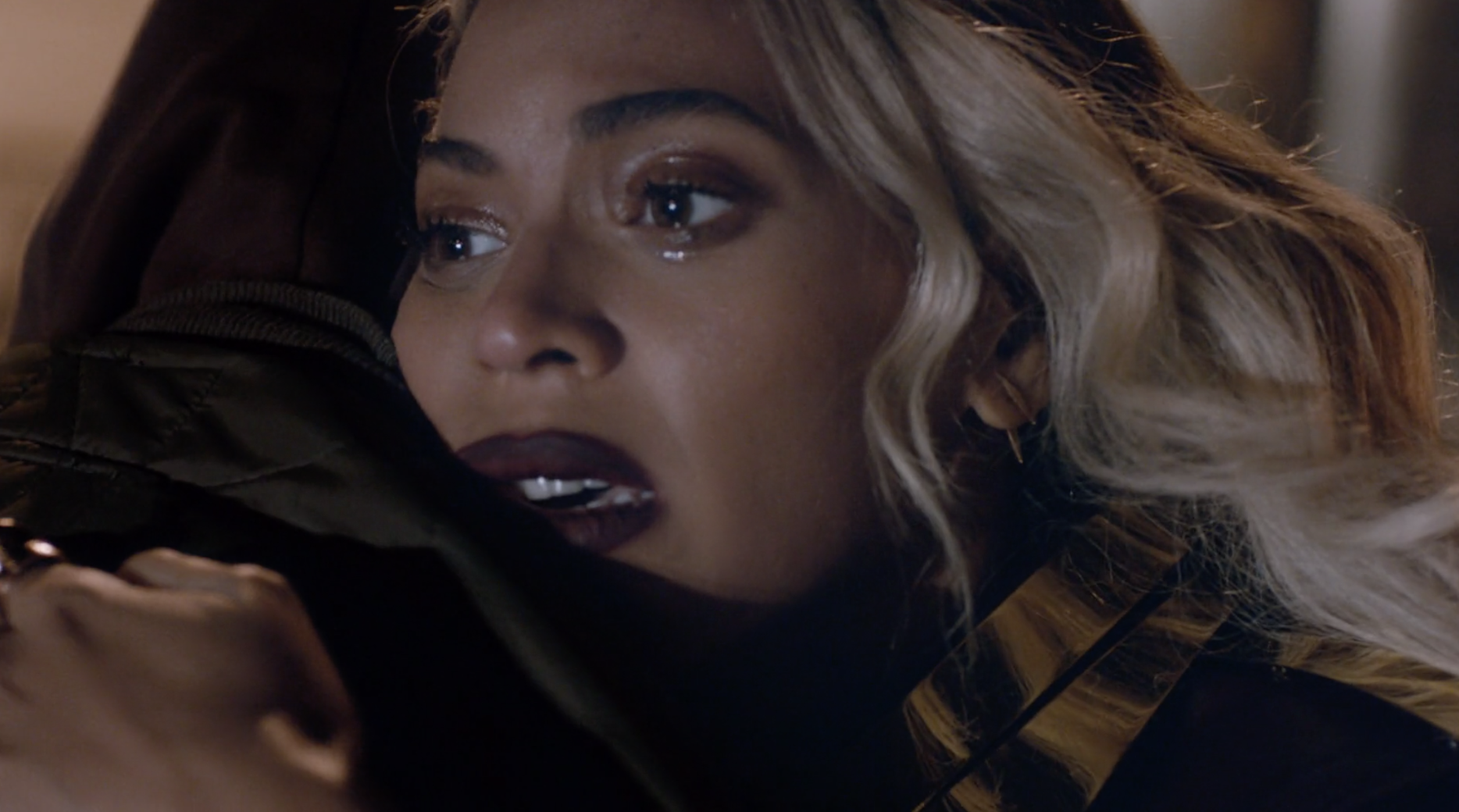
The next song in this same stretch, “Rocket,” is—to quote scholar Paula Harper—“a sonic map of an act of sex, of lovemaking.” A loose homage to D’Angelo’s “Untitled (How Does It Feel),” it’s the longest track (six and a half minutes) on the initial release of the album. “It takes you through this journey,” Beyoncé explains in Self-Titled. “You know, you’re flirting and you’re talking all of your arrogant shit. Then, you climax, and then you have your cigarette.”
The video, directed by B&B and Bill Kirstein, is broken up into three acts, separated by quick pauses where we completely cut to black. For the first minute, there’s an invitation section where Beyoncé advertises a lap dance in expensive lingerie, as shot at New York’s Standard, High Line hotel. For the second minute, there’s a foreplay section where the video gets, well, wetter: there are now droplets on skin, kitchen taps being turned on, the star submerging herself in the bath. And for the final two and a half minutes, there’s an actual sex section where these existing layers are joined by footage of other lovers and even phallic imagery—cigars in mouths, keys in keyholes, power drills entering planks of wood.

In this last section, the song is turned into one about the pleasures of music-making in addition to anything else. “This song actually is about singing from the heart, and harmonies, and adlibs, and arrangements,” Beyoncé explains in Self-Titled. That would be why there’s a ticking metronome included among all the cigars and drills, and why the star happens to be sitting at a piano when the song—and she herself, it seems—approaches climax.
This secondary reading of “Rocket” opens up a lot of double meanings in its lyrics, which now seem to be as much about her musicianship:
I do it like it’s my profession
I gotta make a confession
I’m proud of all this bass
Baby, I’ll put it in your face
By the way, if you need a personal trainer or a therapist
I can be a piece of sunshine, inner peace, entertainer
The “Rocket” video omits a whole other fourth act included in the song: the part where Beyoncé has her cigarette, so to speak, and where she most explicitly refers to her husband. “I can’t help but love the way we make love,” she sings, in a direct update of the “I hate us for makin’ good love to each other” that we recently heard on “Jealous.” If there’s been some kind of improvement for this couple in the interim, sex was seemingly the chief tool in the box.
As with “No Angel,” there’s an idea that this is the Carters’ preferred way of working through problems, of cancelling out whatever’s eating away at their relationship. It’s one that had appeared in Beyoncé’s music before, most obviously on a song like “1+1”—“When my days look low / Pull me in close and don’t let me go / Make love to me”—and it’s rarely been missing from one of her albums since. “We’re so much more than pointless fixtures,” she sings on “Rocket,” suddenly changing the topic from sex. “Instagram pictures, consumers.” The same concept returns two songs later on “XO,” where it’s expressed as:
Nobody sees what we see
They’re just hopelessly gazing
Oh baby, take me
Before they turn the lights out
For that video, Terry Richardson directed the star as she had a blast around Coney Island in full view of the public; the song’s message comes through mostly in the footage of (seemingly real) couples embracing in the neon glow. We also get a few shots of Beyoncé performing at Rock in Rio in September, where she’d intrigued/tortured the Beyhive by having the crowd make “X” and “O” shapes with their arms.
This section of the album ends with the Drake-featuring “Mine,” a song that presumably opens somewhere around the present day—“I’m not feelin’ like myself since the baby / Are we gonna even make it?”—but then conjures up the time period before the Carters’ nuptials:
On my mind, up past my bedtime, no rest at the kingdom
Alone in my place, my heart is away, all that I can think of is
We should get married, we should get married
Let’s stop holdin’ back on this and let’s get carried away
Both timelines are united by this couple not being physically together, which is to say: Beyoncé is still fretting about her man’s location all these years and life milestones later—“Me bein’ wherever I’m at / Worried ‘bout wherever you are.” The “Mine” video, directed by Pierre Debusschere of “Ghost,” draws largely on art history to convey the sorrow of this situation.
There’s first a recreation of Michelangelo’s Madonna della Pietà, a sculpture where the Virgin Mary cradles the body of her newly-deceased son. “The image captures a sacrificial feeling of loss that reflects the longing in the lyrics,” Ferren Gipson has argued of the reference. But beyond that, it was interesting that Beyoncé hadn’t just drawn from an iconic image of womanly pain but maternal pain. Some have taken “I’m not feelin’ like myself since the baby” as a reference to a miscarriage rather than a birth; in either case, this is a mother—whether new or aspiring—who’s longing for an absent partner.
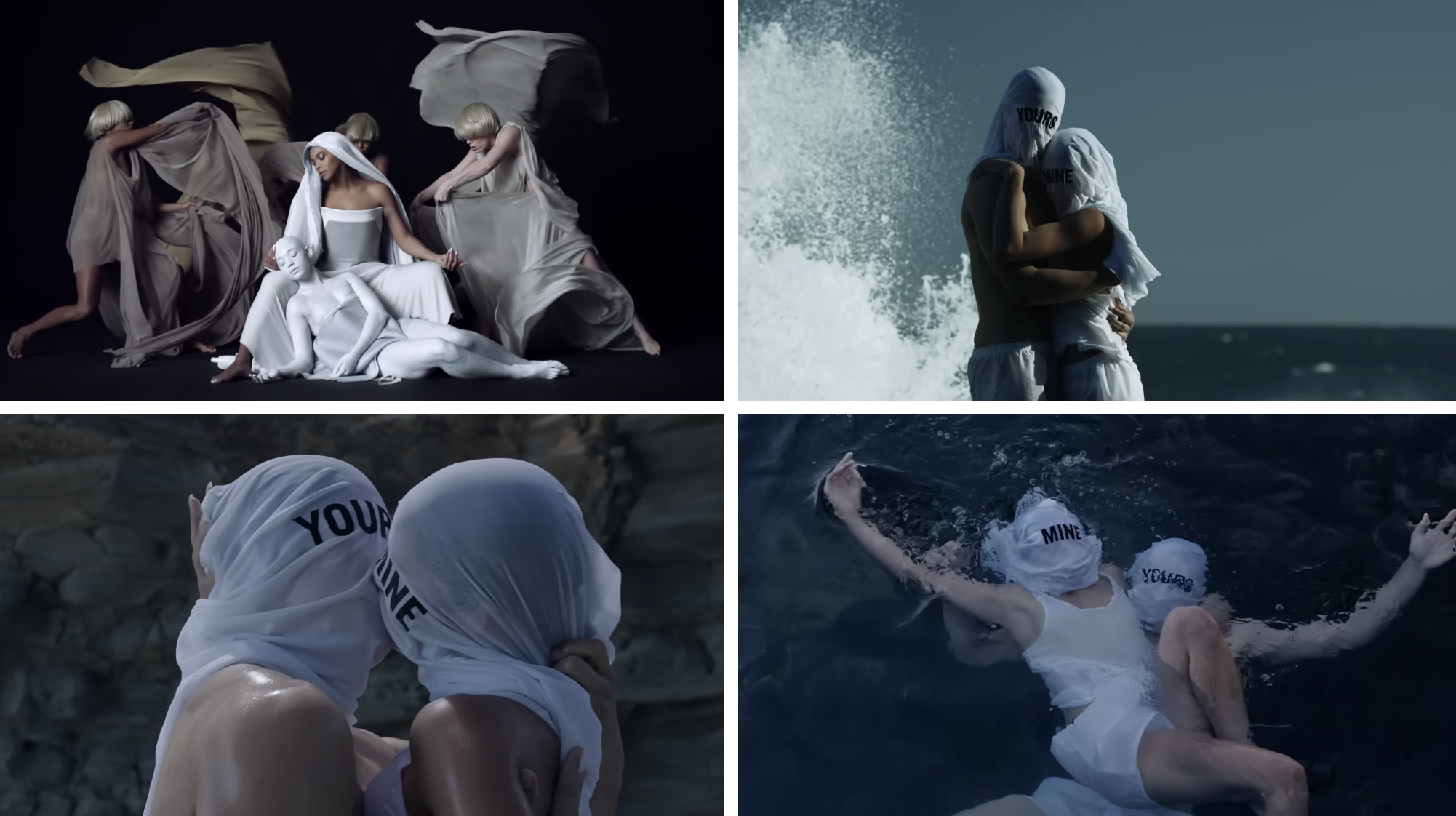
The video also references René Magritte’s The Lovers paintings (1928), two of which depict a couple with shrouded heads—standing cheek to cheek in the first painting, and kissing in the second. “The artist invokes the cinematic cliché of a close-up kiss but subverts our voyeuristic pleasure by shrouding the faces in cloth,” notes the MoMA, adding that “a barrier of fabric prevents the intimate embrace between two lovers, transforming an act of passion into one of isolation and frustration.”
Two dancers riff on these Magrittes in “Mine,” though Debusschere has them do so from different vantages of a rough coastline; while the ocean sometimes merely grazes them, they’re other times literally struggling to stay afloat.
But again, the song’s dual timelines are additionally united by Beyoncé’s stubbornness to keep forging ahead. “Fuck what you heard, you’re mine, you’re mine,” she repeats in the chorus, though throwing in a pointed reminder of her agency: “Long as you know who you belong to.”
In Vol. I, we talked about how press coverage of Beyoncé’s role in Dreamgirls tended to mention that she, like Deena Jones, had experienced the devastation of losing a talent competition early in her career. In 1992, the six-member Girls Tyme—an early iteration of Destiny’s Child—taped an episode of Star Search, acting as the challenger to the show’s reigning champion, a rock band called Skeleton Crew. (The episode would air in early 1993.)
“We met Beyoncé’s father at the weekly meet and greet,” Skeleton Crew’s Dan Hess remembered to People after the release of BEYONCÉ. “He told us, ‘My girls are gonna beat you.’ We later asked Beyoncé at a rehearsal if she was enjoying Disney World. She replied that her father wasn’t letting them visit until after they beat us.” But sadly for the “hip-hop rappin’ Girls Tyme,” as host Ed McMahon introduced the group in the episode, they scored three stars to Skeleton Crew’s four.
Beyoncé is the kid in lime green who performs for most of the song, and as she explains in the “Imperfection” chapter of Self-Titled, the loss was a formative moment in her childhood. “In my mind, we would perform on Star Search, we would win, we would get a record deal, and that was my dream at the time,” she says. “It’s no way in the world I would have ever imagined losing as a possibility.” At just 11—she says in her talking head that she was nine, but that’s why I’m here—she found her dream compromised, of all places, during a live television taping.
Aurally and visually, this day was used as the framing device for “***Flawless,” where Beyoncé orders the “bitches” of the world to “bow down” now that she’s Beyoncé. (The three asterisks seem to represent Girls Tyme’s three stars.) “All the defeats and hard times and losses that she’s had that felt like they were earth-shattering, in perspective, made her the warrior that she is today,” Todd Tourso would explain. “Because to her, it’s like, ‘I’ve been through all this. I’ve worked harder. I’ve suffered more.’”
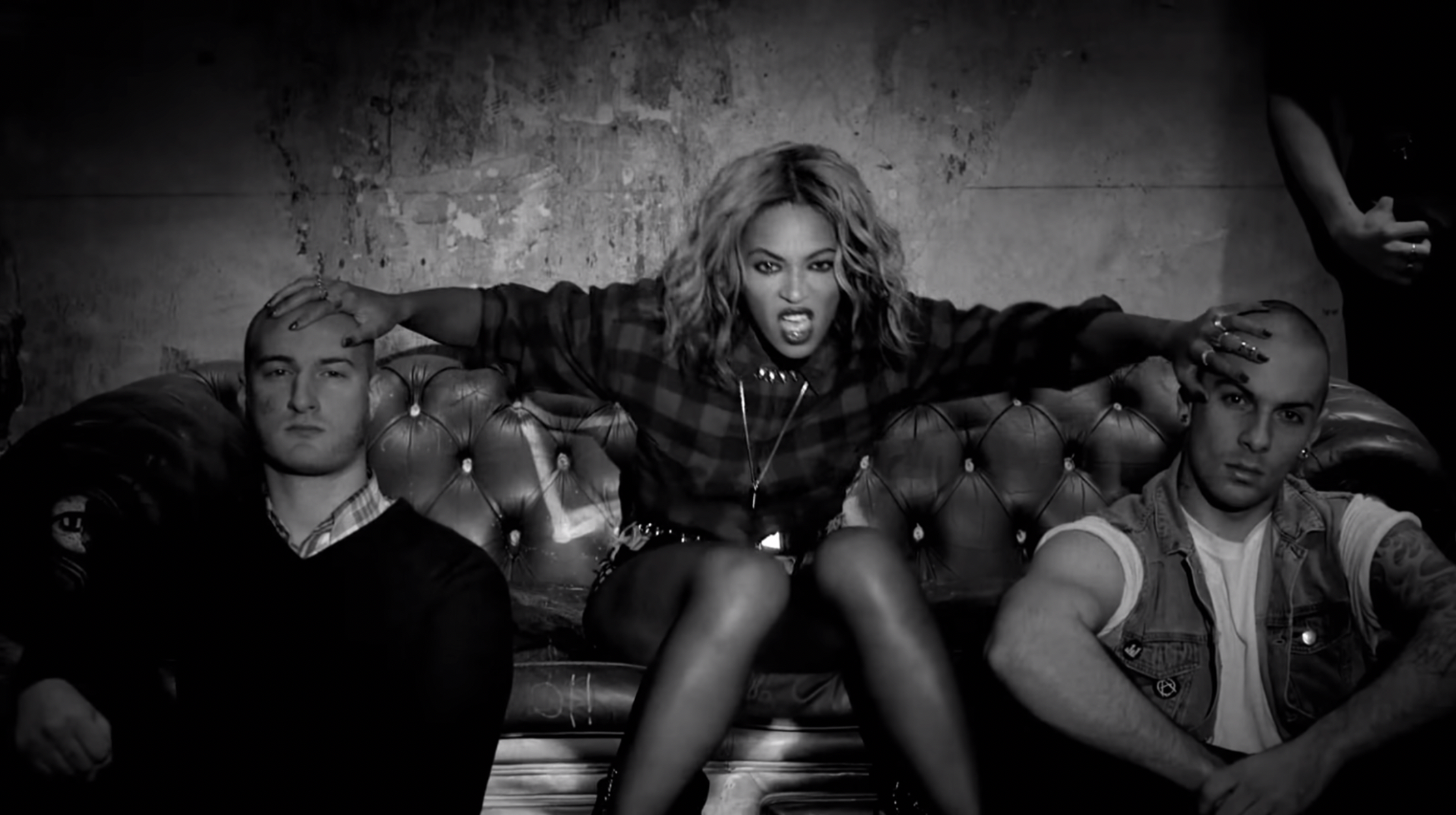
In the video, directed by Jake Nava, Beyoncé holds her own among skinheads in “a monastery that we art-directed to feel like a shitty underground club,” as per Tourso. But almost a full minute, as in the track, is turned over to a sample of a TEDx talk by Nigerian writer Chimamanda Ngozi Adichie, titled “We should all be feminists”:
We teach girls to shrink themselves, to make themselves smaller. We say to girls: “You can have ambition, but not too much. You should aim to be successful, but not too successful. Otherwise, you will threaten the man.” Because I am female, I am expected to aspire to marriage. I am expected to make my life choices always keeping in mind that marriage is the most important. Now, marriage can be a source of joy and love and mutual support. But why do we teach girls to aspire to marriage and we don’t teach boys the same? We raise girls to see each other as competitors. Not for jobs or accomplishments, which I think can be a good thing, but for the attention of men. We teach girls that they cannot be sexual beings in the way that boys are. Feminist: a person who believes in the social, political, and economic equality of the sexes.
This passage really doubles as a thesis for BEYONCÉ, bringing us from “Pretty Hurts” all the way to “Grown Woman.” Beyoncé tells us in the docuseries that she found it while “scrolling through videos about feminism on YouTube,” and it’s interesting to picture her doing this in the context of the incremental awakening we’d witnessed take place over the past year. (Visible on her 2012 vision boards is the poster for Spice World [1997], a girl-power classic.)
After the Big Lebowski monologue, Adichie’s speech was the second example on the album of Beyoncé identifying as a feminist by sampling someone else’s words. And its inclusion implicitly marked her ascent from hungry Girls Tyme member to boastful Queen Bey as a win for women, period.
In some ways, “***Flawless” makes up one half of the album’s toe-dip into capital-P Politics, the other track being the much less overt “Superpower.” The song is a doo-wop number featuring Frank Ocean, narratively about people who’ve realized that they’re stronger together than apart—realistically a romantic pair, but where the lyrics don’t specify as much. “I thought I could live without you / But together we got plenty power,” Beyoncé sings, providing the synopsis of her next album project.
The “Superpower” video, helmed by Jonas Åkerlund, takes advantage of the song’s lyrical ambiguity; we do see Beyoncé in a partnership, but it’s one set against the backdrop of some protest. The camera follows her as she slowly makes her way to a line of police in riot gear, gradually being joined by more and more people—her Mrs. Carter Show dancers, but also Pharrell, Kelly Rowland, Michelle Williams, and tour opener Luke James—until they form a collective strong enough to charge the cops.
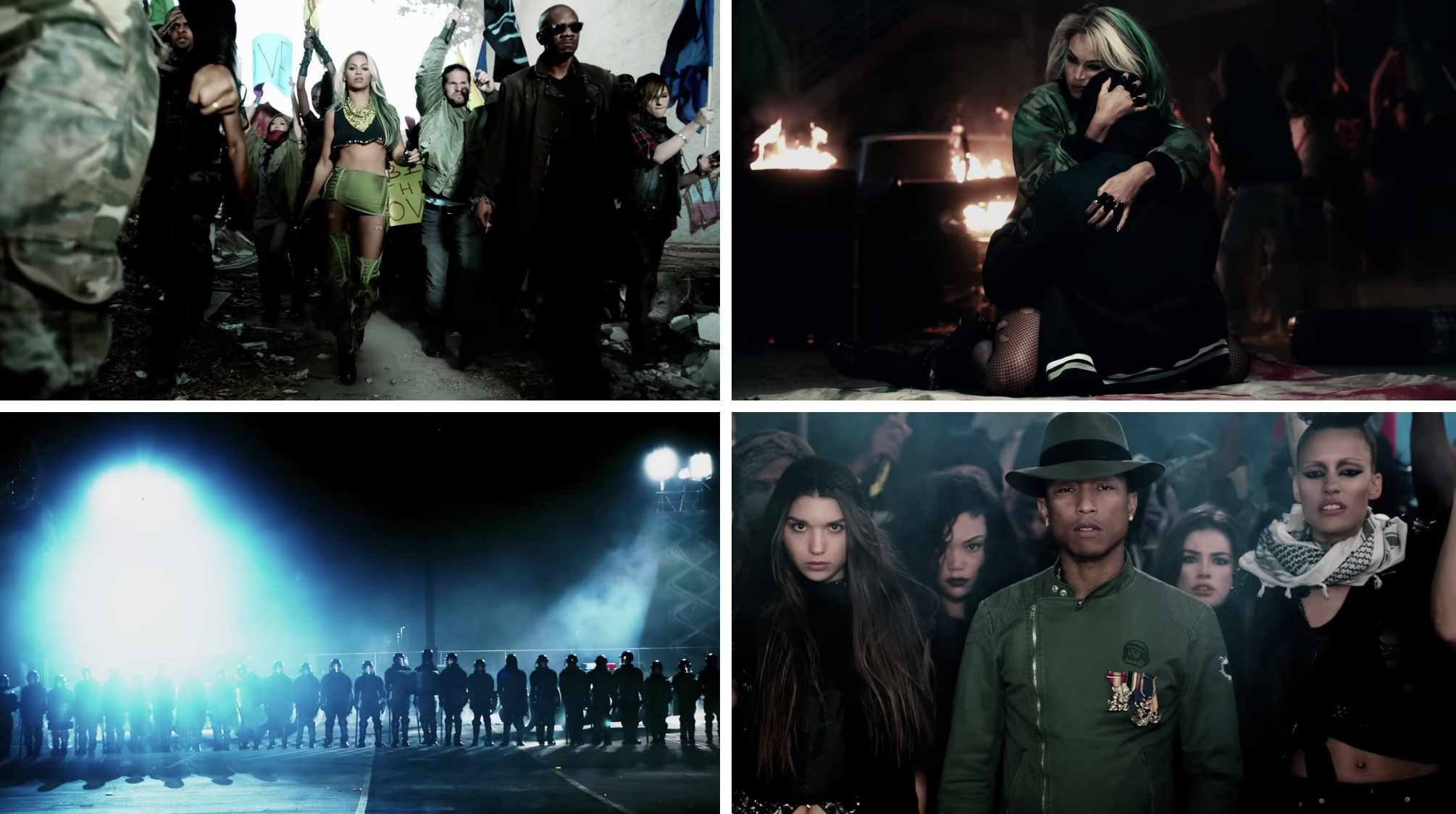
The imagery of “Run the World” hadn’t been dissimilar, but that video was conceptualized plainly around women’s empowerment, and Beyoncé had been careful not to arm her army of women. “Superpower” instead goes for a vague anarchist aesthetic—we see everything from camo, to gas masks and flare guns, to keffiyehs—that Åkerlund had actually used before. And as in his video for Jane’s Addiction’s “True Nature” (2003), it’s not terribly clear what’s being protested here. So more than anything, “Superpower” comes off as an ode to the revolutionary power of love.
But there are certain things about the video that unsettle that reading. One is that while Beyoncé leads a diverse group of protestors, she opted here for cameos exclusively from famous Black friends. Another is the Stars and Stripes-printed motorcycle jacket that we see at one point; American flags are never far from Åkerlund’s work—think back to the costuming and production design of “Telephone”—but this one still grounds the action in a particular setting. There’s also the repetition of “Yes we can” towards the end of the song, a phrase that Kevin Allred has argued is “now universally associated with the campaign of Barack Obama when he historically won the presidency in 2008.”
There’s a final detail that hindsight makes me feel confident attaching to any discussion of “Superpower,” and that’s Beyoncé having recently been vocal about the murder of 17-year-old Trayvon Martin in Florida the year prior. In July of 2013, following the controversial acquittal of George Zimmerman, she was uncharacteristically loud about her anger online, going on to hold a moment of silence for the slain Black teen at one of her shows and even befriending Martin’s parents. She also attended what seems to be her only on-the-ground protest as a public figure, joining a New York rally alongside several family members.
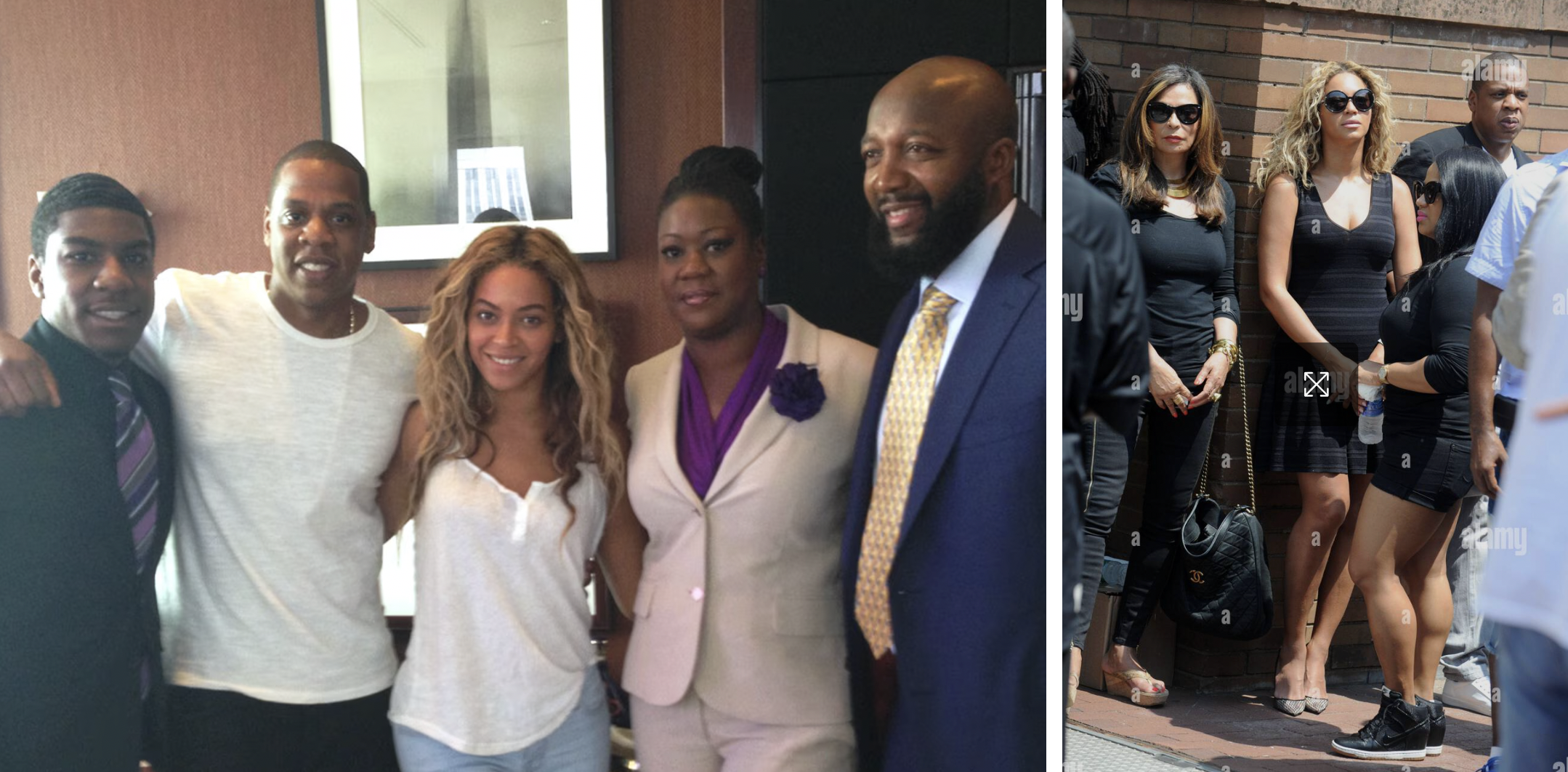
As with every aspect of her public life, Beyoncé had spent the first decade and a half of her career quite deliberate about how—and sometimes whether—she drew attention to her Blackness. The Guardian once summarized her approach during her ascent as “carefully apolitical,” and many have even invoked the term post-racial in their analyses of her star persona. Writing in 2011, scholar Farah Jasmine Griffin argued, “That [Beyoncé] seems neither angry nor tragic, that she did not rise from material poverty, that she is never heard lamenting the options available to her because of her race: all make her a pop diva of and for our times.”
Pursuing this project, I’ve witnessed a number of interviewers try to get an inflammatory pull-quote from the star about racism, but she never takes the bait. “I can’t compare,” she said when asked in the late ’00s whether she related to Etta James’s struggles coming up in music. Posed the same question about Dreamgirls and Motown-era stars a little earlier, she’d told Jonathan Van Meter, “My father had to fight those battles. I didn’t. And now I’m large enough—I’m universal—that no one’s paying attention to what race I am … I’m past that.” She’d later echo this sentiment to Piers Morgan while promoting 4, saying, “I don’t think people think about my race. I think they look at me as an entertainer and a musician.”
Overall, the “Superpower” video played things similarly safe—it didn’t set out to alienate anyone—but it nevertheless demonstrated a slight shift in tone from something like “Run the World” two years prior. It was an artistic in-between moment suited to the personal in-between moment seemingly happening offscreen.
Following this political interlude of sorts, we enter a two-track meditation on death and life, in that order. First comes “Heaven,” whose chorus has Beyoncé addressing a deceased loved one whom, as per the song, heaven couldn’t wait for. It’s often interpreted to be about the miscarriage we’ve discussed, and the lyrics give weight to that interpretation. “I fought for you the hardest,” the star sings. “It made me the strongest.”
But as Todd Tourso, her co-director on the video, has explained:
Her main inspiration for that song and that video was watching her mother lose one of her best friends. So Beyoncé’s treatment … was juxtaposing this gut-wrenching sad song with really happy visuals of two girls … and then at the end of the video you find out that it was one of the girls’ bucket lists, and she’s actually dead.
For “Heaven,” Beyoncé enlisted longtime dancer Ashley Everett to play her best friend. The two pray in a Puerto Rican church while we see flashes of them together in different contexts; how much is remembered versus imagined isn’t spelled out. The two friends get drunk and jump topless into pools, they get matching tattoos, and they celebrate milestones like marriage and babies. The video ends with audio of Parkwood’s brand manager, Melissa Vargas, reciting the Lord’s Prayer in Spanish over footage of the duo hiking; the moment is paired with a disorienting strobe effect that makes it feel as though we’re suspended between two worlds, perhaps that of Beyoncé’s character and that of her lost pal.
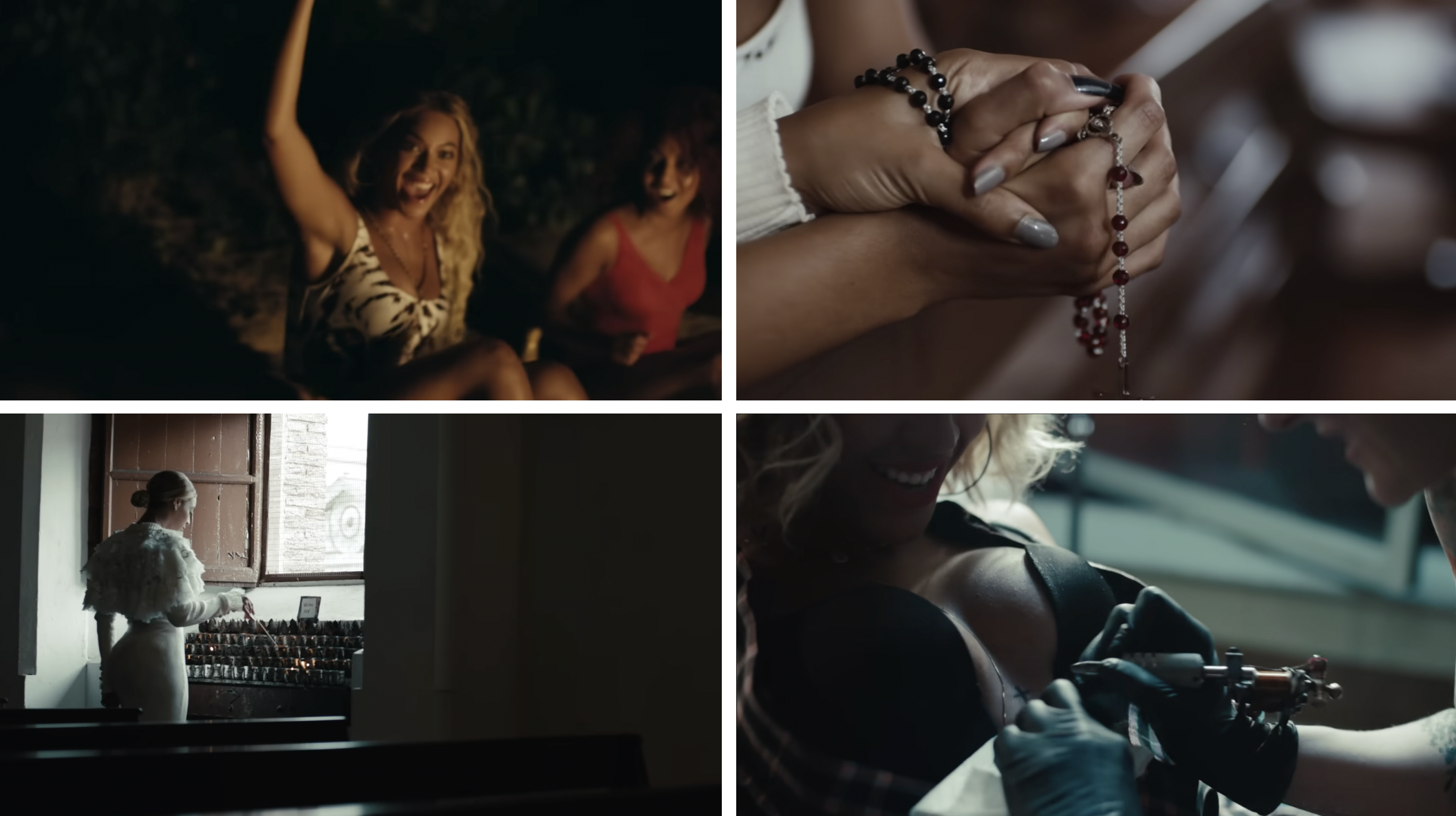
It occurred to me while working on this chapter that Ms. Tina’s unidentified best friend may have been her nephew (and Beyoncé’s cousin) John Rittenhouse, known to most people these days as Uncle Johnny—and of course, more on him in Vol. IV. During the B’Day era, 25-year-old Beyoncé had appeared on the cover of the gay men’s magazine Instinct, and was asked how she felt about the way “some religious groups”—including her own, the question made clear—“categorize gay society.” Her response was quite personal:
I was raised by my uncle who passed away with AIDS a couple of years ago. He was my mother’s best friend … He made my clothes with my mother. He was like my nanny. He was my favorite person in the world. And you know, I never really mixed Christianity with how I felt [about him]. I am about faith and spirituality more so than religion. Doing right by others and not judging.
If losing Uncle Johnny really did inspire “Heaven,” then it might be especially meaningful that the video largely takes place in and around an old church. As Everett told VIBE, “The scene [where] we’re praying in the church implies that I am either sick or [in] some way I know that I’m going to go.” She dances in the chancel for much of the video—until she slowly sinks to her knees towards its end, losing some kind of battle.
This official concept, however, need not cancel out other readings of the song. It won’t be an accident that the next video is “Blue,” where Beyoncé—co-directing again with Ed Burke and Bill Kirstein—sings of her gratitude for her firstborn while playing with her on a beach in Brazil. Most of the video was shot docu-style and conspicuously on film, paying as much attention to locals on the streets of Rio de Janeiro and Trancoso. (Said conspicuousness is why I happened to notice recently that separately-filmed digital footage of Jay-Z has been stealthily spliced into the beach sequences.)
Another reason not to abandon the miscarriage reading of “Heaven” is Beyoncé’s vision boards. The star, a noted Game of Thrones fan, seems to have had an entire panel in her studio devoted to Daenerys Targaryen. This was an appropriate reference for an artist playing around with regal aesthetics, of course, but one of the images Beyoncé chose to print out and display is from a scene early in the series where we see Daenerys drenched in blood after eating a raw stallion heart during a pregnancy rite.
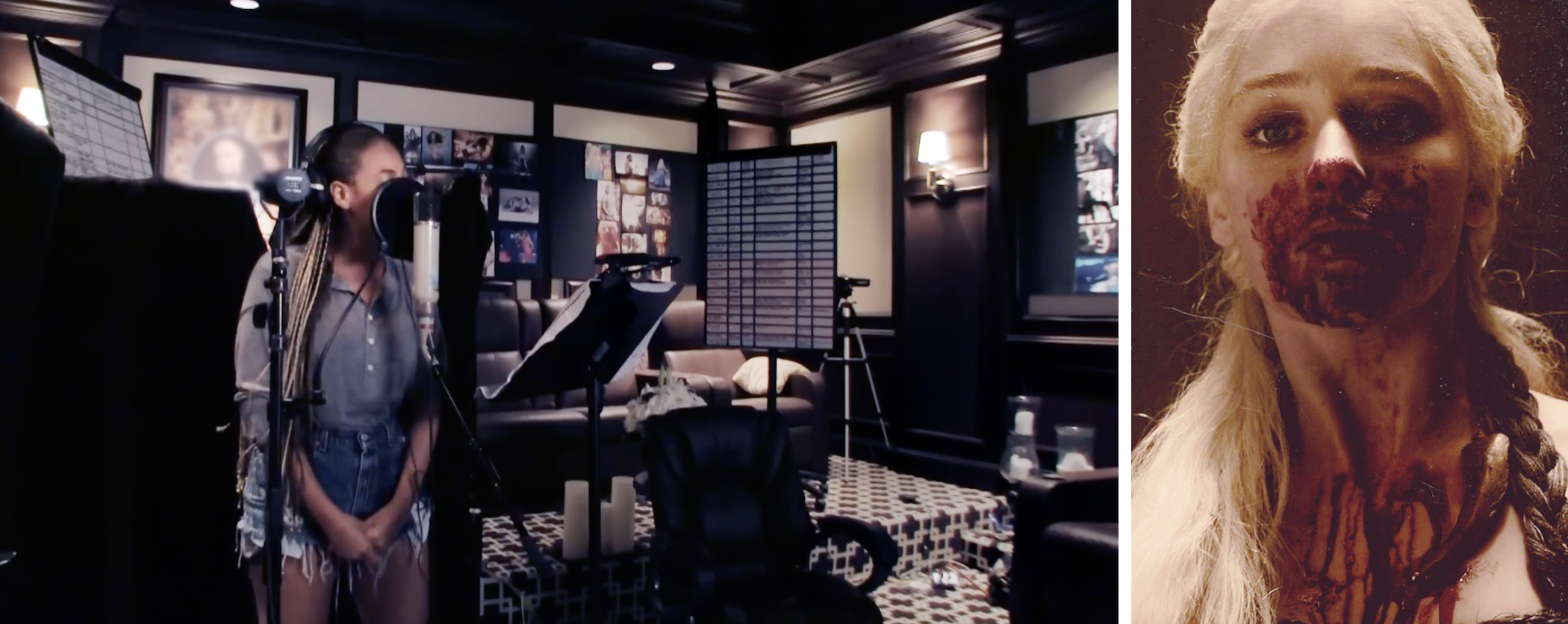
Though the future Mother of Dragons succeeds at this disgusting task meant to ensure a strong and healthy baby, she loses her child anyway. You can read whatever you’d like into the photo’s proximity to Beyoncé while she recorded her album, but I’d argue that it at the very least imbues her vision of motherhood with a sense of warriorship. And it certainly makes a lyric like “I fought for you the hardest” land differently.
If you listen to the album on its own, “Blue” is how it concludes; as in Life Is But a Dream, this baby girl is Beyoncé’s reward for her trouble. The visual album, though, follows “Blue” with a bonus video for “Grown Woman,” the one shot with Jake Nava before the start of the Mrs. Carter Show.
Trophies had first appeared in the album’s opener, “Pretty Hurts,” as something that Miss Third Ward both craved and was happy to violently destroy, but they’ve seemingly evolved into something else by the project’s end. Four videos in, Beyoncé brings one to the beach with her for “Drunk in Love,” holding it for the first two or so minutes while she makes her way through the first verse.
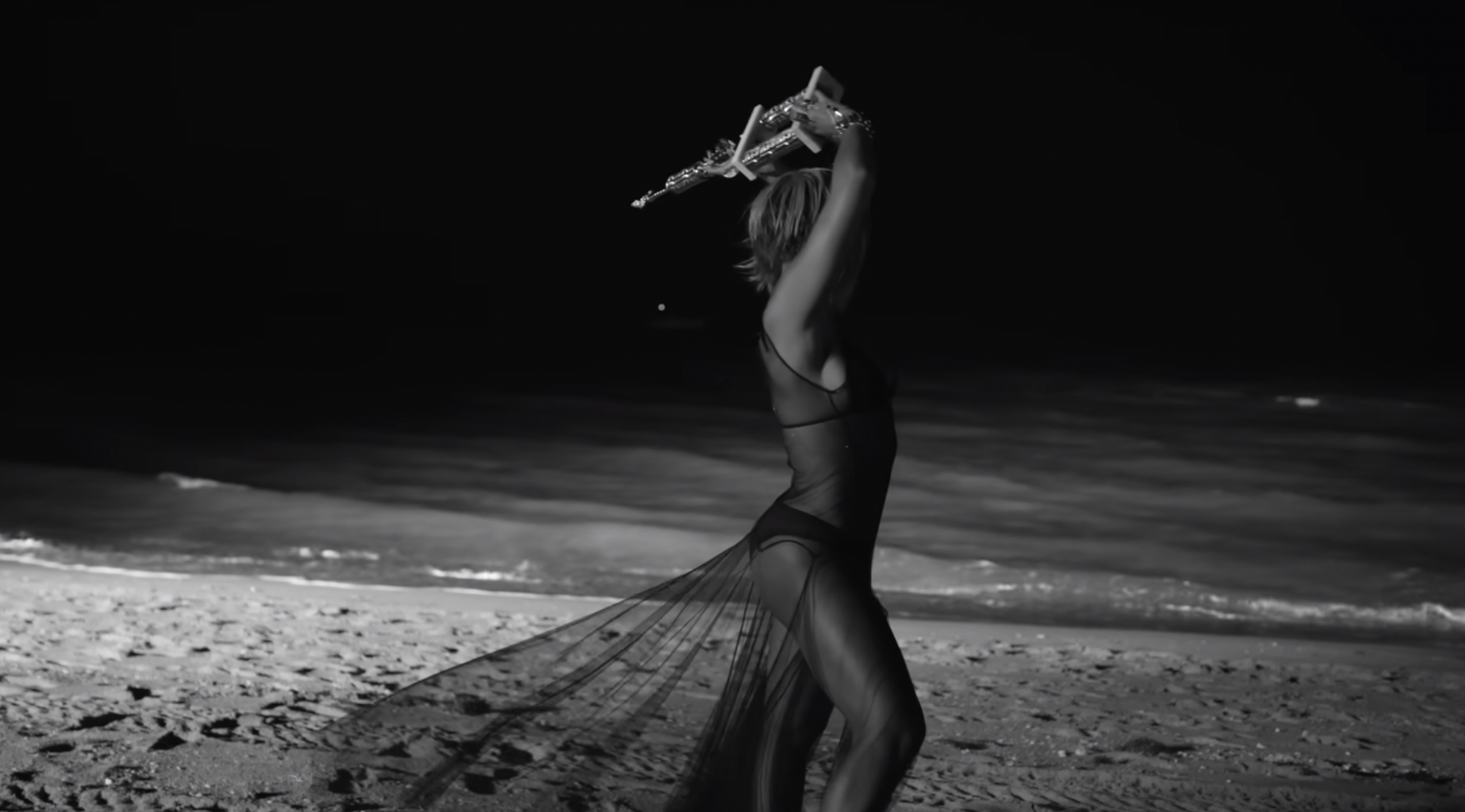
The meaning behind this trophy is neither obvious nor explained in the docuseries. Perhaps it helped hammer home that this—not the fictional Miss Third Ward—was the actual adult version of the kid we saw accept that award in Houston, that any fun Beyoncé might be having here with her husband (or on BEYONCÉ more generally) was hard-won, decades in the making. I also like how Aimee Cliff has characterized this moment, calling it a “hangover” from “Pretty Hurts”:
The question of what fame does to a person hangs heavy over the whole album—trophies aren’t necessarily symbols of success but of unrealistically perfect little women set in gold—and it’s a sweet touch that once Jay turns up Bey is unconcerned with her trophy and instead just wants to dance around drunkenly with her man.
Indeed, the trophy disappears for the rest of “Drunk in Love,” and I don’t believe we see another until “Grown Woman.” Tracklist-wise, this nicely parallels something the star says in Heinzerling’s docuseries. “I have a lot of awards,” she explains:
And they’re amazing … I worked harder than probably everybody I know to get those things. But nothing feels like my child saying, “Mommy.” Nothing feels like when I look at my husband in the eyes. Nothing feels like when I’m respected, when I get on the stage and I see I’m changing people’s lives.
With this comment, Beyoncé has essentially just summarized videos five through 16, all trophy-free.
Nevertheless, we return to the motif in “Grown Woman,” almost as if to finally get on top of it. Jake Nava’s video is several things at once: powerful, technologically ambitious, slightly bloated, and occasionally a little creepy. It begins with home-video footage of Beyoncé on the same day that Mathew recorded all that other stuff of her playing around with her cousin, the one that figures heavily in Life Is But a Dream. Here, the two kids seem to be performing for their families—as little girls have done at dinner parties since time immemorial—in the living room of the Parkwood house.

We then cut to an adult Beyoncé recreating the aforementioned photo of her in front of her trophy-bedecked fireplace—still wearing a pink dress but, as Susannah Sharpless has summarized, “This time she’s cocky, confident, holding a drink, crown perched sloppily on her head.”
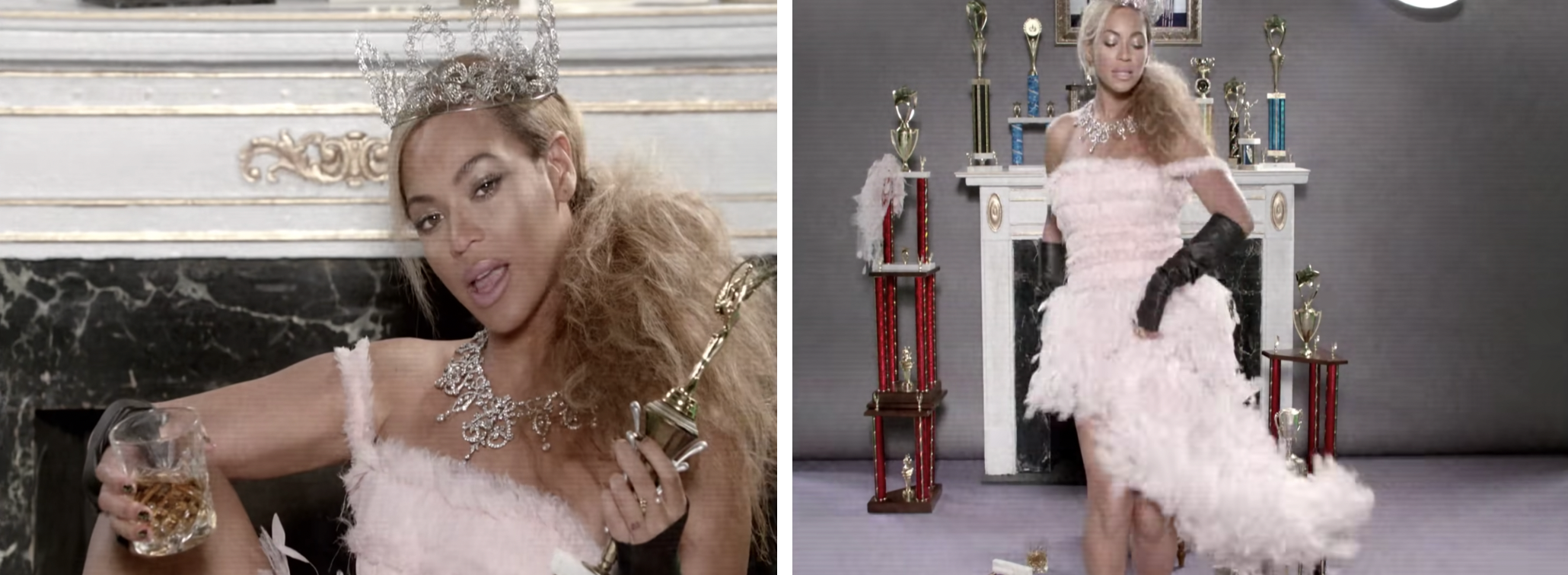
As she begins the song, it feels almost like she’s referring to all the ’80s and ’90s material we’ve seen throughout the project:
I remember being young and so brave
I knew what I needed
I was spendin’ all my nights and days
Laid back daydreamin’
Look at me, I’m a big girl now
Said I’m gon’ do something
Told the world I would paint this town
Now betcha I run this
If there was a sadness to how she’d spoken of her childhood sacrifices while discussing “Pretty Hurts”—Is it worth it?—it seemed that she’d ultimately chosen to embrace the obvious silver lining: she’d gotten here anyway, and there was plenty of fun to be had. Lyrically, “Grown Woman” rattles off all the things Beyoncé has earned the right to do now that she’s grown: be bad, do wrong, live fast, go slow all night long. The song isn’t about girlbossing in the sense that “Run the World” was, but rather her all-around realization as a woman; the two verses beyond the one printed above revolve around her sense of self and seduction abilities, respectively.
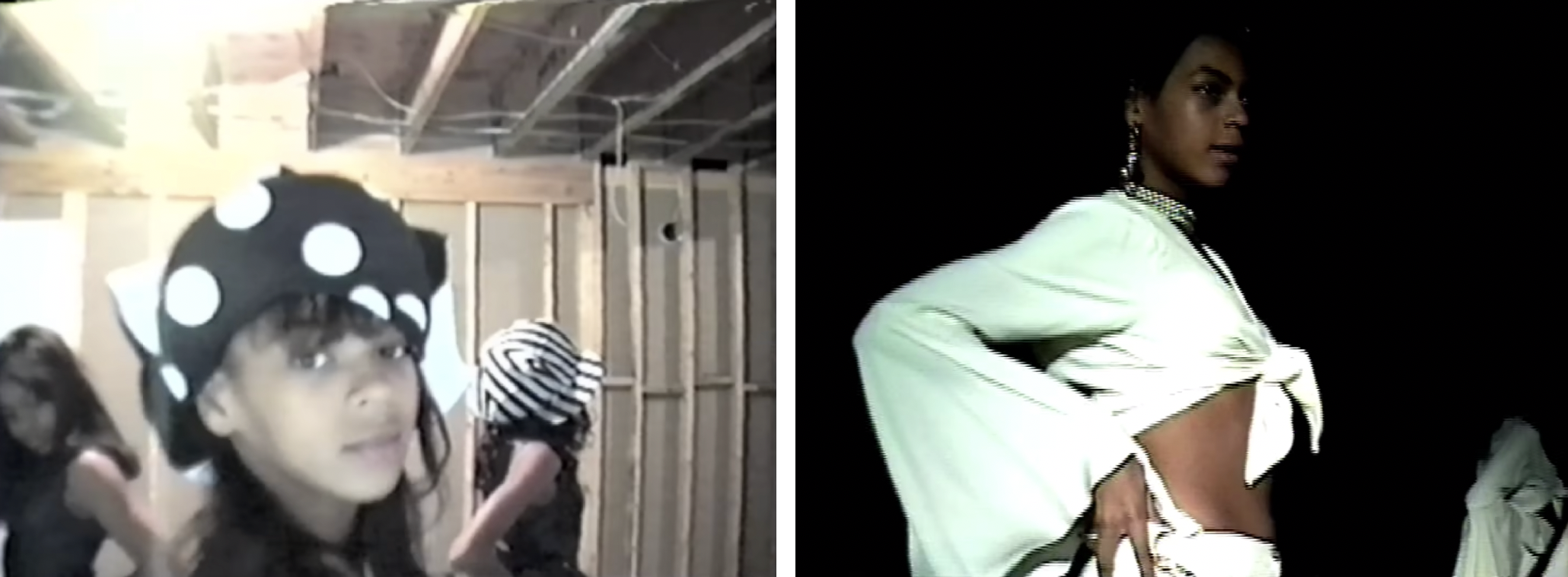
Visually, most of “Grown Woman” is concerned with connecting, and sometimes blurring, Beyoncé’s child and adult selves—again, as if to stress that this is all one person, one journey. There’s lots more home-video footage of the star as she trains to be a champion, none of it new if you were caught up with her visual projects, but now her mouth has sometimes been digitally altered to be singing “Grown Woman,” the effect somehow both awkward and uncanny.
Other shots have Beyoncé and Kelly Rowland made up to look like teenagers in the ’90s, on one occasion edited right into footage of their 20-years-younger selves. On another occasion, there’s split-screen so that Beyoncé can dance alongside the same video of her kid self as she had onstage during the I Am… World Tour. And on yet another occasion, there’s a bizarrely convincing set-up of her dancing among friends in her ’90s bedroom, though really filmed on a set earlier in 2013. The video speaks not only to a life spent performing but, as Sharpless puts it, “a life taken place in front of a camera,” with Mathew having likely captured all the genuine material.
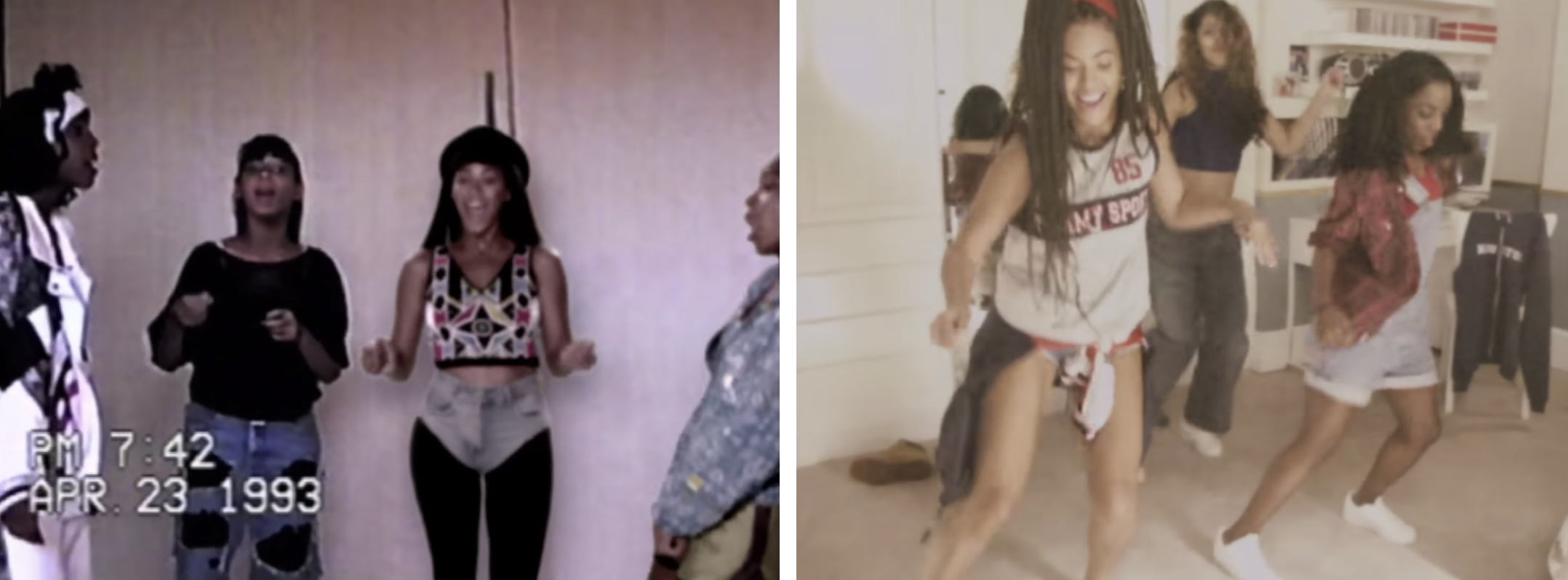
Suddenly, we follow Beyoncé through the mirror of her fake bedroom—out of 3346 Parkwood Drive, if you will—and into a dreamworld unmistakably of her 30-something self’s making. (The aspect ratio widens mid-shot, as if life has literally expanded.) Now in the leotards and full-scale glam we’d expect from her after this time jump, she dances in front of computer-generated graphics—colourful, geometric, Africa-inspired in the manner of some of her tour visuals—for two whole minutes, the lyrics by this point simply “I’m a grown woman / I can do whatever I want” on repeat.
After all this relishing, “Grown Woman”—and thus BEYONCÉ—ends with two memorable shots. In one, the star poses with Ms. Tina, the two women looking not just queenly but contented, finally out of their different but interconnected doldrums. In the other, Beyoncé poses rather prophetically with three babies, one of them surprising her by coming in for a kiss.
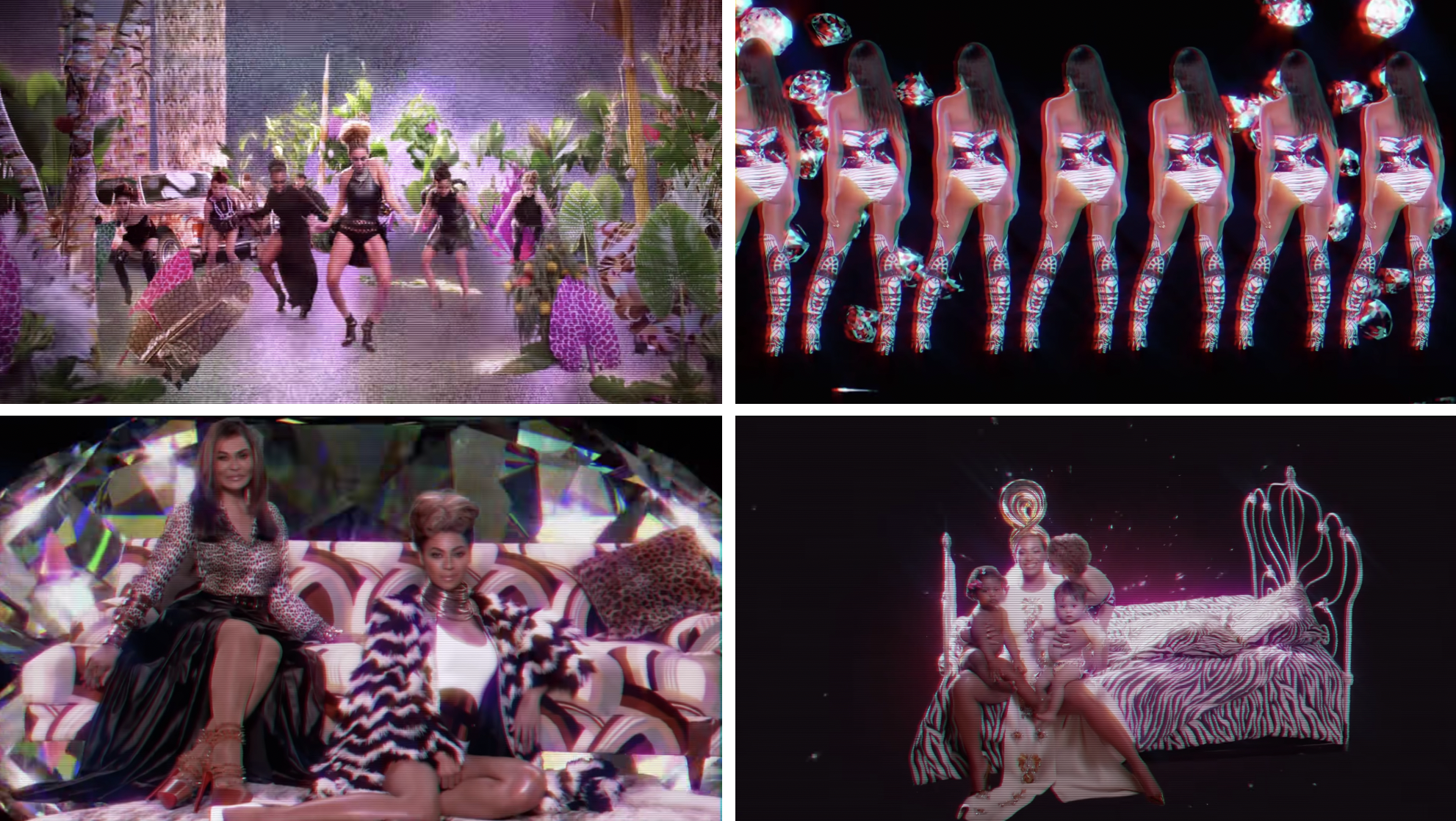
Much of the video’s first half had given us a promising young talent under her father’s tutelage, and as seen through his actual videographic gaze. But now that she was grown and could do whatever she wanted, she’d chosen to have all that dad-captured footage build up to what’s ultimately a celebration of Black womanhood and sisterhood—Rowland appears in this dreamworld, too—with an arguable emphasis on Black motherhood.
Whether you end the album here or a track prior with “Blue,” it’s the girls and women of Beyoncé’s family, both biological and chosen, whom she’d made the heroes of her journey.
In coverage of the visual album, there were a couple of names that seemed to come up like no other. The first was Prince, whom Beyoncé had mentioned as a reference for the project at the top of the year. But the Purple One had also long been associated with her—because they’d performed together at the Grammys in 2004, because they’d always spoken highly of each other thereafter, and because they’d competed for the same Golden Globe in 2007.
The name that felt a bit more surprising for Beyoncé’s artistic universe—beyond the fact that they’d both done original songs for Austin Powers movies, of course—was Madonna. I began Vol. II with the 20-year-old Destiny’s Child frontwoman giving the Queen of Pop kudos, though I’d actually omitted a funny line in that Soul Survivors (2002) passage. Listing some of the ways Madonna has spun professional obstacles into cold hard cash over the years, Beyoncé includes the 1985 nude scandal that hit relatively early in the older star’s rise.
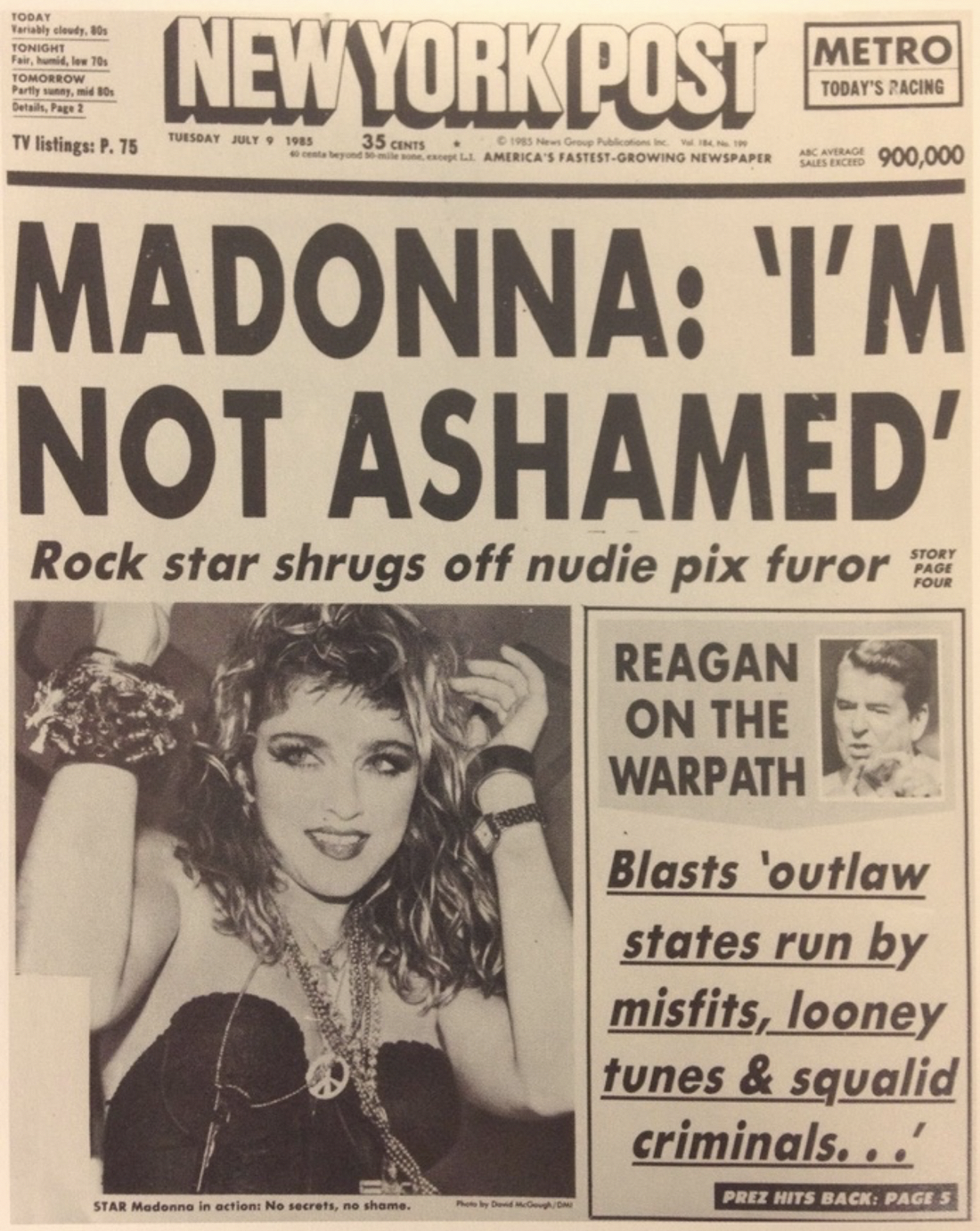
While another celebrity may have feigned mortification and apologized, potentially crashing the ship before it was out of the harbour, Madonna saw an opportunity to practice what she planned on preaching for the next four decades. As Beyoncé writes, “her response was something like ‘Yeah, I did. And?’”—letting her body stoke cultural discussion about sexuality and shame, and becoming the first woman to sell five million copies of an album in the US anyway.
Nevertheless, the 2002 compliments are followed up with a figurative asterisk: “For the record, though, I would never pose nude.” If Madonna had influenced early-career Beyoncé, it was simply about knowing good business sense when one saw it.
A little over a decade later, Beyoncé did something spiritually similar while promoting Life Is But a Dream. Madonna had come up during her interview with the Gentlewoman, since the stars were united in producing their own docs and running their own companies (though I should say that Maverick Entertainment wasn’t behind the groundbreaking Truth or Dare [1991], released a year before the company’s inception). “I think about Madonna and how she took all of the great things she achieved and started the label and developed other artists,” Beyoncé said:
It’s a different personality and a different approach … But we’re doing the same thing … I always ran my stuff, since we were 15 years old. Now I’m controlling my content, controlling my brand and archiving it for my daughter and making sure she has it and she respects it … You see these male artists that become moguls, and the female artists might become legends, but there’s not enough of us that become moguls.
While no one would necessarily argue that she had a different personality and a different approach from Madonna, the visual album she went on to produce did complicate the claim a bit. For one, BEYONCÉ was by far her most sexually explicit project, with several critics comparing it to Madonna’s AIDS-era concept album, Erotica (1992). Perhaps just as Madonna-friendly, though, it contained the kind of sexual provocation that got people talking; in the weeks and months after BEYONCÉ’s release, fans and detractors alike would cite the project’s bawdiness in their debates about Beyoncé endorsing feminism.
But it wasn’t merely the sexiness that had begged the comparison; aside from the Gothic elements and involvement from certain frequent Madonna collaborators, several entries in the visual album seemingly nodded to specific Madonna videos. “Haunted” came off like a tribute to “Justify My Love” (1990), whose headline-making distribution saga Beyoncé had mentioned admiringly in 2002. The newer video also recreated a shot from “Hollywood” (2003), having a model pose on top of a TV set with legs akimbo just as Madonna had.
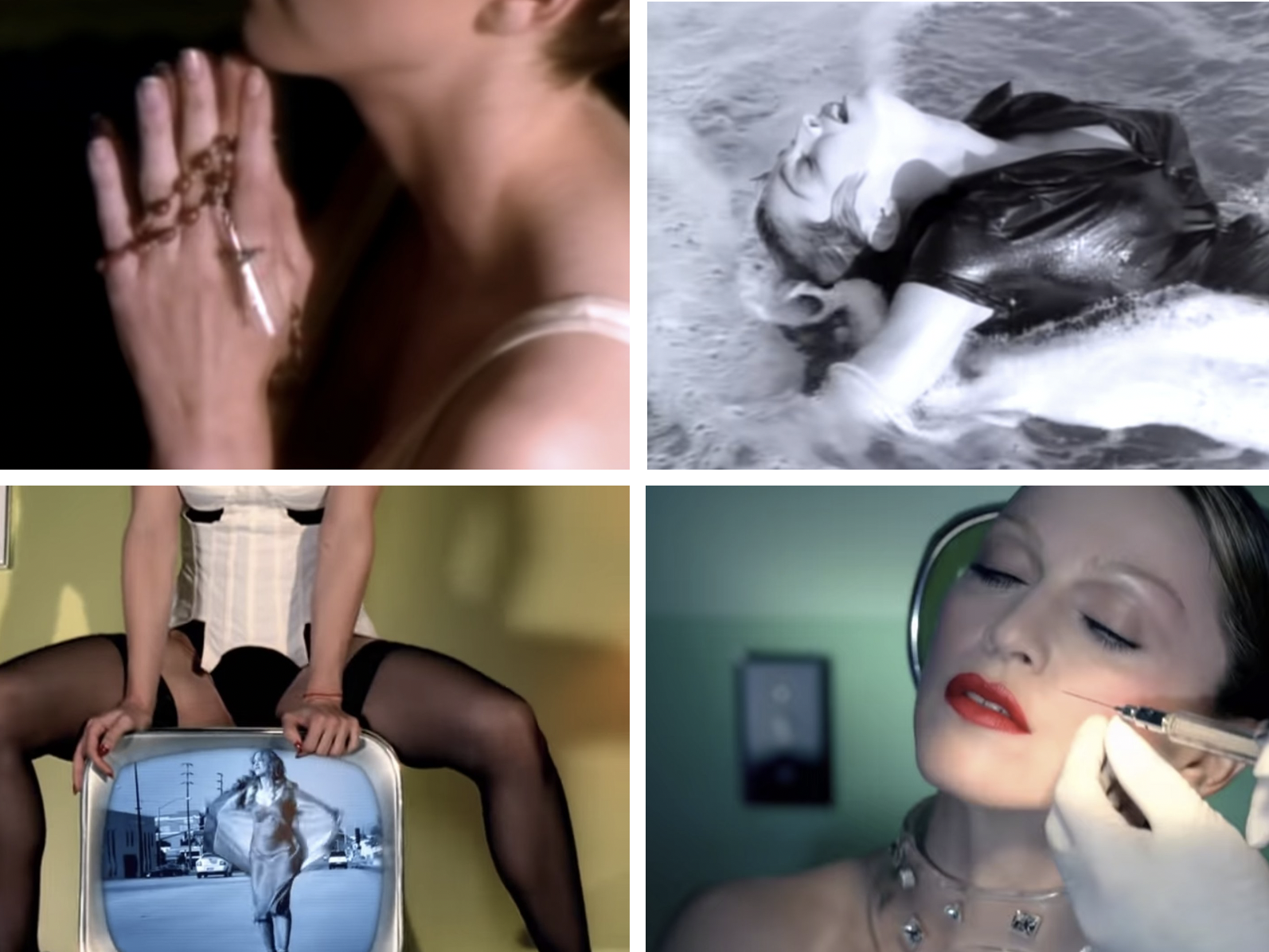
“Drunk in Love” was confirmed to have been inspired by Herb Ritts’s work, which meant that people weren’t imagining a resemblance to his video for Madonna’s “Cherish” (1989), where another short-haired blonde writhes around on the beach in a black ensemble. And there were a couple of other videos on the visual album—“Pretty Hurts” and “Heaven” come to mind—that featured shots more than a little reminiscent of Madonna’s videography.
If there’d supposedly been some kind of wild artistic gap between the two women, or if it had made more sense in specific moments for Beyoncé to gesture to one, it had clearly narrowed by December of 2013. It was only days after BEYONCÉ’s release, after all, that she name-checked Madonna at a screening/Q&A event held in support of her project. In response to one question—all had been sent in via video and chosen ahead of time—she again alluded to Maverick. “When I decided to manage myself, it was important that I didn’t go to some big management company,” she told the crowd:
I wanted to follow the footsteps of Madonna and be a powerhouse and have my own empire, and show other women, when you get to this point in your career, you don’t have to go sign with someone else and share your money and your success; you do it yourself. So I found a team of underdogs—a team of women, a team of people that no one believed in—and we worked together, and we stayed up all night, and we were progressive, and we did not follow the rules.
The success of BEYONCÉ came back in large part to its air of rule-breaking, both actual and imagined. As the star put it at her screening event, “I’ve never done anything so brave in my life.”
The project was the work of a woman still figuring things out, and who’d excused herself from her usual perfectionist impulses while she did so. In the third part of Self-Titled, “Run ‘N Gun,” she explains that she “wanted to carry this idea of being in the moment, and embracing mistakes and effortlessness.”
There are several moments you could cite if you wanted to argue that this was the project’s greatest asset. Lots of visual magic came out of so much room being made for spontaneity and improvisation—charming encounters Beyoncé has with Average Joes on the street, say, or quick-but-indelible details like Joan Smalls’s “Yoncé” lick. A bunch of interesting studio-related trivia also resulted from this approach, like how the star had a sinus infection while recording “XO” but liked how it sounded, or that she improvised the first verse of “Partition,” or that “Drunk in Love” came together while really drinking among Jay-Z and friends.
One might instead—or also—argue that this looseness led to some questionable decision-making, particularly for an artist loudly embracing feminism. To their apparent disappointment, Monica Lewinsky (in that improvised “Partition” verse) and Tina Turner (in that alcohol-aided “Drunk in Love” session) both found past traumas repurposed as jokey lyrical fodder. And though Beyoncé wasn’t by any means the only big name to work with Terry Richardson in 2013, the now-disgraced photographer was in fact a known creep by then.
Other creative choices have aged strangely for less predictable reasons, but the overall range here speaks to both the beauty and danger in not wanting to spend too much time vetting or refining.
Of course, the album has been overwhelmingly discussed in the context of its many wins and innovations, even if Beyoncé and I may have slightly different ideas about what those were.
Most critics agreed that BEYONCÉ was her boldest album yet—so if its arrival had initially struck some as gimmicky, they’d generally gone on to be impressed by the art. But the surprise drop had indeed been excellent for business: within 72 hours, Apple issued a statement that it was “the fastest selling album ever on the iTunes Store worldwide with an unprecedented 828,773 albums sold in just its first three days.” In the years to come, many other huge artists would try their hand at surprise releases, and the global music industry would adopt Friday as its release day of choice.
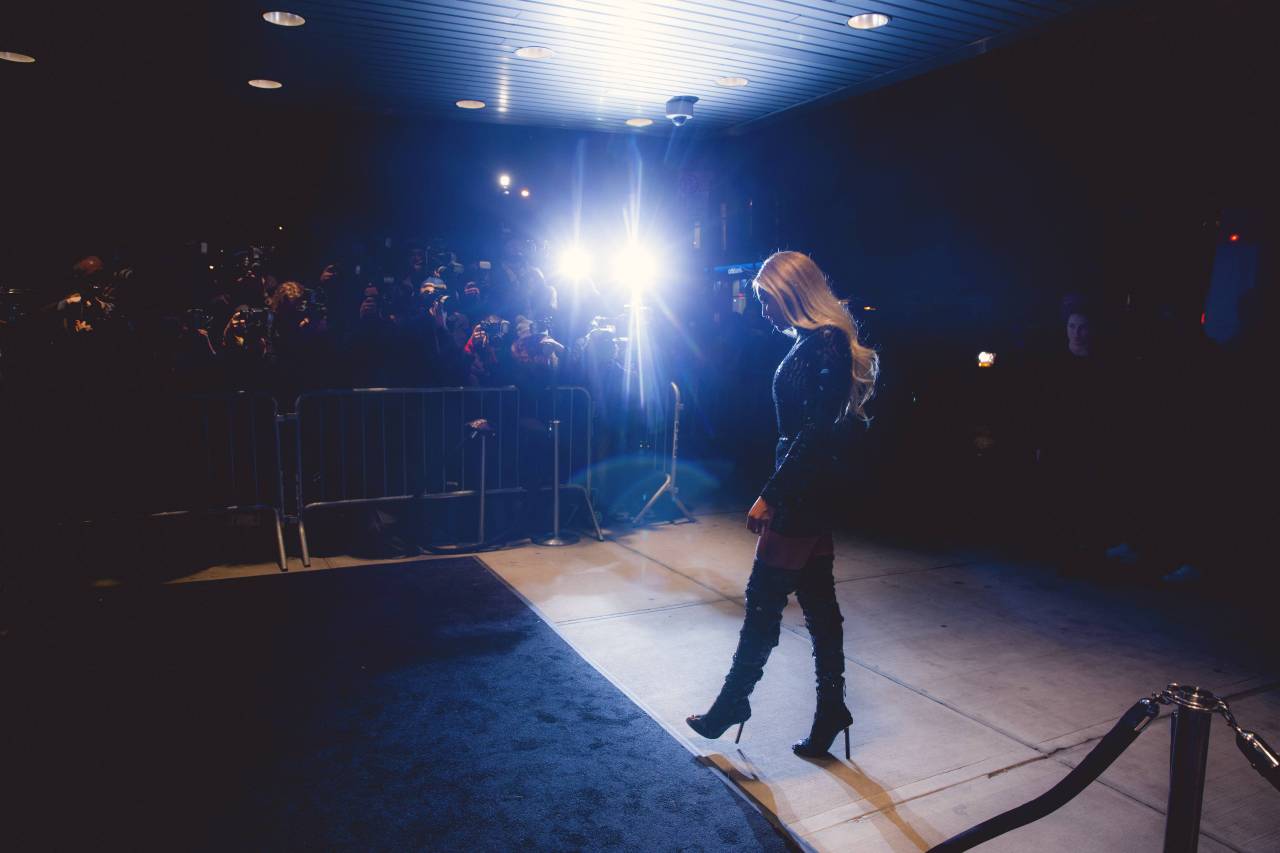
But let’s get into some of the weeds. In the first chapter of Self-Titled, the star reminisces about watching “Thriller” on TV with her family as a kid, and suggests that she hoped to create her own sort of music-video event here—something “immersive” that might bring folks together around their own screens. Anecdotally, she seems to have achieved this in spades: I mentioned that my first instinct upon the album’s release was to flee my first-year common room like a fugitive, but it wasn’t long before several of my floormates began screening and discussing bits of the visual album together, something we’d do well into 2014.
If you can picture half a dozen 17- and 18-year-old girls crammed into a dorm room to huddle around just one laptop, I suddenly found myself in that arrangement with some regularity. Though most of us were virgins, we were especially taken with the project’s more sexual entries, sitting there for countless minutes giggling and thinking and—perhaps most significantly—talking about sex, and feminism, and power. Only a couple of us would have even identified as Beyoncé fans, but everyone was curious to see this project that had caused so much commotion on their news feeds. Barring the Mrs. Carter Show, never before had I engaged so communally with the star’s art, and rarely have I gotten to since.
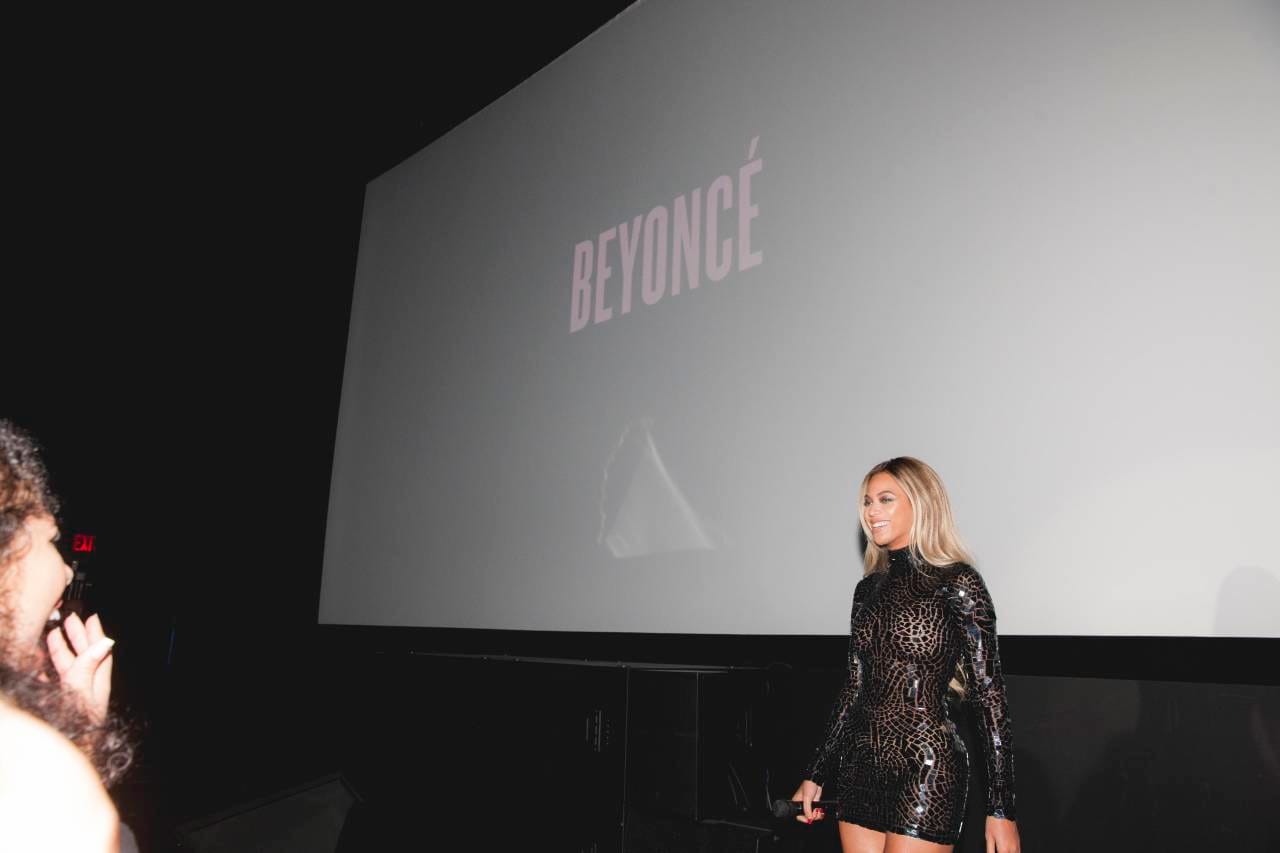
Another unequivocal win for Beyoncé, especially given that this was very much the iTunes era, was the whole all-or-nothing aspect of the project. “While not a concept album,” Parkwood wrote in its press release, “the record is designed to be consumed as a comprehensive audio/visual piece from top to bottom.” Several sources in my research argued that this detail, in addition to engendering respect for an unfragmented work of art, was particularly empowering as a woman in pop; in forbidding the public from picking and choosing among BEYONCÉ, the star had forbidden them from picking and choosing among Beyoncé.
“She is a woman and she’s a sexual being and she’s a mother and she’s a feminist,” Melina Matsoukas said:
She’s emotional and she’s vulnerable, but then at the same time she’s powerful. Each video cannot stand in isolation, you know? … So I know it’s important to her for people to hear and see the entire body of work at once. And she made you do that.
Nevertheless, BEYONCÉ is a project where it’s wise to untangle some of the fact from the PR spin (and perhaps stan lore). There were stretches of the official press release to regard with at least some skepticism, like the claim that the album was “stripped of gimmicks,” or that it was Beyoncé’s “first visual album,” or that she’d entirely circumvented leaks with a “fully designed preventative plan.”
But I should say more about the whole visual album thing in general, given how much of the rest of this series revolves around the format. As discussed in Vol. I, Beyoncé had given B’Day a belated full-length visual accompaniment in the form of her B’Day Anthology Video Album, and she’d said while promoting the project in 2007 that it had “never been done before.”
This was false by basically any metric; popular musicians—including people Beyoncé has looked up to, collaborated with, and even married—have churned out ambitious long-form visual companions to their albums and EPs since the rock takeover in the mid-20th century. And I’ve actually seen “visual album,” the term she’s favoured since 2013, used to describe various music films and video packages released since the ’70s or so, both by journalists and by the artists in question. Case in point: more than a year before BEYONCÉ’s release, scholar Landon Palmer penned a Film School Rejects piece on the recent spike in “visual albums”—using those two words—in the first couple years of the 2010s.

But even if Beyoncé invented neither the format nor the term—and to be clear, she’s claimed as recently as 2022 to have ‘originated’ the format—I’d happily allow that she’s a) played a crucial role in stoking both industry and audience investment in visual albums, and b) almost singlehandedly colloquialized the term. (Palmer has since written an excellent book wherein he concedes as much.) BEYONCÉ would make waves in a way that B’Day Anthology Video Album hadn’t, and though some of that may come back to there being no half-year gap between audio and video, it was arguably more so about two things: that BEYONCÉ’s music and visuals had emerged simultaneously as artistic equals, and that Beyoncé had made the words “visual album” such a big part of its marketing.
There’s both a beauty and clarity to the term that isn’t quite there with something like “music video movie” or “long-form music video” or even “emotion picture”—with respect to these other artists and projects. But there was also the Self-Titled docuseries, whose first chapter arrived on the same day as BEYONCÉ.
To recap, the star positions herself in that one as a singularly visual artist, she conveys a sense of urgency to the format by citing both poor attention spans and her industry’s skewed priorities, and she even throws in a bit of MTV nostalgia that implicitly aligns her with the late King of Pop. As Emily J. Lordi has put it, “She controlled the narrative about the meaning of BEYONCÉ as surely and shrewdly as she had roll-called her musicians into ‘Déjà Vu.’” I’m of the opinion that Beyoncé is an underrated storyteller, and if there’s a single principle driving this series, it’s that some of the most skilful—and effective—storytelling of her career has taken place through visual projects like Self-Titled.
In sum, BEYONCÉ wasn’t groundbreaking by default of being an album’s worth of music videos, even if that was certainly impressive. It was groundbreaking because you couldn’t fully access its meaning without those videos, something that hasn’t always been true—some might be franker and argue that it’s generally not been true—of others’ visual albums. In 2013, Beyoncé’s medium was her message, and this was a key factor in “visual album” becoming a household term.
BEYONCÉ was also groundbreaking within the grander scheme of her filmmaking journey. Though Parkwood Entertainment had existed for almost three years, with Parkwood Pictures a few years older than that, her fifth solo album was easily the company’s most successful visual project. And I’m inclined to agree with Beyoncé that it was classifiable as a “movie,” as she refers to it at one point in the docuseries.
Technically the eighth feature-length offering from Parkwood after Cadillac Records (2008), Obsessed (2009), I Am… Yours: An Intimate Performance in Las Vegas (2009), I Am… World Tour, Live at Roseland, Life Is But a Dream, and Live in Atlantic City, it joined the small handful that hadn’t had to choose between universal critical acclaim and blockbuster commercial success. But it also went a couple steps further than that, tripling as an industry disruptor and quadrupling as a global pop-cultural event. Even if you zoom out to include Beyoncé’s non-Parkwood films, she’d never really achieved that particular combo before in more than a decade on the big screen.

The star had clearly found some sort of groove with this latest project, and it’s interesting to consider how she’d essentially taken the medium in which she’d historically done her best moving-image work—music video—and otherwise picked and chosen from a more traditional movie-making experience.
There was a narrative to BEYONCÉ, but the story being told was her own, if embellished and abstracted. She was singing and dancing, but with total control over both soundtrack and choreography. (“I’ve kinda created my own musical with my video album,” she’d said at one point while promoting her B’Day project.) She was acting—doing some of the best acting of her career, in fact—but where she didn’t have to deliver any dialogue written by someone else. (Years later, Miriam Bale would write that the “treat” of the visual album “was seeing the variety of roles she could play, like a Greta Garbo or Elizabeth Taylor acting out many scenarios yet always maintaining her own persona.”) She was producing and directing, but with a loudly collaborative spirit. She was beaming a new “movie” out to the world, but with no room in her calendar for awkward junkets or press-manufactured feuds with her co-stars.
Rather than be fit into someone else’s cinematic vision and pray that everything worked out, Beyoncé had shaped this one herself from the jump—tailoring it to her strengths and preferences as a performer—and simply guaranteed that it did. And it’s no surprise, really, that she’d continue returning to the narrative-driven visual album in the years to come; this was a realm she seemed destined to play around in.
The Mrs. Carter Show would continue until the end of March, though now with a setlist revamped to include much of BEYONCÉ. During those same first few months of 2014, as the world continued to enjoy and discuss and meme her project, what limited promo efforts she made took on a slight marital bent. For all of her recent headline-making eroticism, which was especially meaningful for many fans given both her womanhood and her Blackness, it was wholly contextualized within her straight, legally-recognized, dubiously-monogamous union.
At the Grammys in January, the Carters performed “Drunk in Love” (the album’s second single after “XO”), just as they’d do as a surprise for fans at several Mrs. Carter Show stops. Beyoncé then opted for “Partition,” Jay-Z’s most memorable non-musical contribution to her album, as the third single in February. (Each video was uploaded to YouTube to coincide with its single release, meaning that BEYONCÉ was gradually becoming more available to anyone who hadn’t shelled out $15.99 in December. By the end of 2014, all of the project’s videos would be uploaded to the platform.)
Around this time, Jay-Z had himself been on tour to promote an album—in his case Magna Carta Holy Grail (2013), released the previous fourth of July. For his own third single, which dropped a week before “Partition,” he chose a duet with Beyoncé called “Part II (On the Run).”
The song felt like a sequel to the couple’s first-ever collaboration, “’03 Bonnie & Clyde” (2002), in that it again portrayed them as literal outlaws. Their crime? That “good girl” Beyoncé had fallen madly in love with “bad guy” Jay-Z—and that they were still going strong all these years later. “I hear sirens while we make love,” she sings, promising to hold not only his heart but his gun. “They ain’t see potential in me, girl, but you see it,” he raps in return, adding, “If it’s me and you against the world, then so be it.”
If the Carters’ first collab had marked them as “girlfriend” and “boyfriend,” this newer one clarified that they were now not only married—“Matching tats, this ink don’t come off / Even if rings come off”—but also parents, with Beyoncé indicated at one point as a “baby mama.” Crunching the numbers, there was arguably more at stake for them than for Bonnie Parker and Clyde Barrow, who’d met their ends after four years of violent exploits. Even if the real-life criminals’ legacies had been similarly inextricable from one another, they had no marriage or heirs or multimillion-dollar empires to speak of.
In April, about a month after the conclusion of the Mrs. Carter Show, it was announced that Beyoncé and Jay-Z would be embarking on their first-ever joint tour—and as early as June. “We put together a stadium tour in four months,” Lee Anne Callahan-Longo has remembered. “File that under ‘Never again.’”
This speed-produced undertaking, called the On the Run Tour, seemed to tick three obvious boxes at once. The Carters could continue promoting their newest albums for several more months, they could milk the decade-plus of musical duets they’d racked up by that point, and—practically speaking—they could travel as a family unit with the now two-year-old Blue.
The initial poster for the tour presented the couple with their faces mostly obscured by black balaclavas—not unlike the one Beyoncé has on when we first meet her in “Superpower,” the video where she’s so emboldened by love that she’ll flout the law. Between this and the “Part II (On the Run)” single release, it seemed safe to say that they were revisiting and updating “’03 Bonnie & Clyde” for a new decade, generation, and phase of their lives and careers.
All of this suddenly became more complicated and compelling when, just two weeks after the tour announcement, TMZ released CCTV footage of Solange slapping and kicking Jay-Z in an elevator at the Standard—the same hotel where Beyoncé had shot “Rocket.” The exclusive showed Beyoncé standing against the wall while her longtime bodyguard, Julius, tries to keep Solange away from the rapper; all the while, there’s clearly a heated conversation taking place among all parties.
On the evening of the recent Met Gala, an employee at the Standard had recorded the altercation directly off of a security monitor—taking a video of a video—before selling it to the gossip site for $250,000. (Naturally, they were promptly fired.)
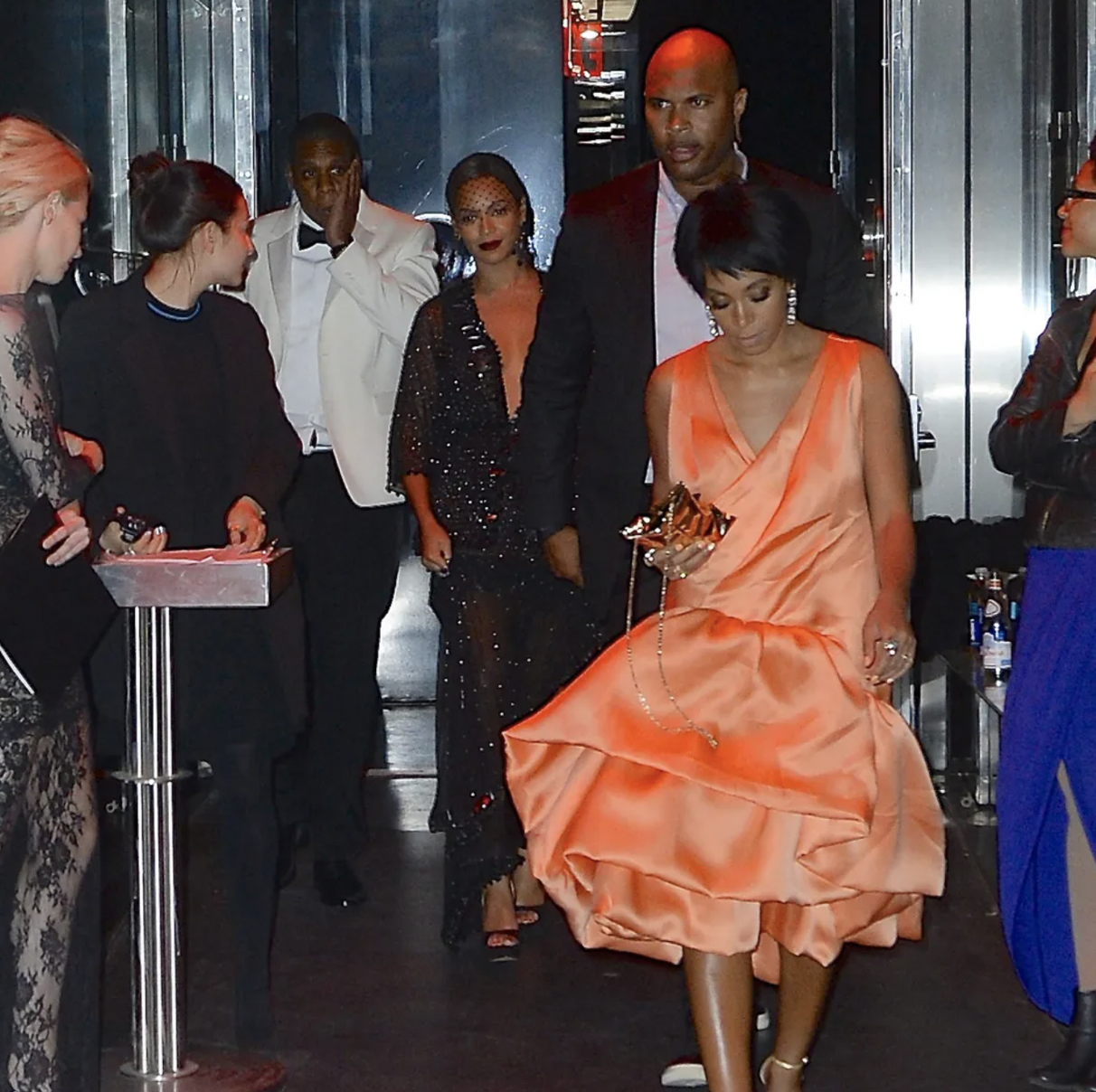
In the days after what would come to be known as “the elevator incident,” the public put forward various theories about what had happened in there. The footage had no audio and was overall pretty illegible; the only thing you could say with certainty was that Julius was an excellent multitasker, handling the whole of elevator navigation and privacy-shielding while performing his more literal bodyguard duties (if for someone other than his actual client).
Eventually, the Knowles-Carters convened for some emergency family photos, and issued a statement that admitted to tension while withholding any real details:
The most important thing is that our family has worked through it. Jay and Solange each assume their share of responsibility for what has occurred. They both acknowledge their role in this private matter that has played out in the public … At the end of the day, families have problems and we’re no different.
The statement only did so much to shut folks up, and it wouldn’t help that the months around the elevator incident saw a documented spike in rumours related to infidelity on Jay-Z’s part—beginning around the previous summer, when Beyoncé was deep in touring and production on her visual album. Plus, family anecdotes had long positioned Solange as a little sister who’d always go to bat for her older one. “We’ve always held each other down no matter what,” she’d tell an interviewer later in 2014, addressing the incident in a vague-as-possible way. “That’s something I’m drilling into Julez now.”
If anything, the saga turned out to be strangely beneficial for all three artists’ bottom lines, a fact that would lead Mathew Knowles to suggest it had been a staged “Jedi mind trick” intended to sell albums and tickets. (The Guardian advised readers—and I’d second this—to take his comments “with a pinch of salt” given that he no longer worked for his daughters, and that they hadn’t attended his recent wedding to former model Gena Avery.) It’s true, in any case, that Beyoncé would eventually wring some excellent art from the elevator incident, as we’ll get to later in this chapter and the next.
Still, during a period of her career otherwise so characterized by intentional self-produced images, there was a heavy irony to one of its most defining—and raw—having come from somewhere else.
A week after the scandal, On the Run was given a more artist-sanctioned promo spot in the form of “Run” (2014), a fake movie trailer doubling as a video for “Part II (On the Run).” Directed by Melina Matsoukas, it was—like the Carters’ forthcoming tour—co-produced by their two companies, Parkwood and Roc Nation.
In this romantic crime-thriller, Beyoncé and Jay-Z are a weapon-toting, bank-robbing, motorcycle-riding couple fighting demons while fleeing cops and gunfire. They also share the screen with a horde of Hollywood talent perhaps more likely to appear in a movie of this kind: Sean Penn, Don Cheadle, Blake Lively, Jake Gyllenhaal, Emmy Rossum, Guillermo Díaz, and Rashida and Kidada Jones.
As far as what’s gleanable from the trailer, the story being told matches that of the song: the Carters are head over heels yet troubled in ambiguous terms, and they can’t seem to trust everyone in their orbit. “What happens when it hits the fan?” Blake Lively’s character asks Beyoncé’s, to which she tearfully responds, “I love him.” We then hear Sean Penn’s character tell Jay-Z’s, “You’re gonna get that little girl hurt, too.” (That Sean Penn was once married to Madonna is most likely a coincidence, though it’s interesting that the trailer also builds in a stretch of Jay-Z’s 2003 song “Justify My Thug, which samples Madonna’s similarly-titled one.)
When we reach the credits, which clarify that this movie is “COMING NEVER,” we hear Beyoncé’s vocals from the opening of “Part II (On the Run)”: “Who wants that perfect love story anyway? Cliché, cliché, cliché, cliché.”
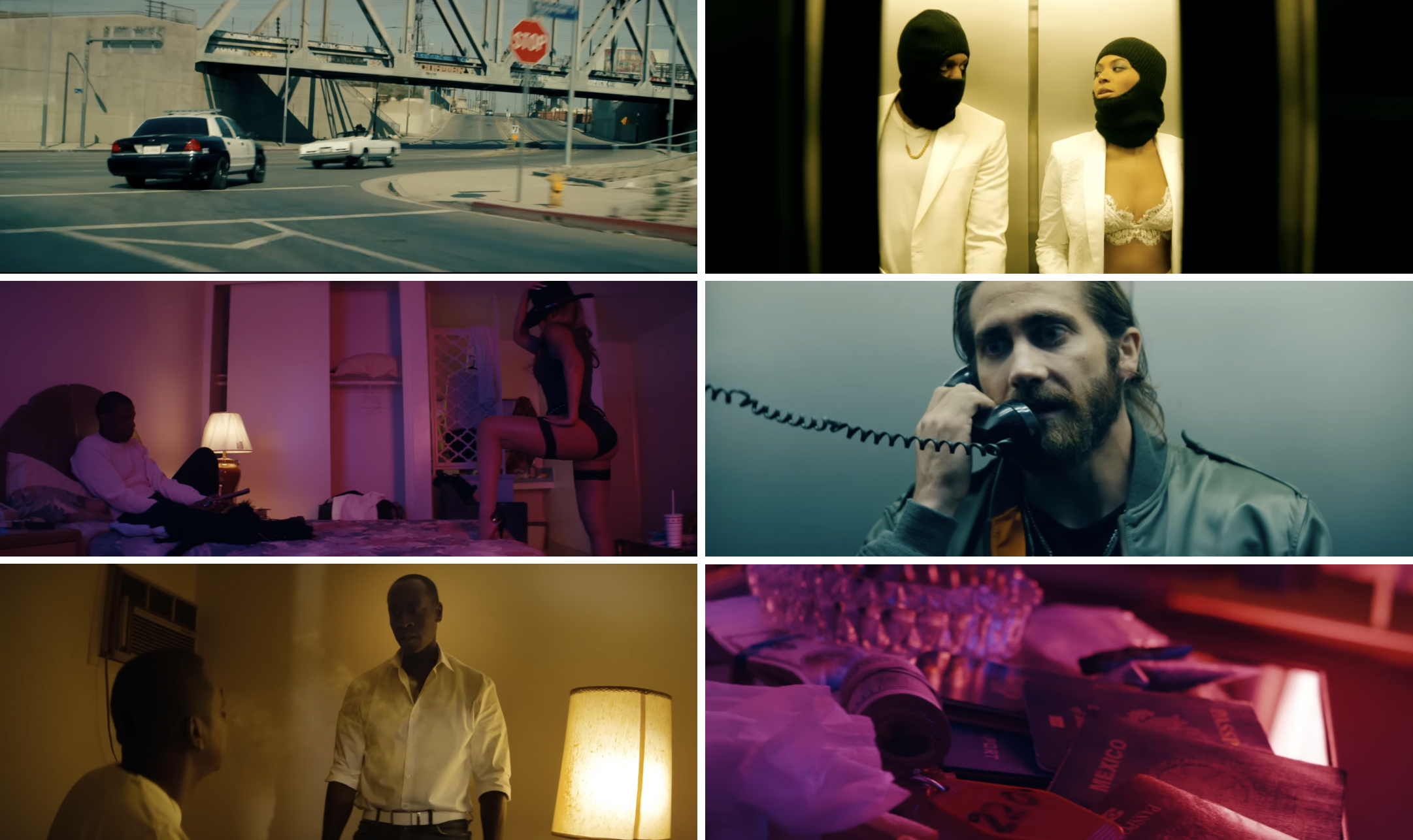
“They had this vision,” Lee Anne Callahan-Longo has explained of the tour concept. “They wanted it to be a cinematic adventure.” There was an ever-growing sense around this period, if you ask me, that Beyoncé could create those just fine without the backing of the film industry proper.
The trailer built out the narrative and tone of On the Run, and in a way that didn’t necessarily clash with what the world had watched take place in that elevator—They ain’t see potential in me, girl, but you see it / If it’s me and you against the world, then so be it. And in some ways, the Carters’ artistic brands had never leaned so hard on being each other’s spouses. It’s one thing to walk an occasional red carpet with someone, or write the odd song about them, or cameo in one of their projects; it’s another to share the stage for a two-and-a-half-hour live show whose entire premise is your ‘imperfect’ love story. This was loud, dedicated, collaborative lore creation from a notoriously private husband and wife.
In the lead-up to the tour, director and photographer Dikayl Rimmasch was hired to make a series of on-theme shorts starring the famous couple, eventually integrated into its video content. Rimmasch had apparently been introduced to the Carters by video legend Mark Romanek, who’d not yet worked with Beyoncé but was a longtime collaborator of Jay-Z’s, having directed both “99 Problems” (2004) and Picasso Baby: A Performance Art Film (2013).
“We’re not trying to do this literally,” the rapper is said to have told Rimmasch over the phone. “It’s not that we’re Bonnie and Clyde. We’re on the run from everything. On the run from becoming a cliché. On the run from doing the same thing again.” With this in mind, the shorts would channel an eclectic mix of films that had somehow been made non-traditionally: French New Wave projects like Jean-Luc Godard’s Breathless (1960), the work of cinéma vérité filmmakers like D.A. Pennebaker and Richard Leacock and Les Blank, and low-budget Westerns like Sam Peckinpah’s Bring Me the Head of Alfredo Garcia (1974).
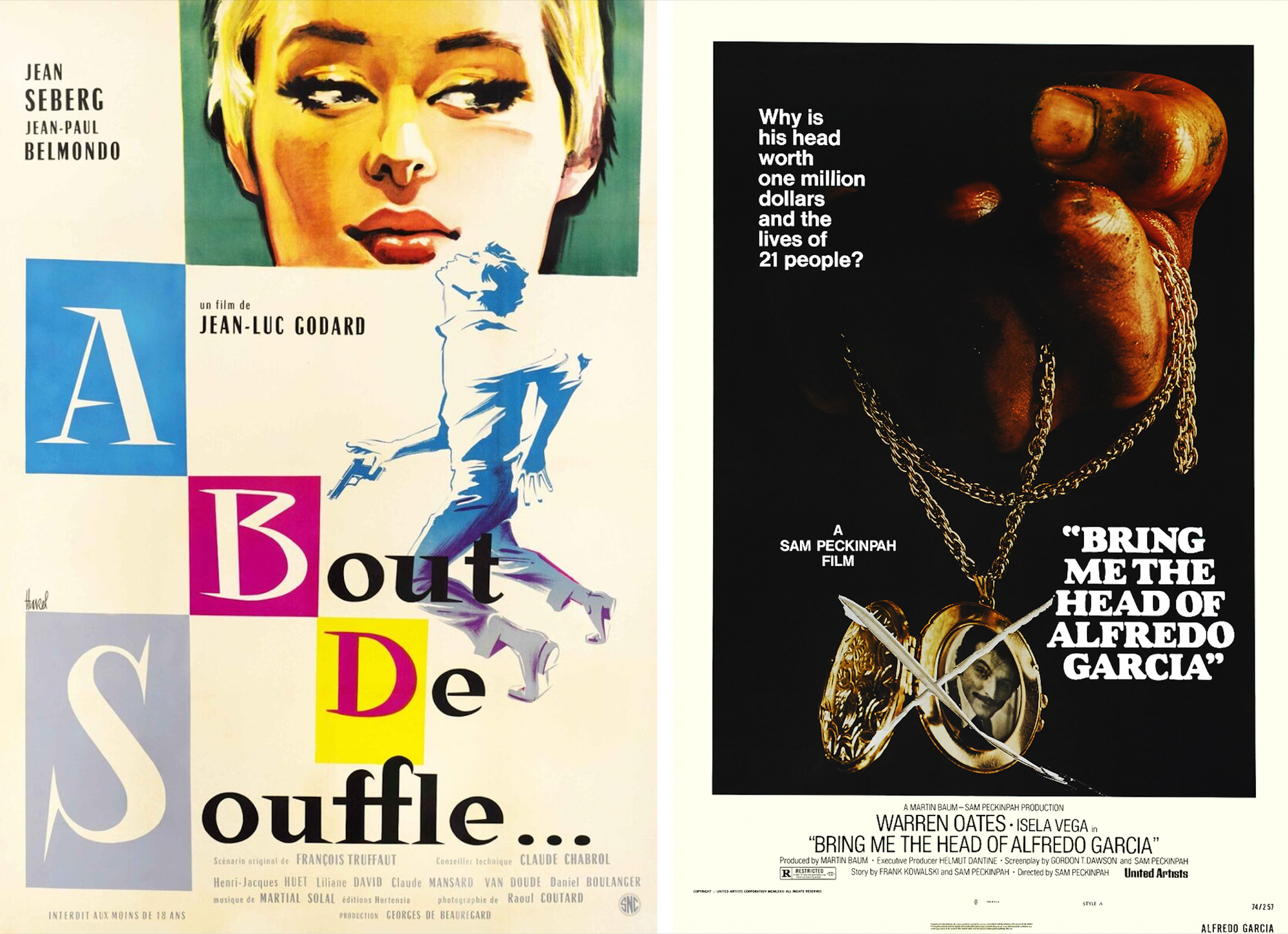
“Ed Burke puts these shows together and he was really supportive of what I was doing and key in masterminding how this whole thing got executed,” Rimmasch would say of Parkwood’s visual director. “I knew what the chemistry had to be between myself and [the Carters]. But behind me were a few bulldozers pushing things. One was the production that was very well organized and the other was the tenacity of Ed Burke just saying, ‘Do it.’”
On the Run officially kicked off in Miami at the end of June, around which time the couple released a three-minute look at their whirlwind tour rehearsals. (The version below has been slightly edited to advertise their two concluding Paris shows in September, the only non-North American stops.)
“We look at this as one family—one crew, one band,” we hear someone say, and the comment is borne out by footage of the Carters and their teams all sharing the frame as they put the show together (not that we see an equal amount of athleticism required of each). The idea that this is a family affair is underscored by glimpses of the famous duo stealing a quick hug or holding hands while they rehearse; at the end of the clip, their toddler applauds as she tells everyone, “Good job!”
“It sets them up like, Oh, this is different,” another team member explains of what appears to be the video content. “This is something we gotta pay attention to. We gotta take in all the elements that exist; it’s not just music.” And with Beyoncé, I’d argue that it scarcely is.
The same week as the tour began, in an interesting moment of Mrs. Carter straddling two moments at once, HBO began airing a series called Beyoncé: X10 (2014), ten performance sequences from her just-wrapped solo tour that would play before new episodes of True Blood. Directed by Ed Burke, the special runs for about 45 minutes if you watch its pieces sequentially (as you’d eventually be able to do on DVD).
Seven out of ten numbers here were songs from BEYONCÉ, meaning that the tour was largely being immortalized by its final few months, when the star was a platinum blonde and the creative direction completely matched that of her visual album (rather than anticipating it as accurately as possible). In the “Blow” segment, which samples Prince’s “Sexy Dancer,” the main dance prop is the “Big Spender” bar from Sweet Charity (1969), which Beyoncé had been fond of since her debut solo headlining tour. “Partition” pulled directly from the song’s music video, which is to say the Crazy Horse stage, down to the elaborate body projections and custom striptease couch. “Drunk in Love” included Jay-Z’s verse, and therefore edited together his surprise appearances on the Mrs. Carter Show.
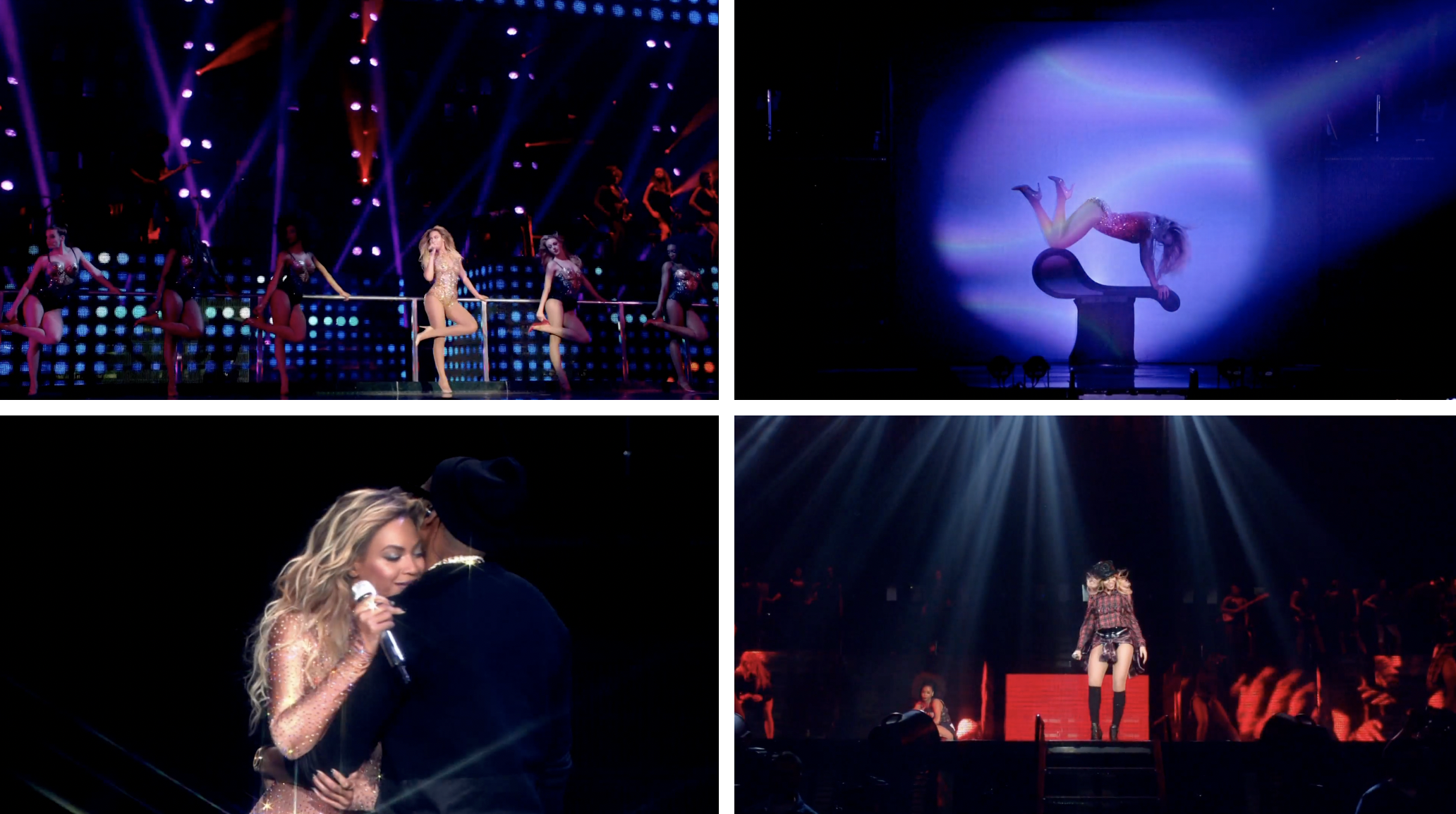
Though Beyoncé: X10 isn’t a concert film in the traditional sense, it’s completely in keeping with the style Beyoncé has become known for with such projects—maximalist editing, a fair amount of slow-motion, and plenty of footage shot on film (or at least edited to appear like it was). As far as I can tell, it also happens to be where she initially experimented with what’s since become another of her live filmmaking trademarks.
When I wrote about I Am… World Tour in Vol. II, I mentioned that it was the first time we’d seen her openly edit different shows together, labelling many shots with their city. Beyoncé: X10 took this idea a crucial step further: at several points, we don’t just match-cut from show to show—and it’s always clear when we’ve done so, since the star’s costume will change before our eyes—but the camera has sometimes been stationed in the exact same place across various nights. The result is that our POV remains totally static even as we jump between four different shows in a matter of seconds.
This was a trick that would later go viral when Beyoncé used it to maximum effect in Homecoming, and would eventually be one of the more mesmerizing aspects of Renaissance, but she started toying with it here in 2014, where it’s probably most on display during the “Drunk in Love” and “Run the World” sequences.
With each of these entries in her filmography, the idea is perhaps the same: standing onstage many months away from the release of a concert film, Beyoncé and her team have already discussed how it’ll be edited. And implicitly, the effect doubles as a flex of constancy and stamina over the course of a live run.
There’s a second aspect of Beyoncé: X10 that foreshadows later projects: the black-and-white doc interludes spliced between certain numbers, about a minute long apiece. In place of something like a talking head, these six segments are narrated by the star in that intimate voiceover she’d been coming back to on and off for years.
These interludes are revealing in their own way—a mix of new information and new spins on older information. In one, she tells us that she was happy to spend her teens dancing while her peers partied and fooled around with their boyfriends; in another, she reminds us that she likes to paint, explaining that she especially loves setting something beautiful to canvas and then “fucking it up”; in yet another, which plays before “Partition,” she says that there’s nothing sexier to her than exclusivity. Noted!
Beyoncé: X10 wraps up with “XO,” the number where we spend the least amount of time onstage. Instead, we see shots of her audiences and extracurriculars around the world, marked with their location as in I Am… World Tour. We also get a dash of recent home-video footage, like Blue blowing out her second birthday candles. As the song reaches its outro, Beyoncé narrates, “I think once you realize the thing that makes you passionate, and the thing that makes you stay up at night, the things that you will fight for—once you realize those things and you’re working towards that, it’s pretty much having it all.”
Not atypically, the star was talking around something. What exactly would she fight for? What was she working towards? She’d answer those questions, if in her customarily controlled way, in the months and years to come. ●
You can read the second half of Vol. III here.
Mononym Mythology is a newsletter by me, Sydney Urbanek, where I write about various intersections of popular music and moving images. If you got something out of this issue, feel free to share it with a friend or cover one of the caffeinated beverages I’ll need to finish the next issue. You can reply directly to this if you received it in your inbox, and otherwise my email is here. I’m also on X and Instagram.

